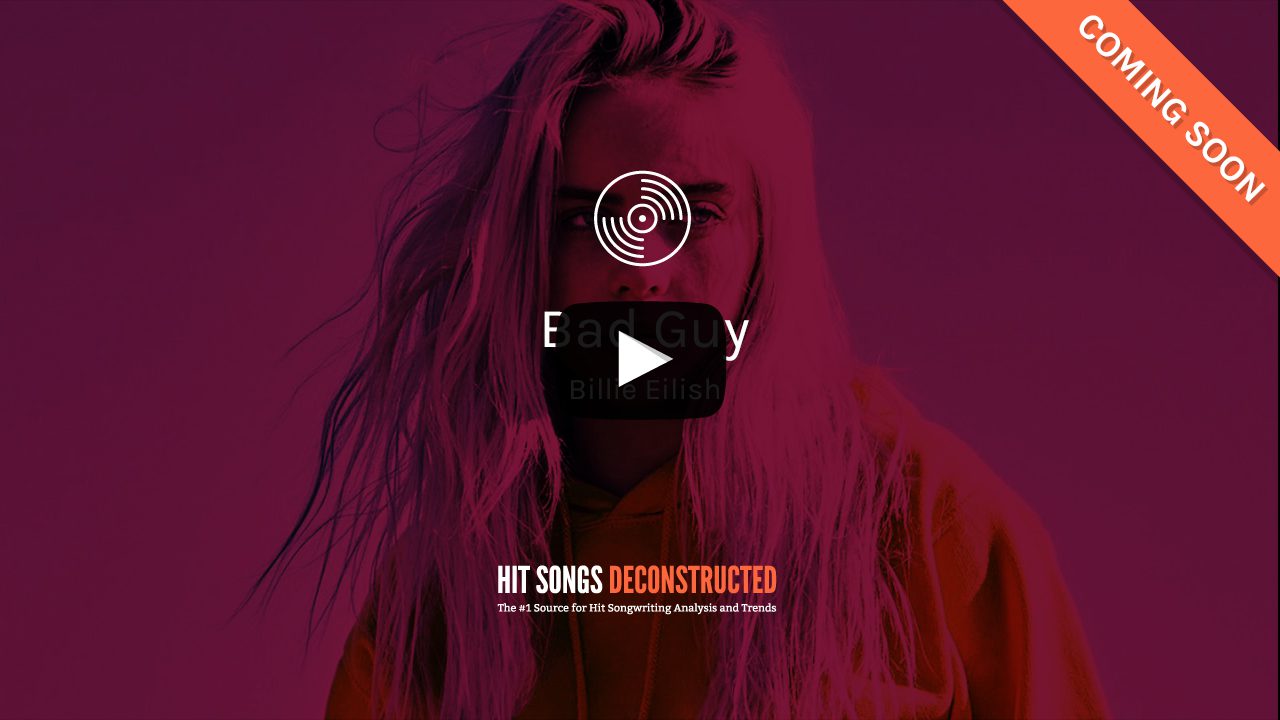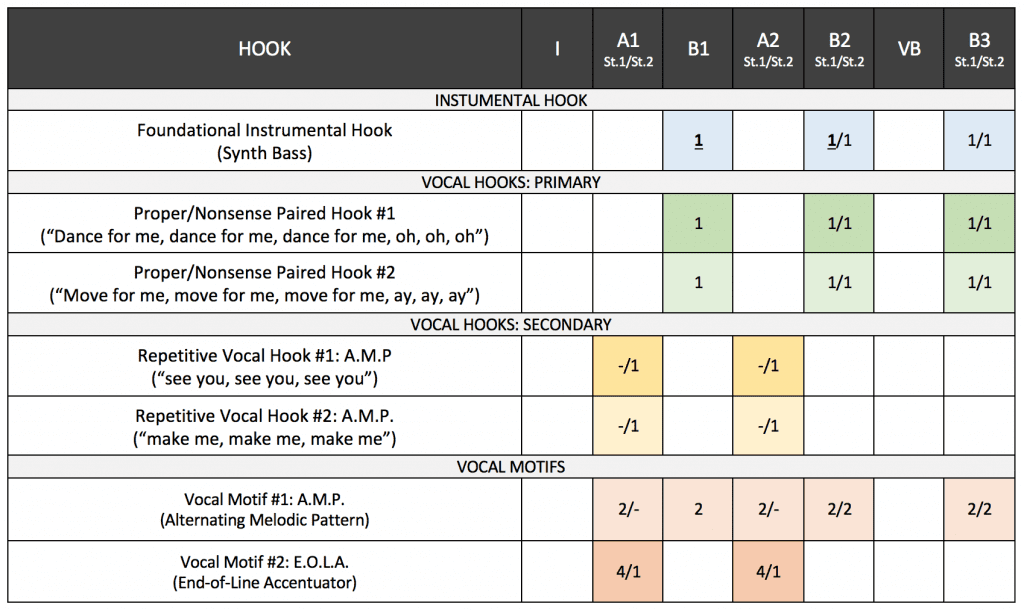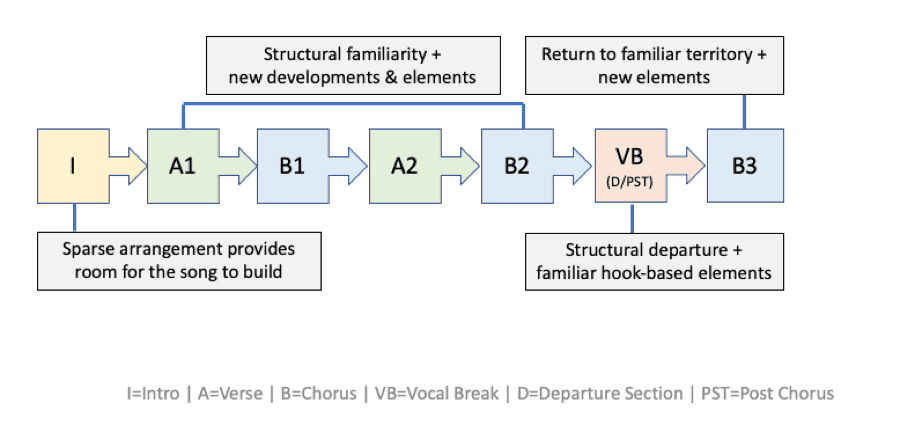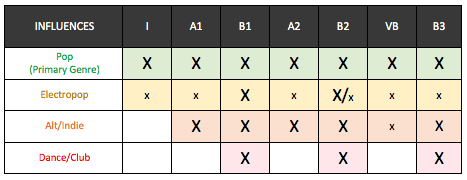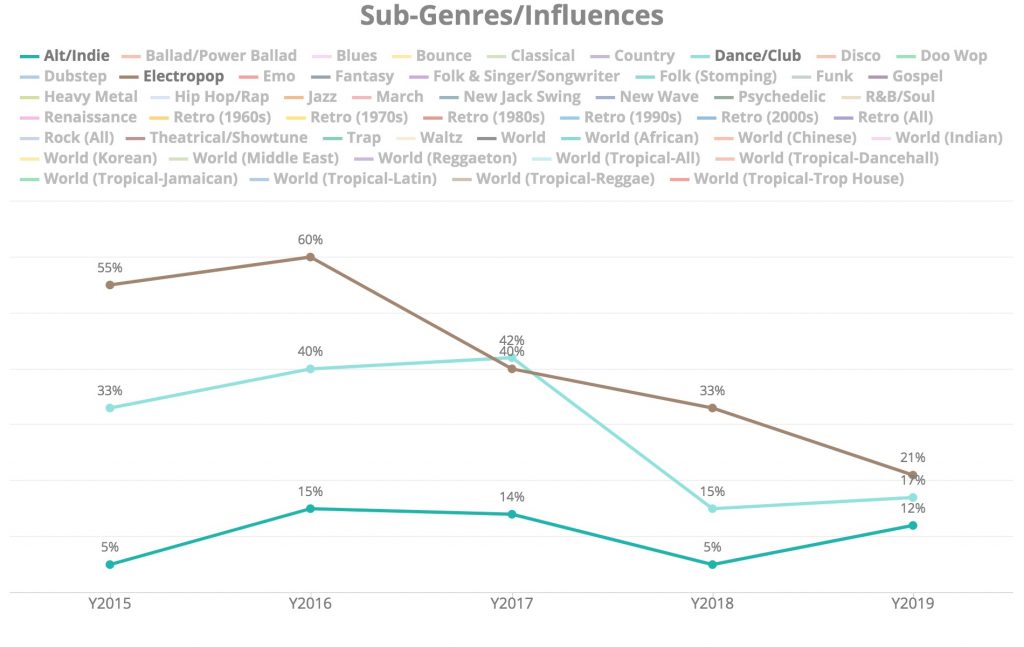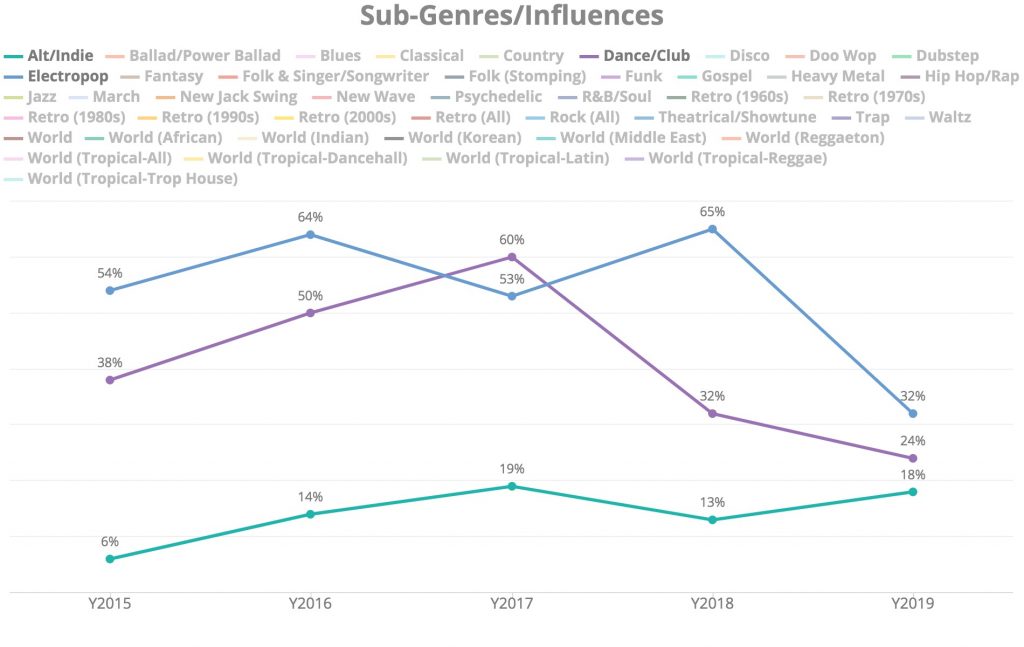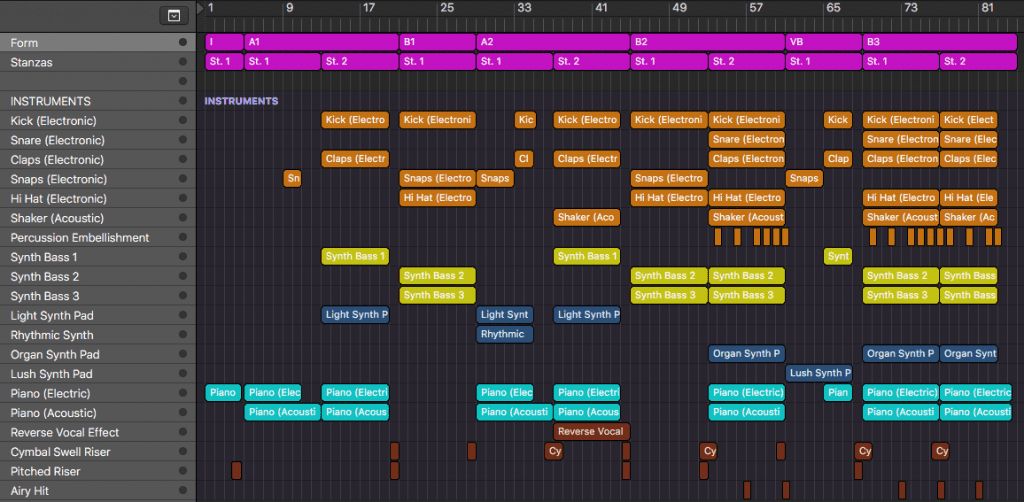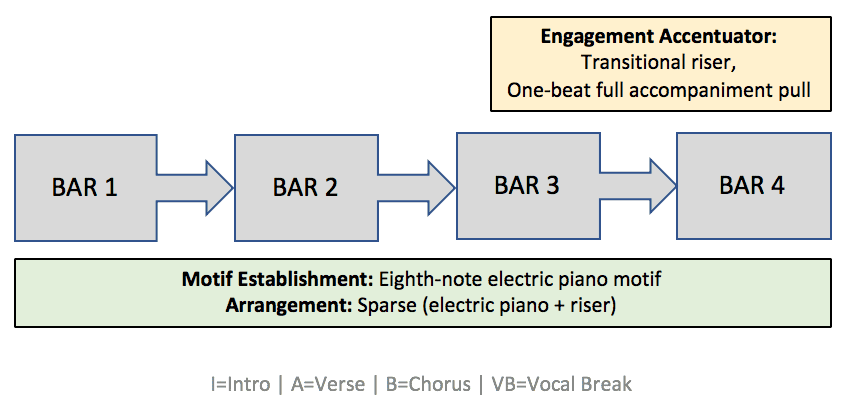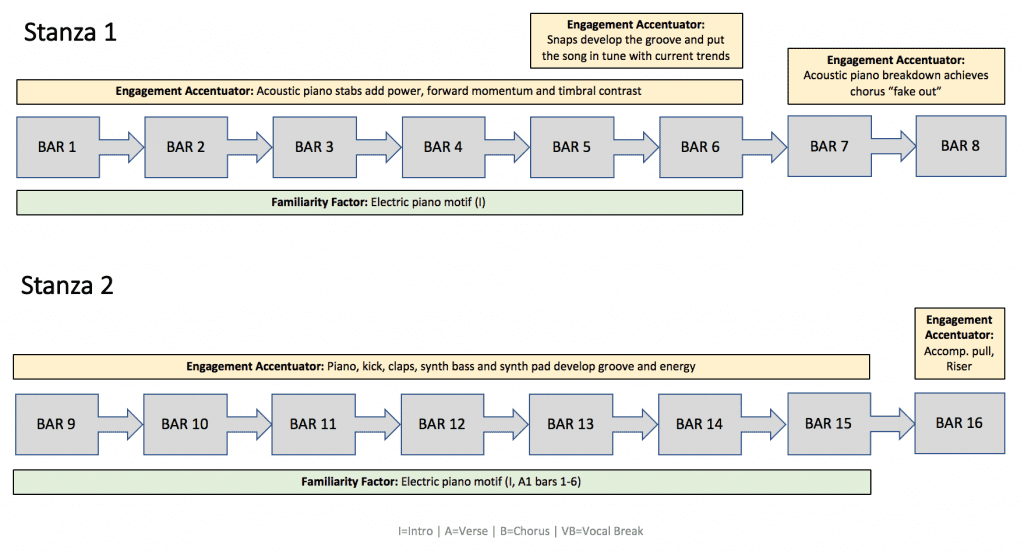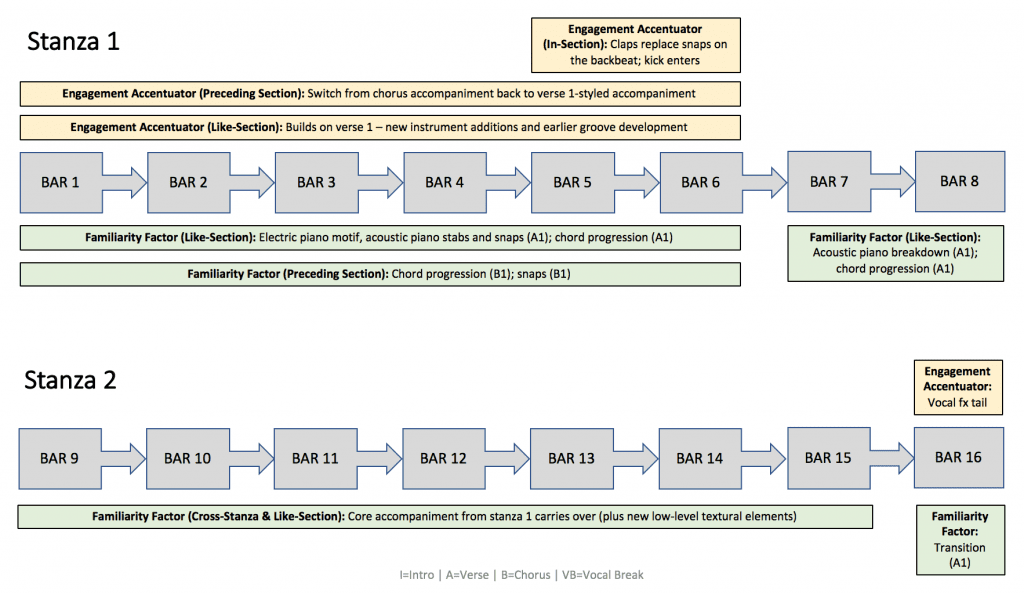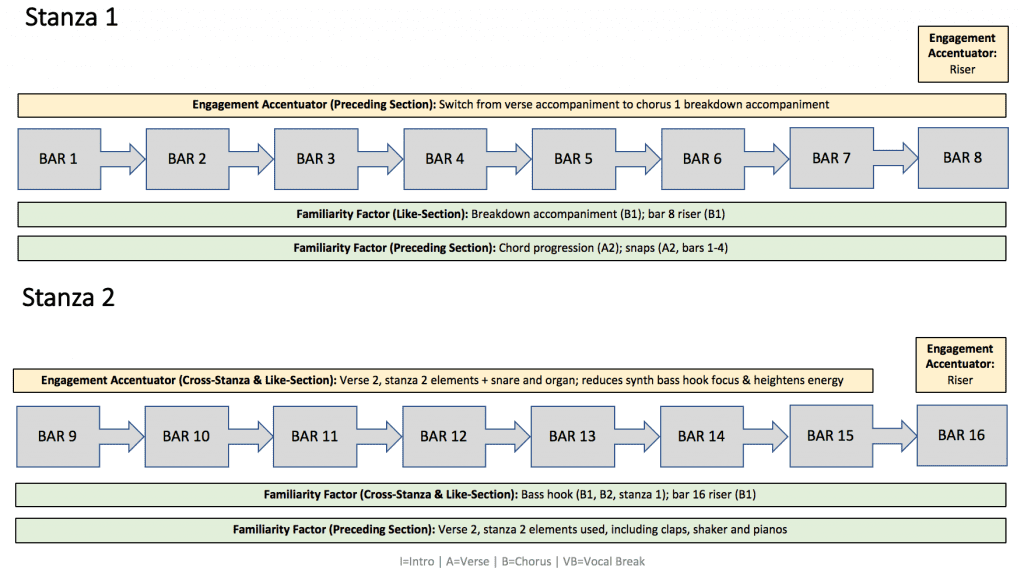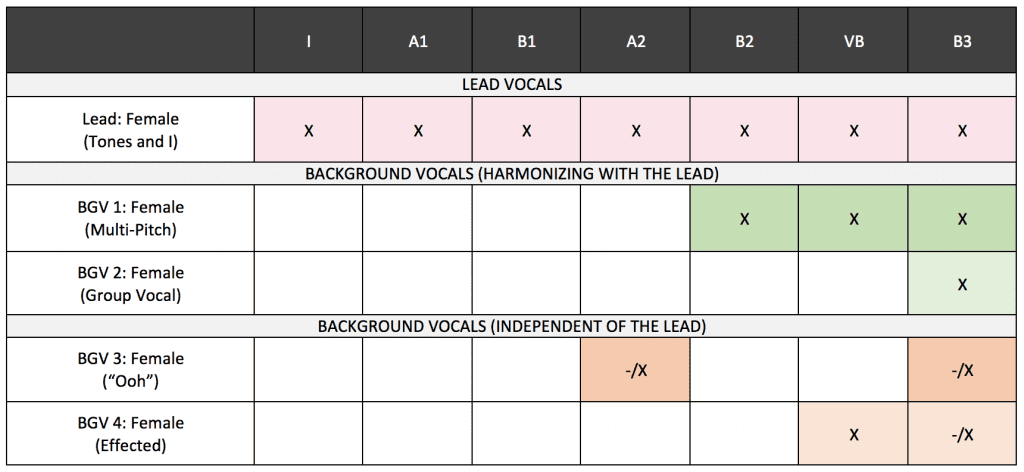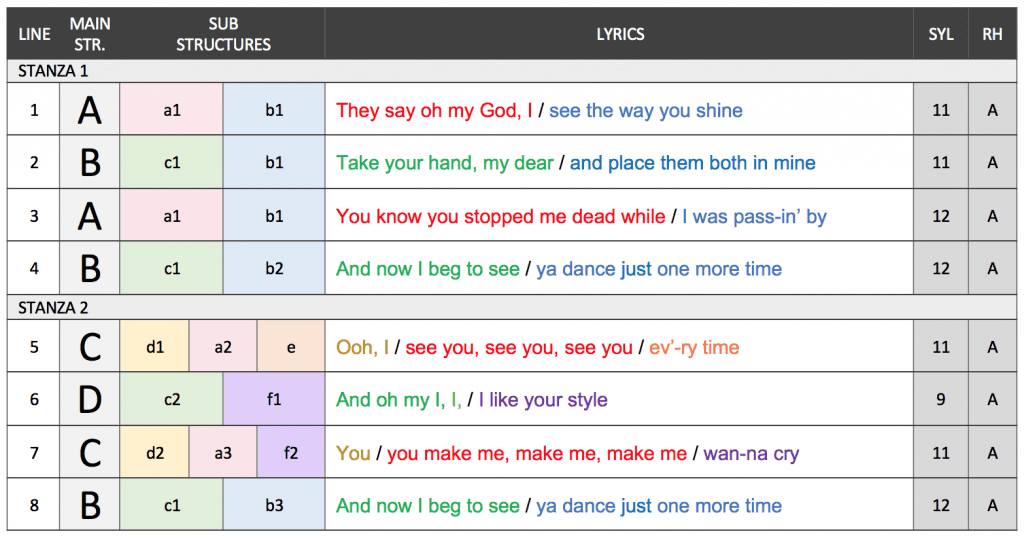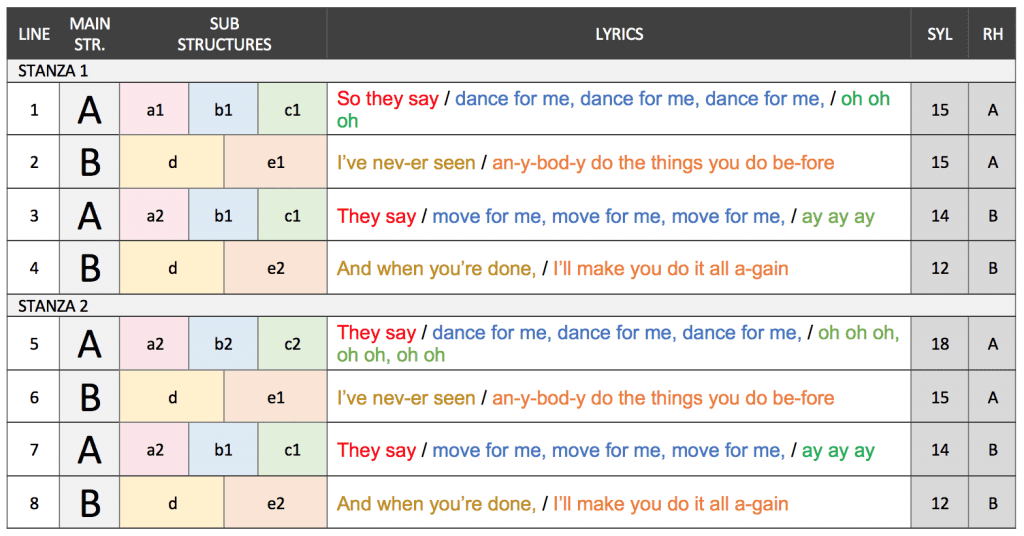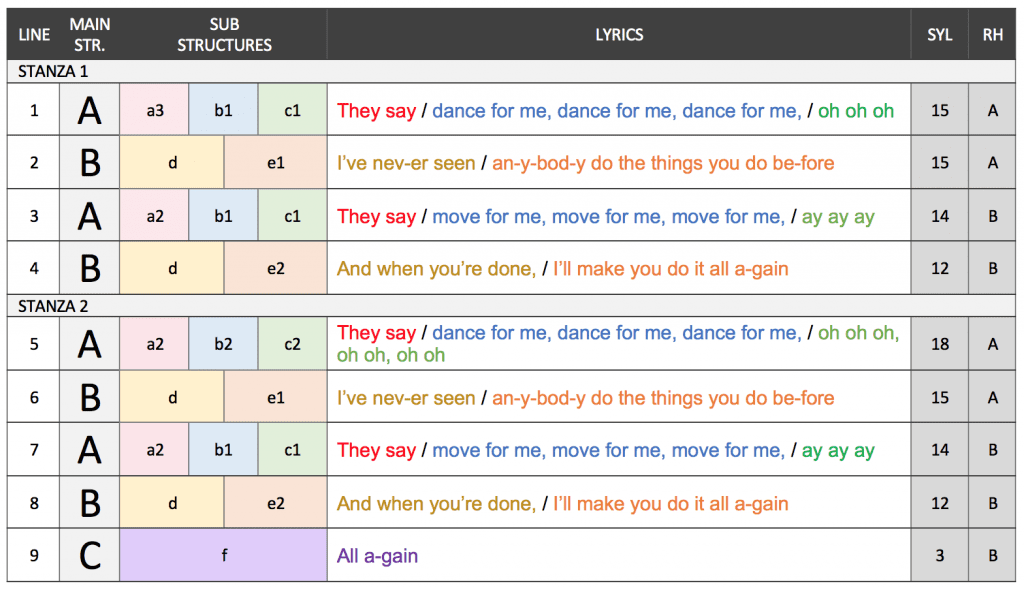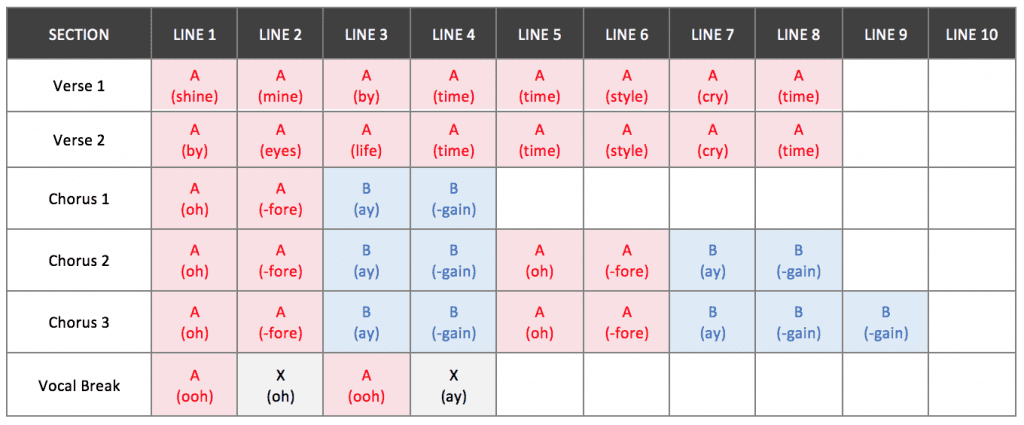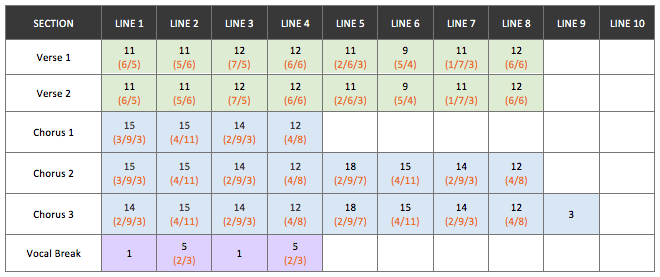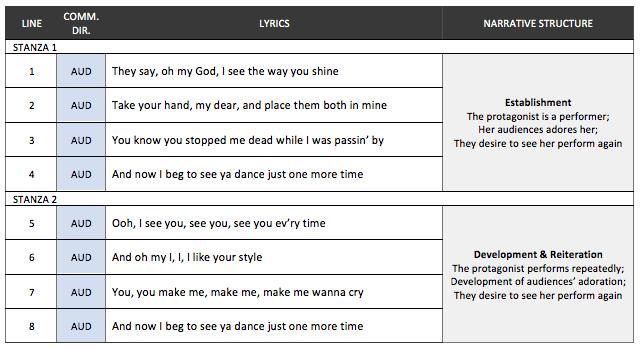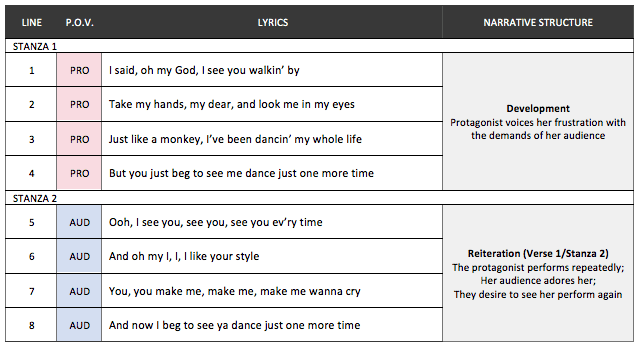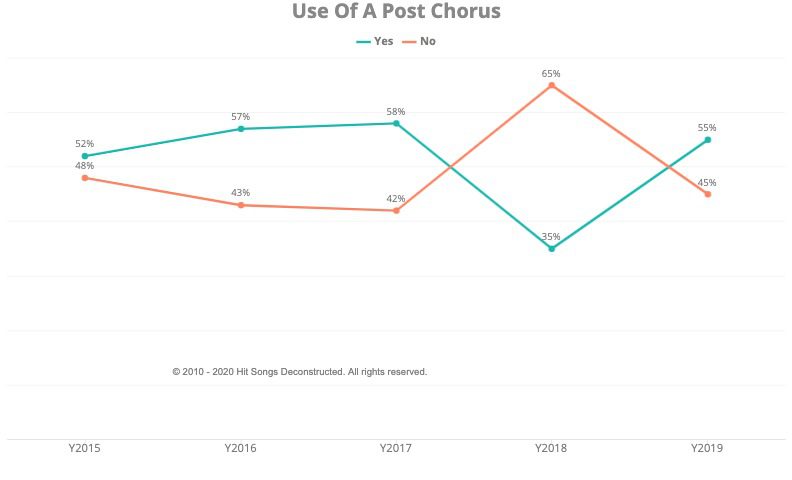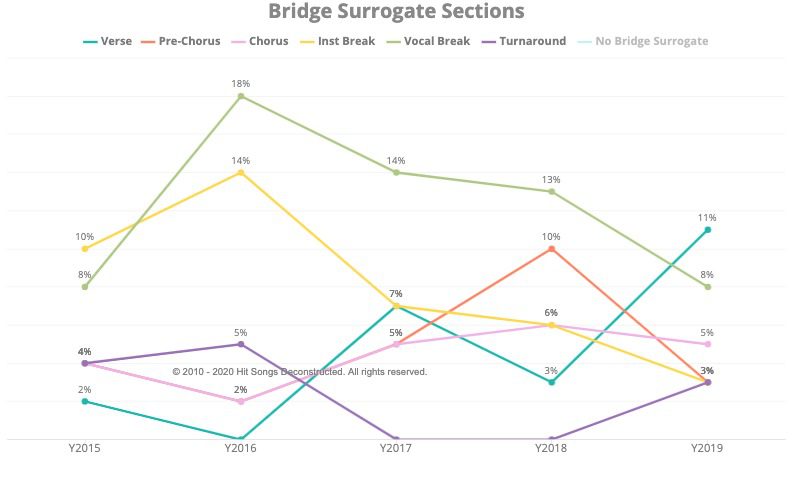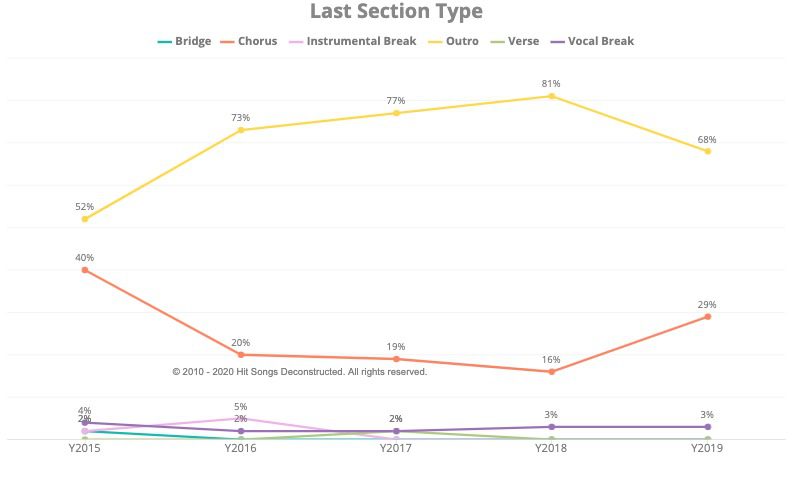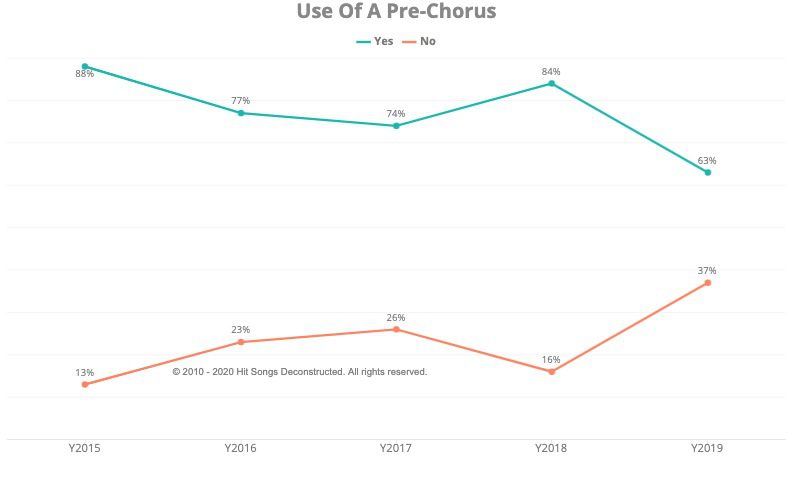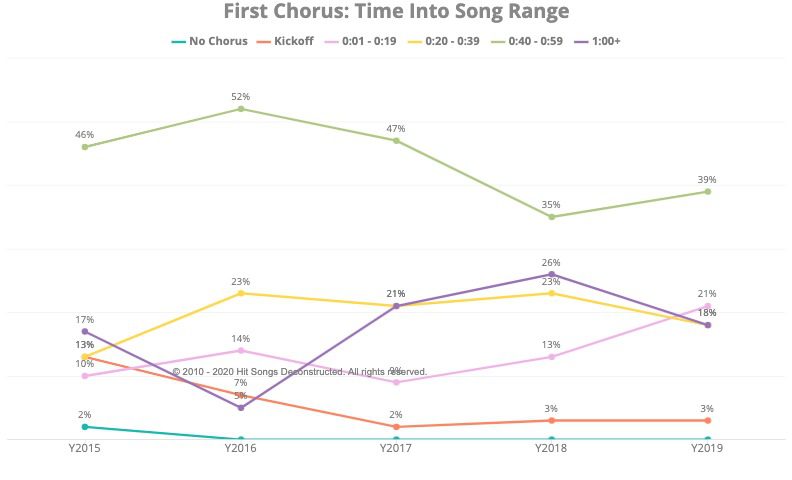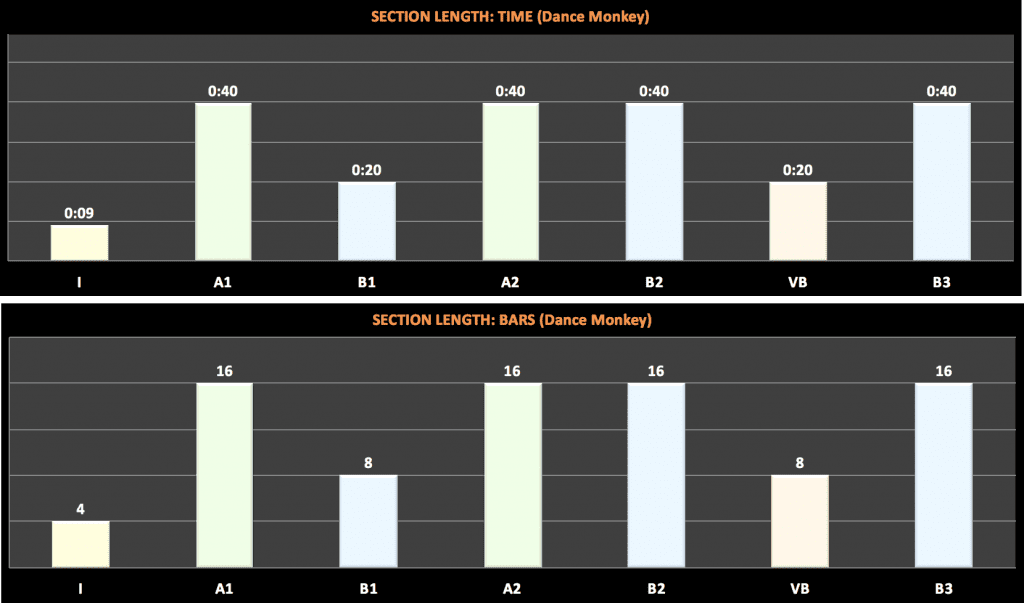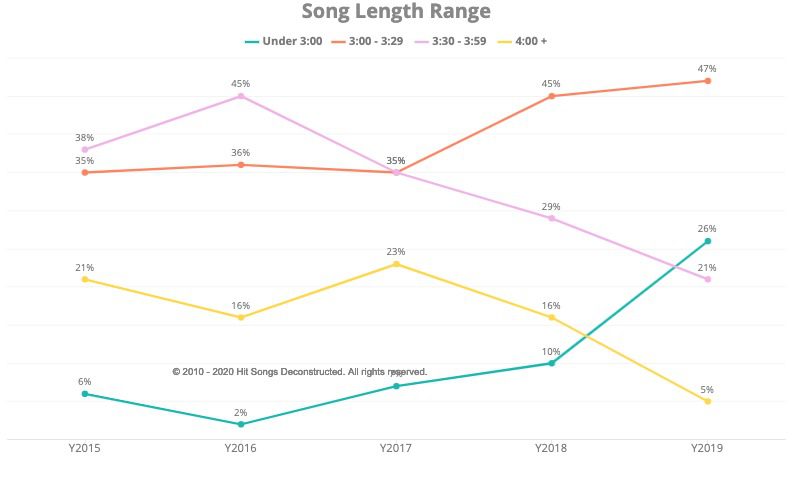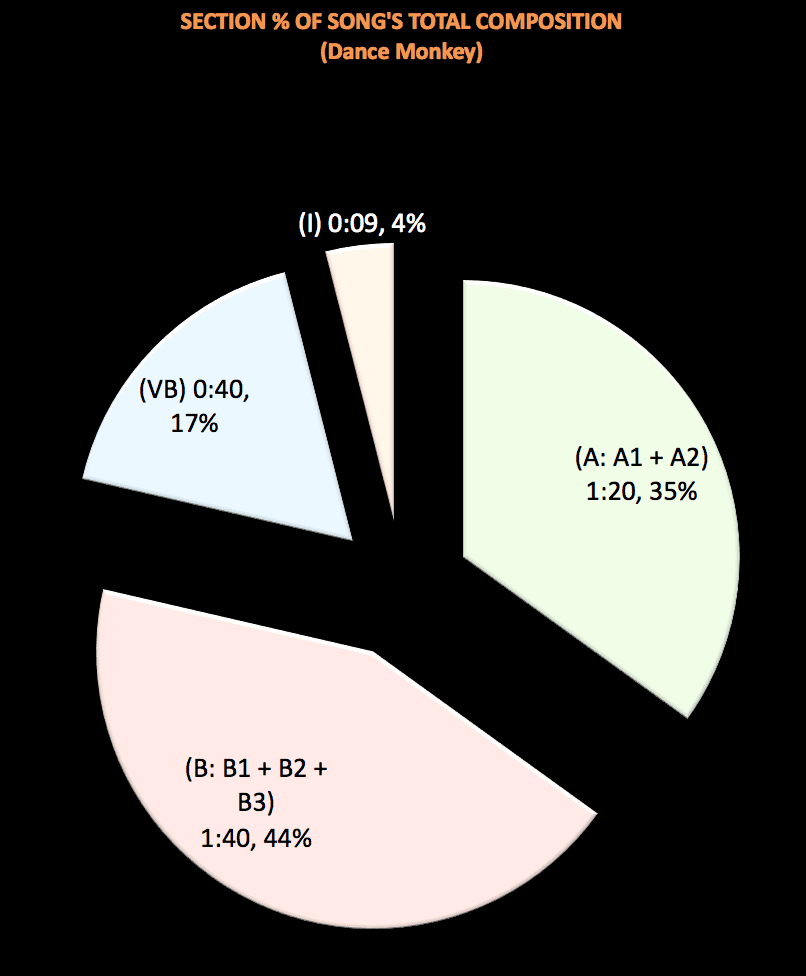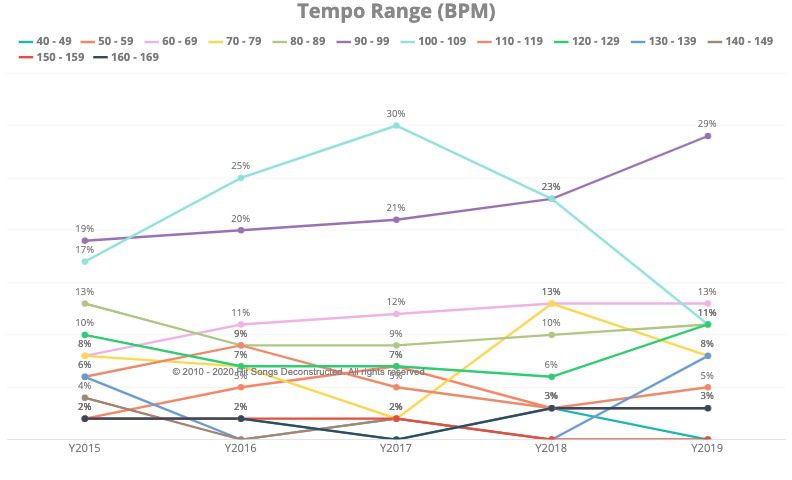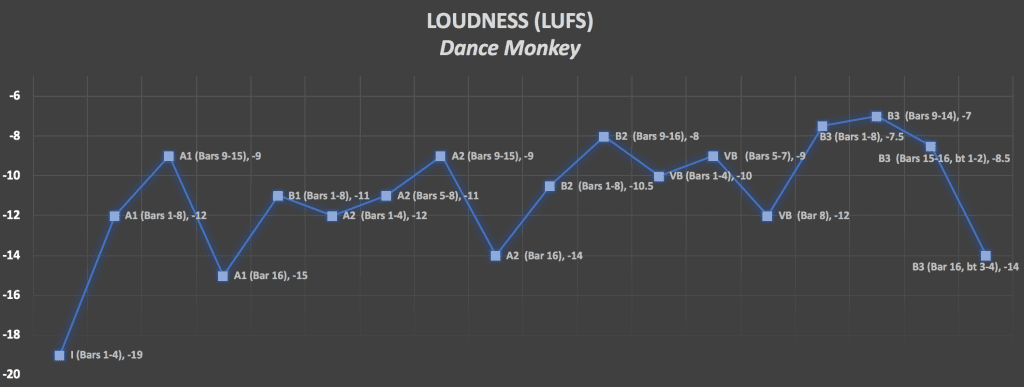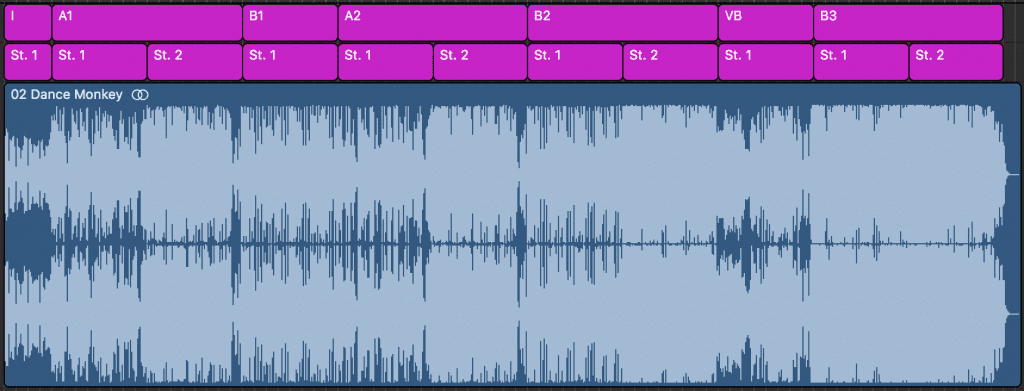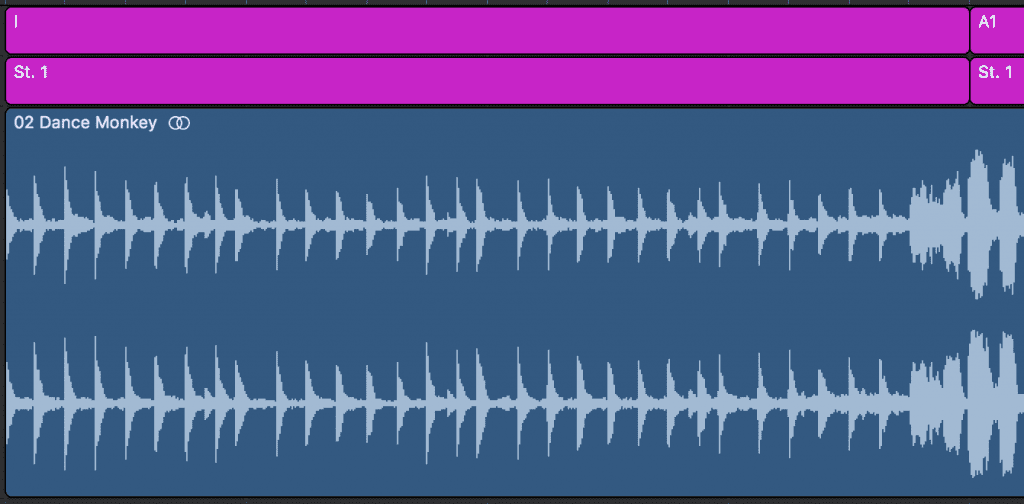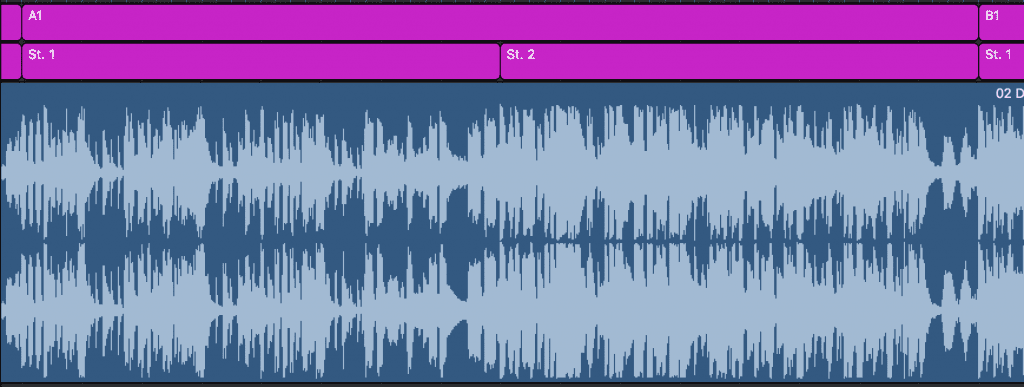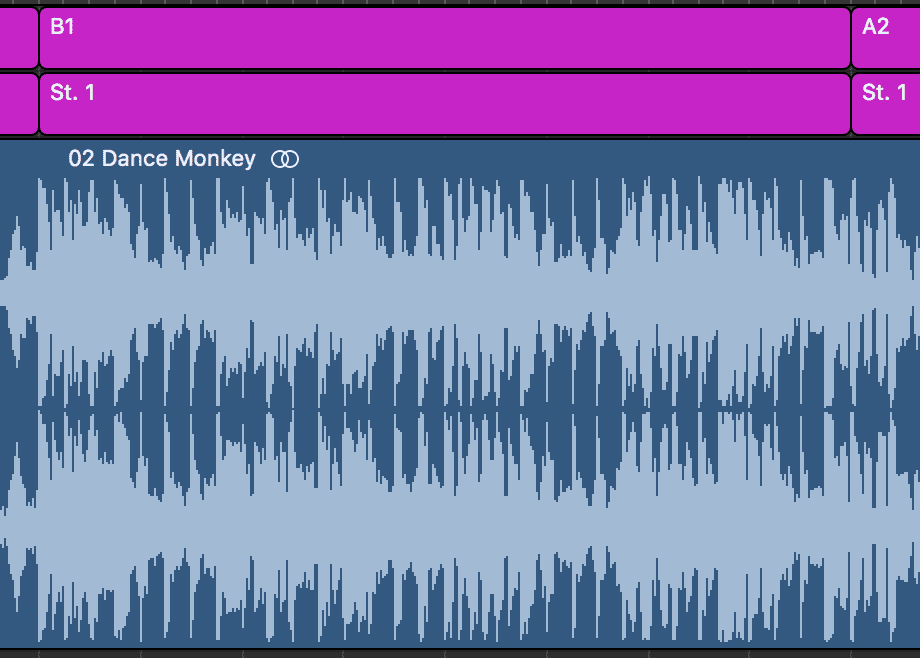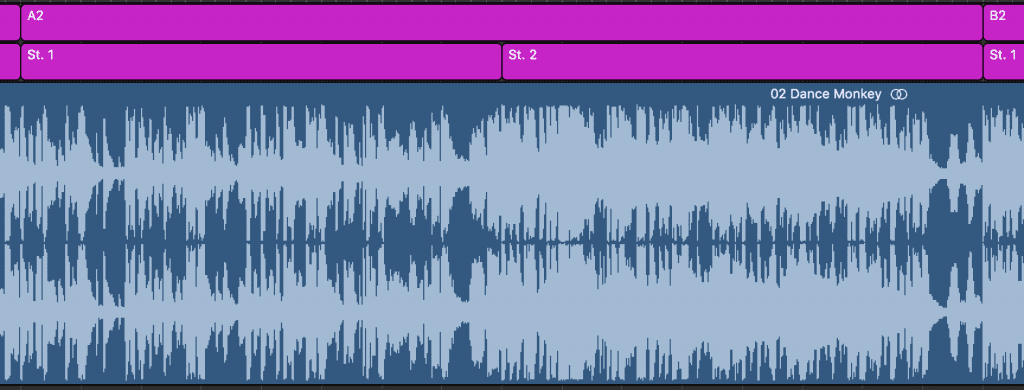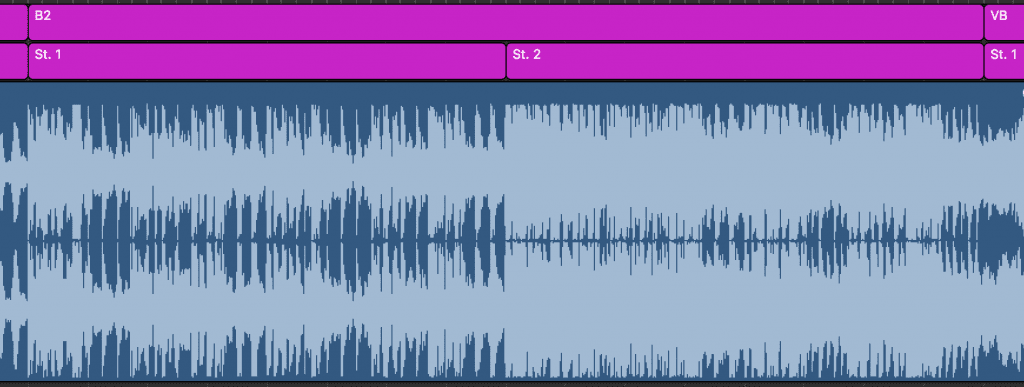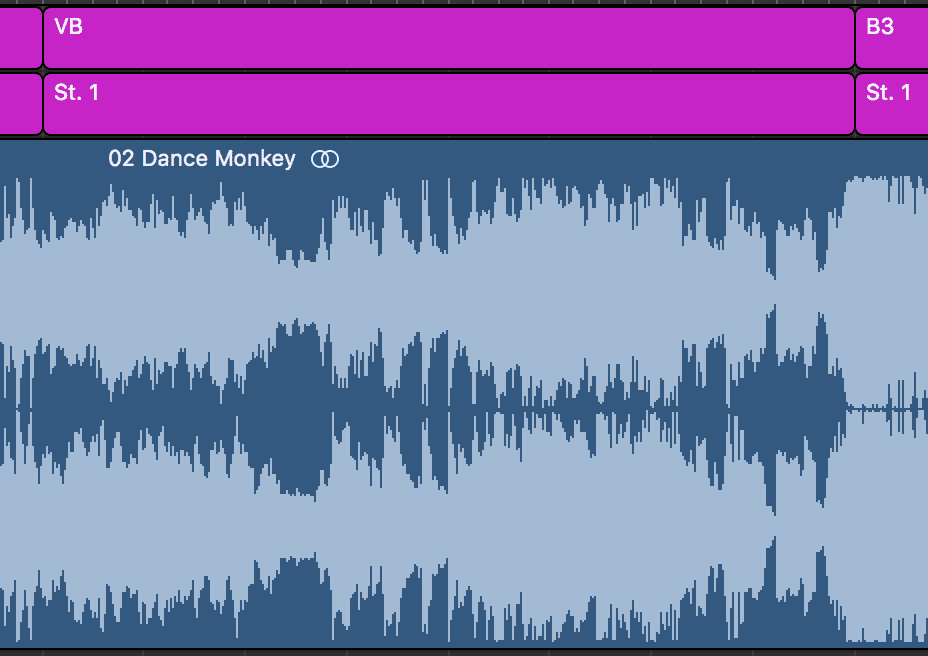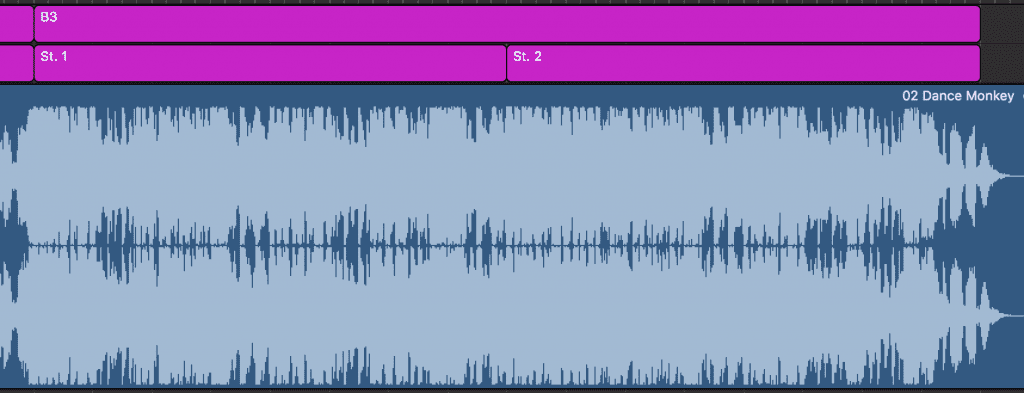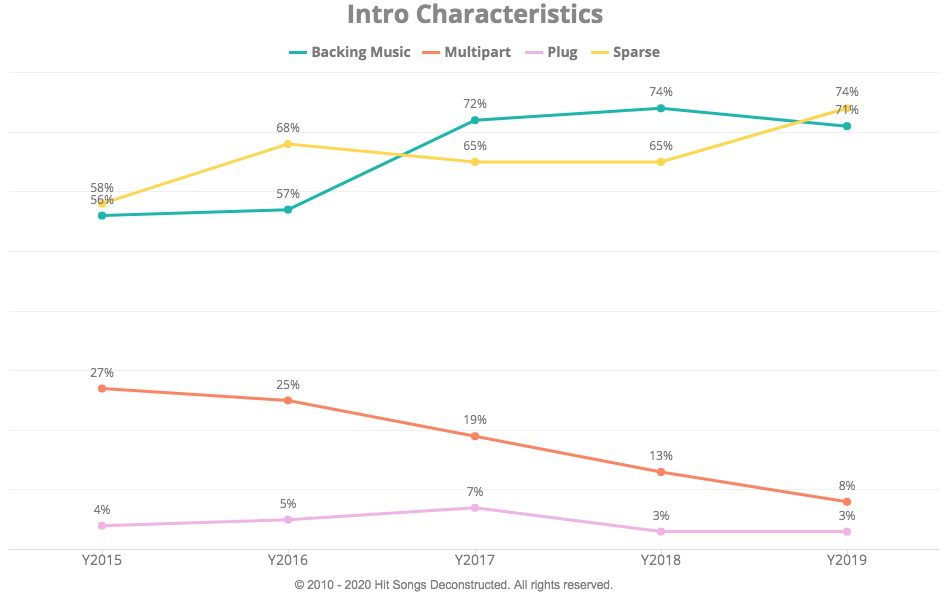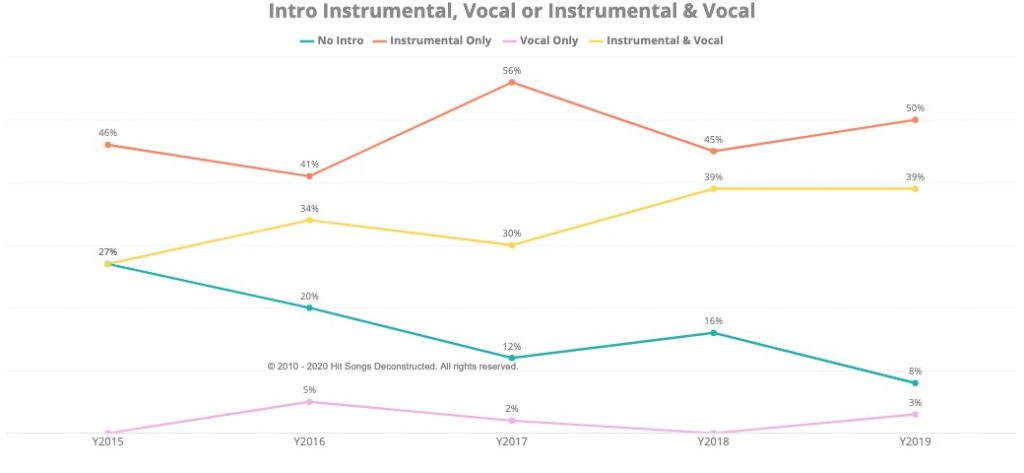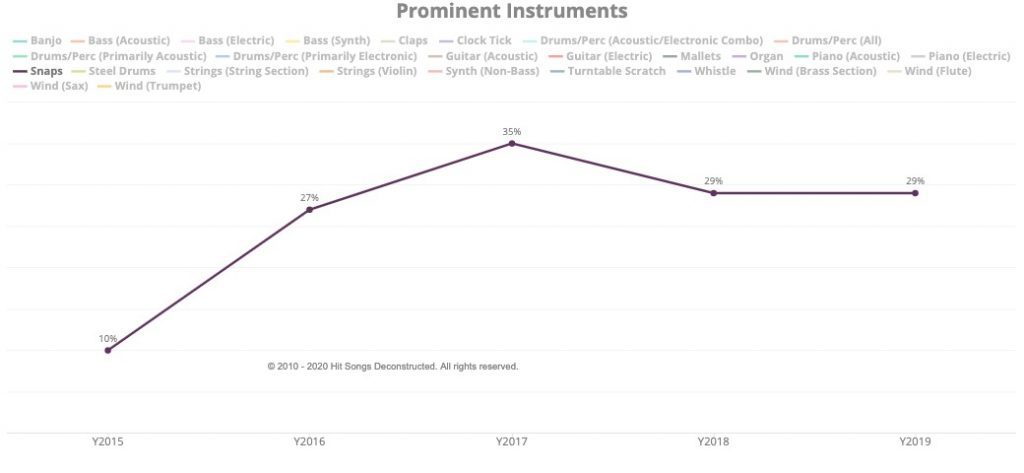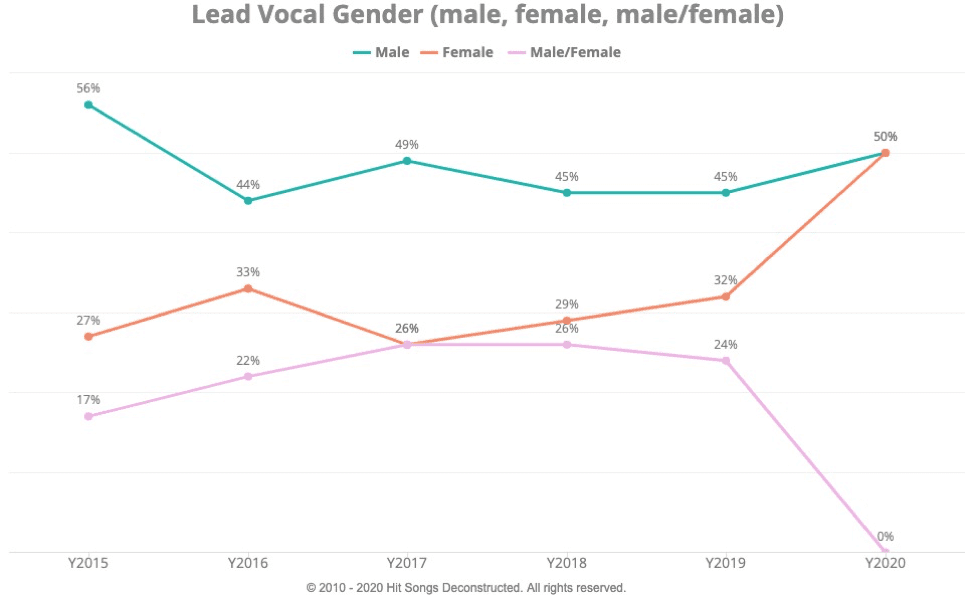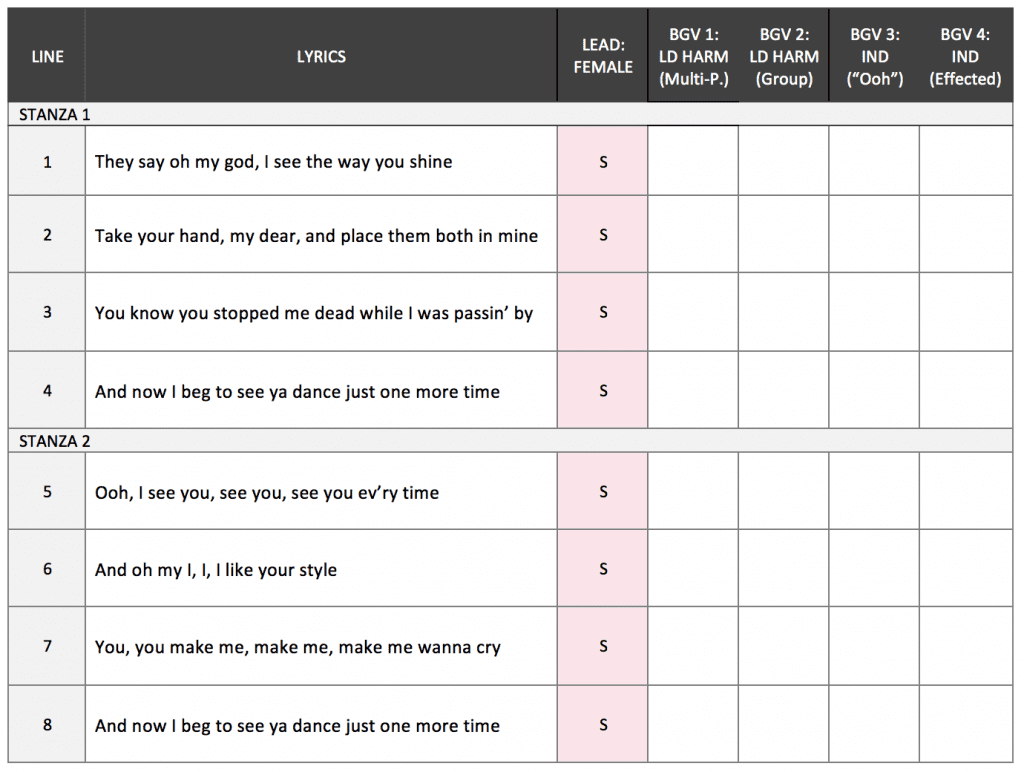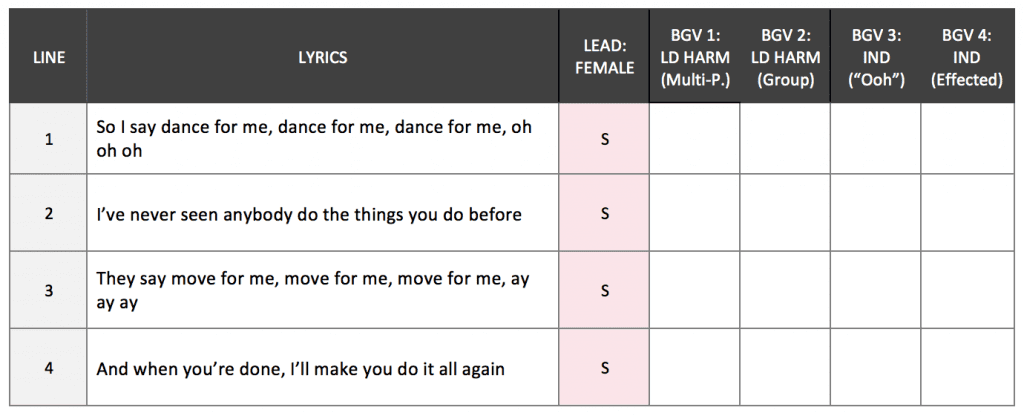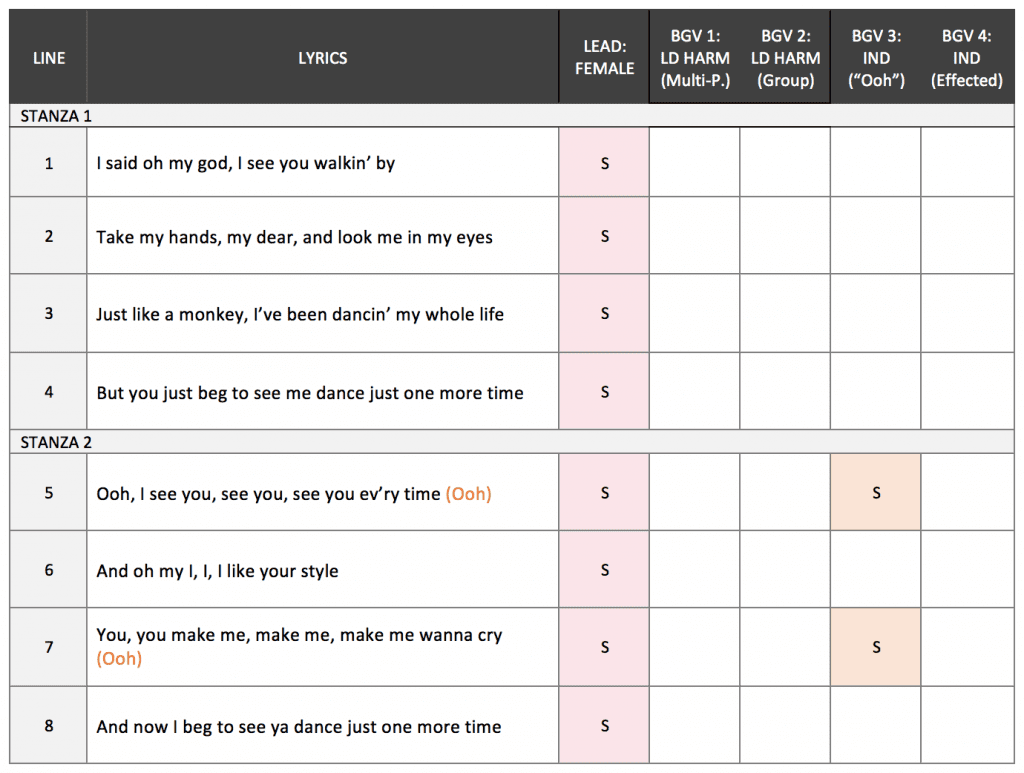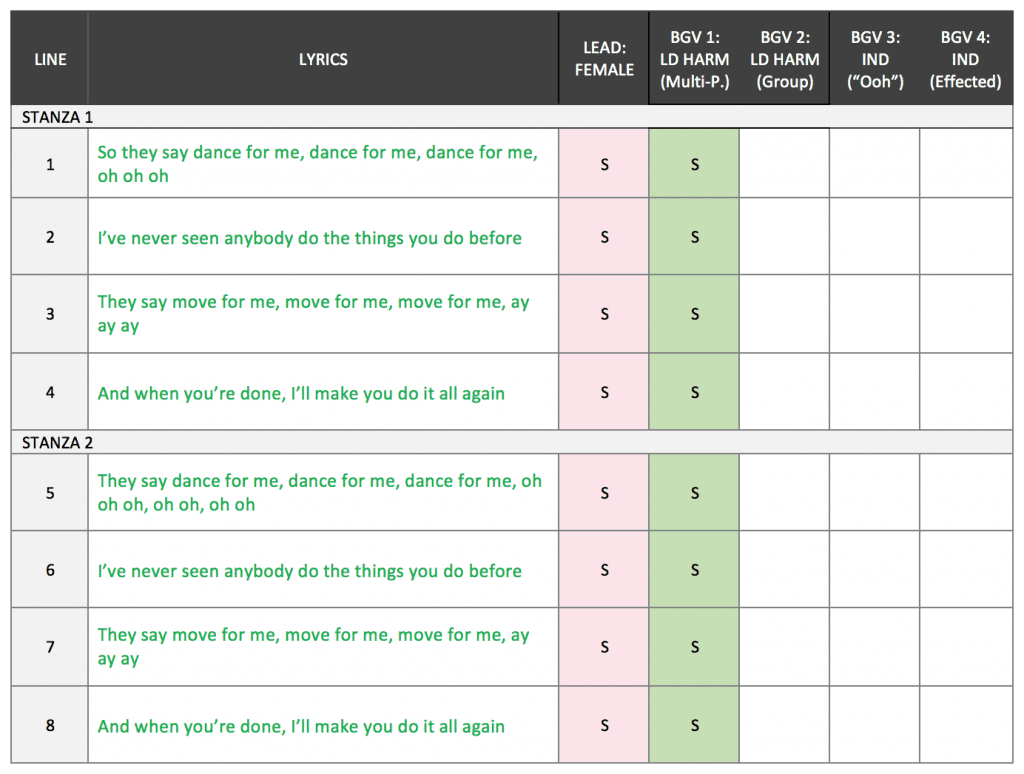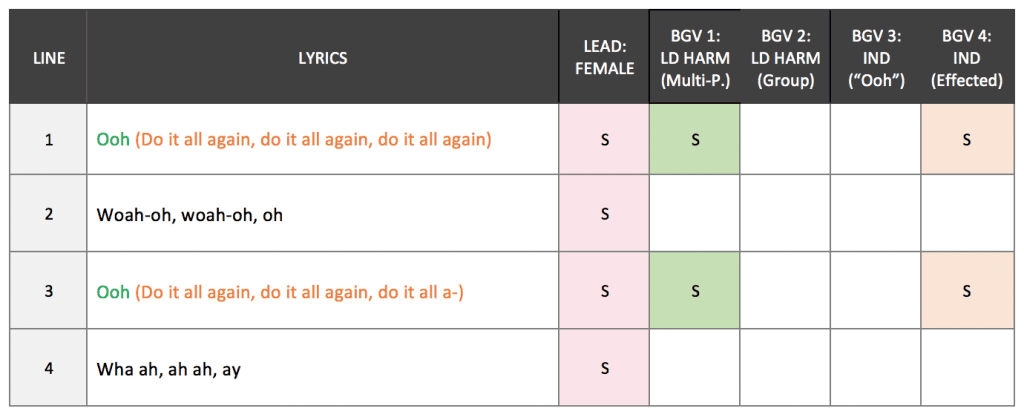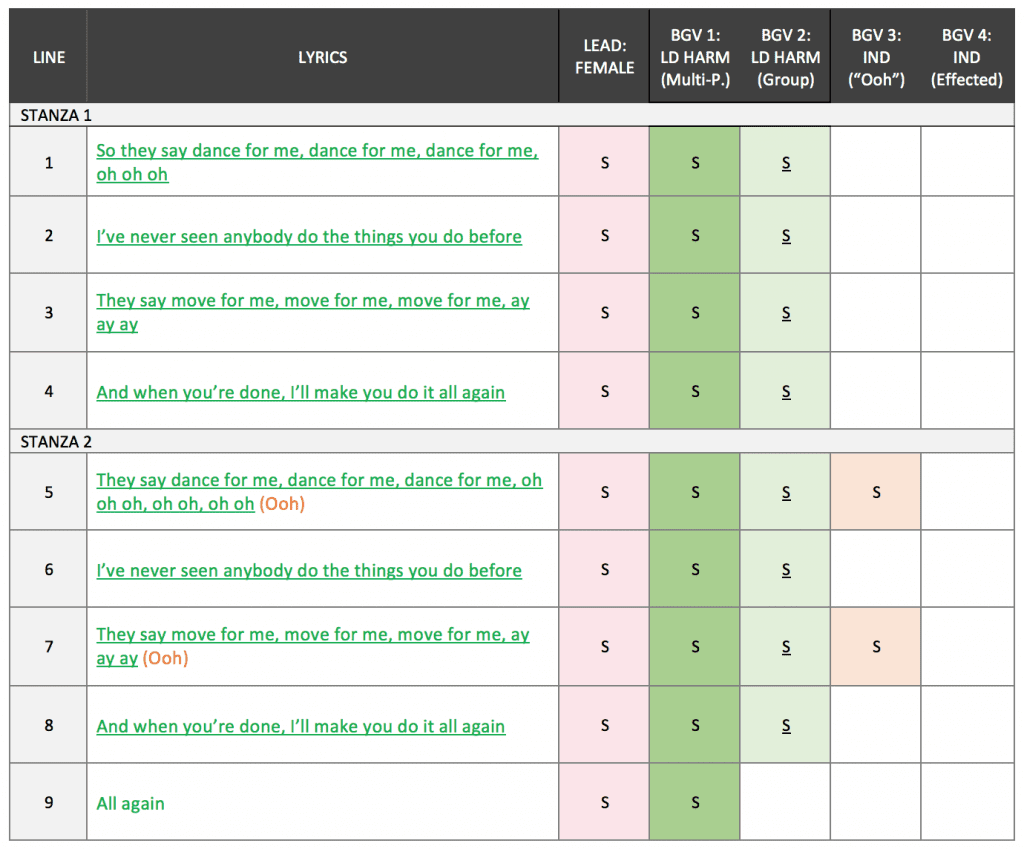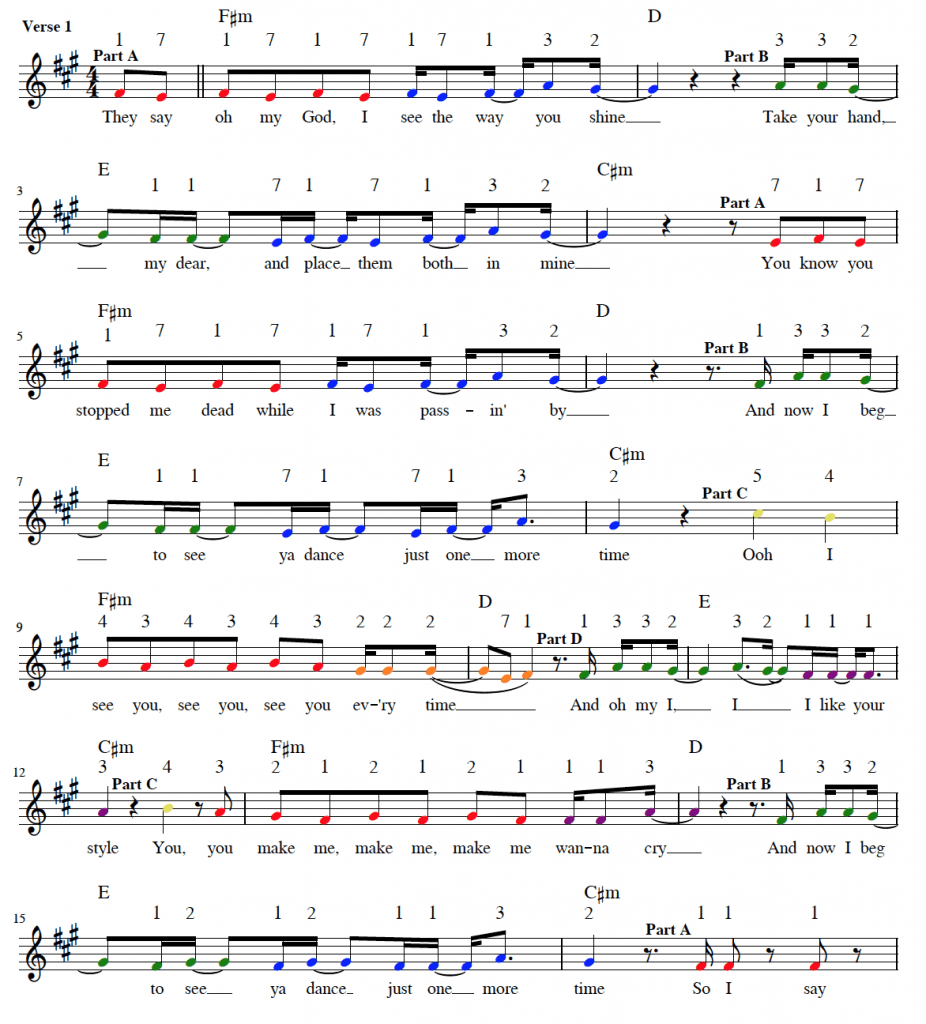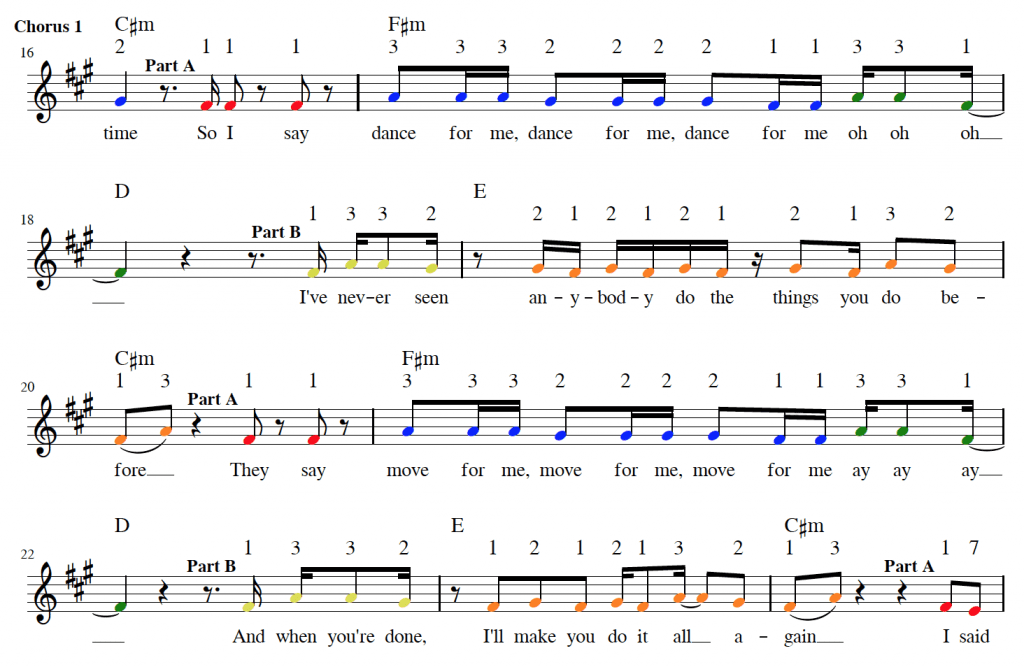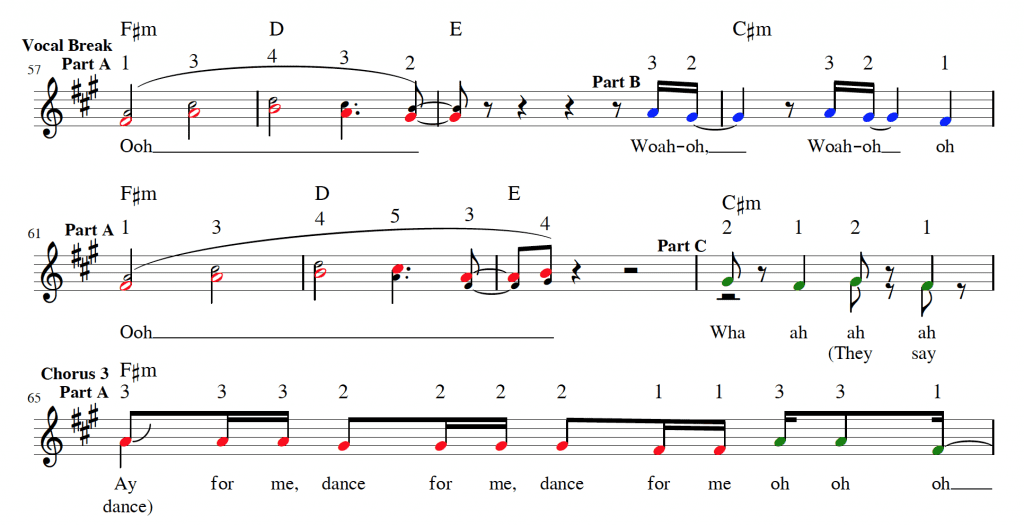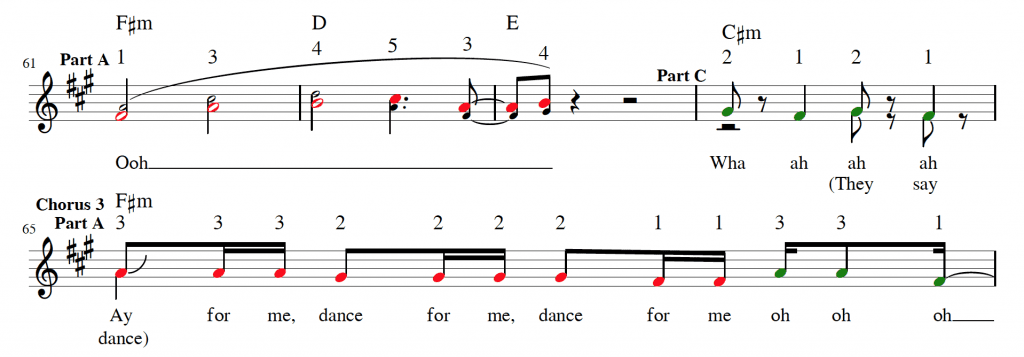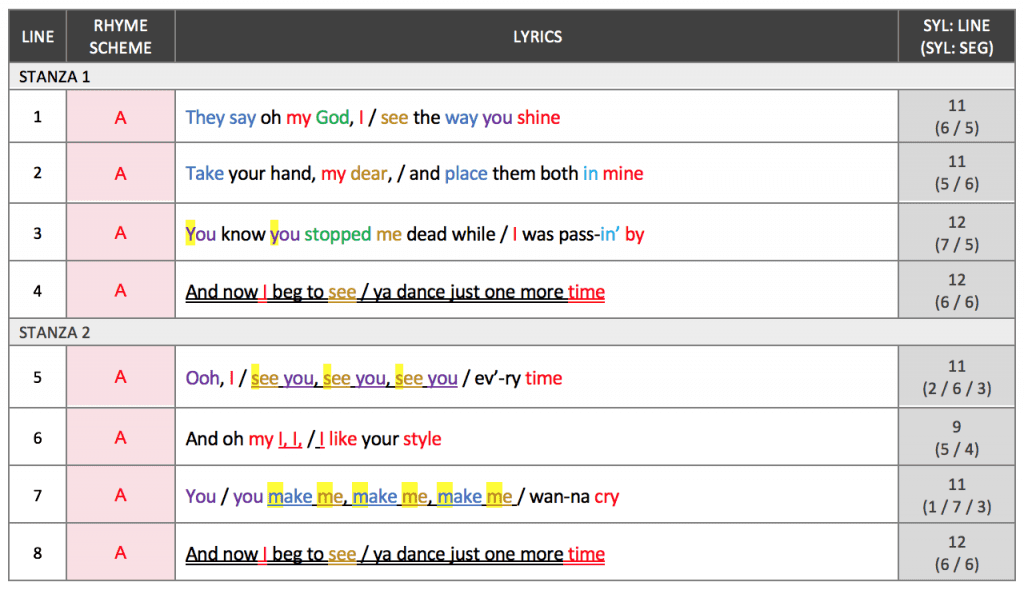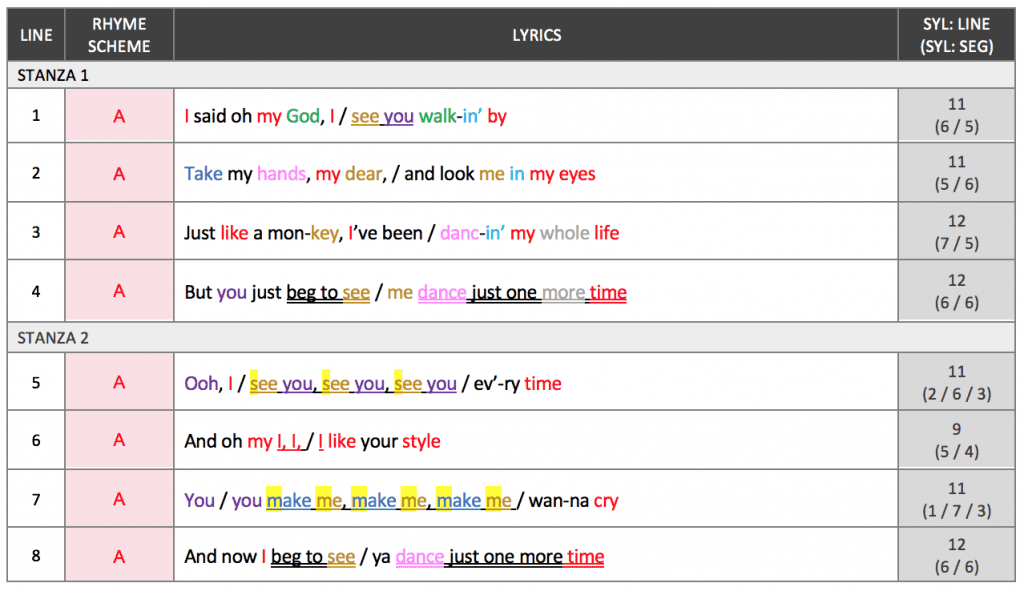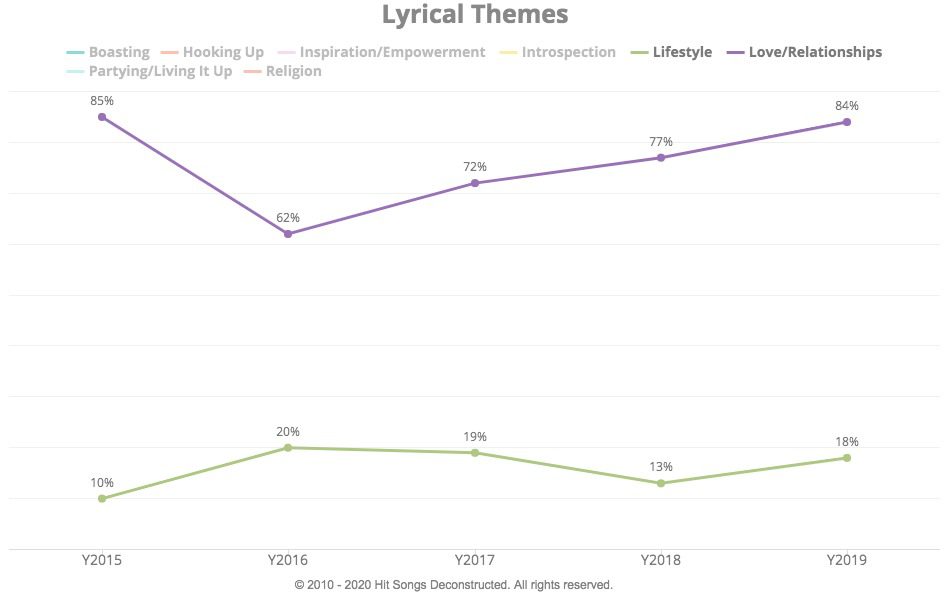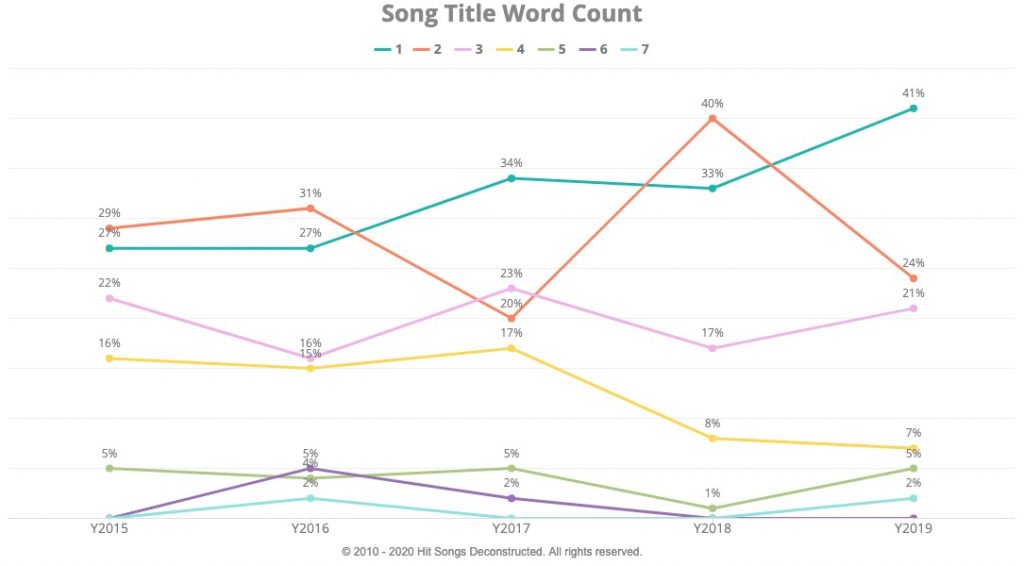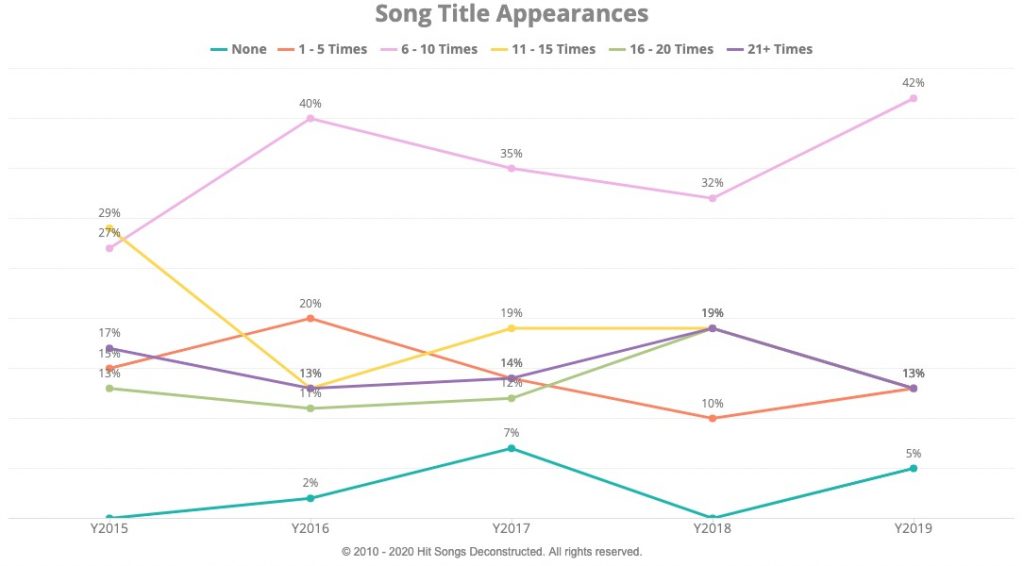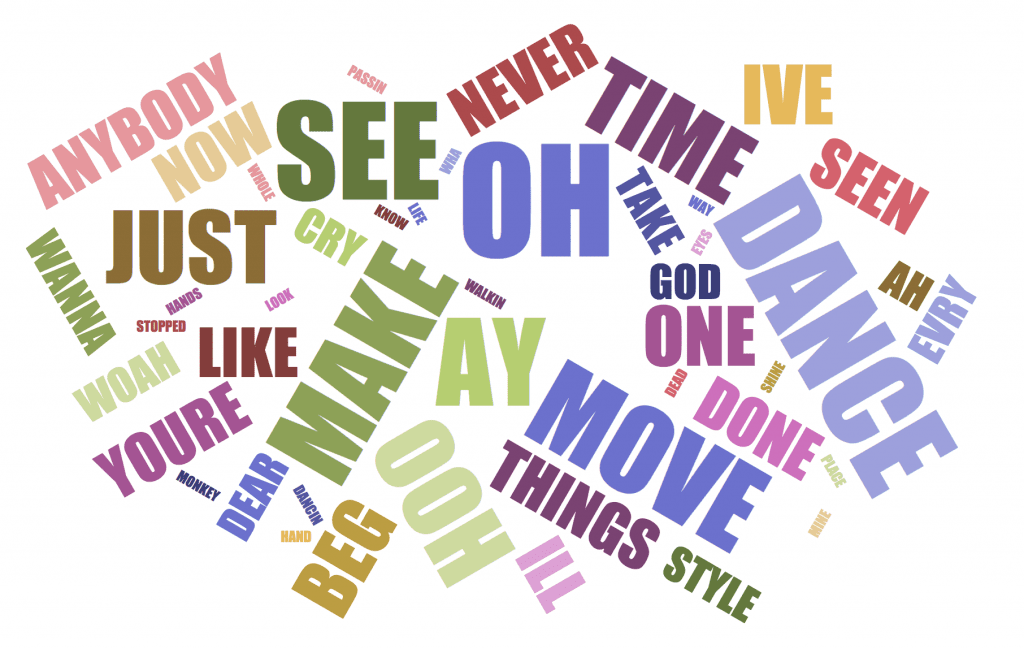About This Report
Hit Songs Deconstructed reports take a deep dive into the what, how, and why behind a current chart-topping hit. These exceptionally comprehensive reports feature a combination of impartial data and insightful analysis illustrated through charts, graphs, and notation.
Based on the Hit Songs Deconstructed PRO report, Essentials delivers high-level takeaways through insightful section-by-section analysis illustrated with charts, graphs and commentary, providing an in-depth understanding of the hit songwriting and production techniques involved in crafting the song.
Dance Monkey Deconstructed
For our first song report of the decade, we’ve selected Dance Monkey by Australian singer-songwriter Toni Watson, known professionally as Tones and I. The song first became a Pop sensation internationally, reaching the coveted #1 spot on charts in over 30 countries including Australia, Canada, France, Germany, Israel, Italy and Japan, among many others. It broke the historical record for the most weeks at #1 on Australia’s ARIA chart, and broke the UK record for the most weeks spent at the top of the UK Singles Chart by a female artist.
Watson made her US debut on The Tonight Show with Jimmy Fallon in November 2019, shortly followed by a guest appearance on The Voice the following month in December. One week later, Dance Monkey entered the Top 10 of both the Billboard Hot 100 and Mainstream Top 40 charts in the US, cementing itself as a global Pop powerhouse hit.
Dance Monkey is the first Hot 100 Top 10 hit for breakout artist Tones and I. The song was composed and performed entirely by Watson and is a testament to the singer’s independence, hustle, originality and talent. In fact, the song itself is an ode to Watson’s busking days and the trials and tribulations she faced playing for adoring yet impatient audiences. Together with producer Konstantin Kersting, Watson effectively brings this narrative to life utilizing Pop best practices such as captivating lyricism, super-infectious melodies, a highly effective structure, and standout production qualities to create a highly engaging and memorable listening experience. Furthermore, Watson’s unique vocal style gives the song a distinct sound and vibe, setting the song, and Watson herself, apart from mainstream contemporaries.
Video Deconstruction
At a Glance
Artist: Tones and I
Song: Dance Monkey
Songwriter: Tones and I (Toni Watson)
Producers: Tones and I (Toni Watson), Konstantin Kersting
Mixer: Konstantin Kersting
Mastering Engineer: Andrei Eremin
Record Label: EMG
Imprints: Bad Batch/Elektra
Primary Genre: Pop
Influences: Alt/Indie, Dance/Club, Electropop
Length: 3:26
Form: I-A-B-A-B-VB-B
Key: F# minor
Tempo: 99 BPM
First Chorus: 0:49 / 24% of the way into the song
Intro Length: 0:09
Electronic vs. Acoustic Instrumentation: Electronic/Acoustic Combo
Prominent Instruments: Bass (Synth), Claps, Drums/Percussion (Primarily Electronic), Piano (Acoustic), Piano (Electric), Snaps, Synth (Non-Bass)
Primary Lyrical Themes: Lifestyle, Love/Relationships
Title Appearances: None
Section Abbreviation Key
I=Intro
A=Verse
B=Chorus
VB=Vocal Break
Music notation and lyric excerpts are reproduced here under Fair Use terms, for the purposes of commentary and criticism.
Dance Monkey features an array of infectious vocal and instrumental hooks and motifs that take its impact to a heightened level.
KEY
I=Intro | A=Verse | B=Chorus | VB=Vocal Break
-/-: Divides stanzas
Number: Denotes the number of times that a particular hook appears within a section
Bold Underline: Denotes prominent featuring of the synth bass hook (the hook’s prominence is minimized in the second stanza of chorus 2 and all of chorus 3)
Instrumental Hook
While the repetitive, simple piano motif in the intro, verse and vocal break sections is infectious, Dance Monkey’s true standout instrumental hook is the foundational synth bass hook heard in the choruses. It features a slightly swung, infectious eighth and sixteenth note-based pattern that delivers the chord progression with cool, head-bobbing swagger. It’s heard most prominently in chorus 1 and the first stanza of chorus 2, where it shines front-and-center over the sparse arrangement. It then takes more of a back seat role in the second stanza of chorus 2 and the entirety of chorus 3 due to the denser instrumentation.
Foundational Synth Bass Hook
Primary Vocal Hooks
Table Key
Sub-Structure: Sub-part letters followed by a different number (i.e. b1, b2, b3) are melodically related but not exact. Sub-parts with the same letter (i.e. c) or same letter and number (i.e. b1) are melodically identical in each iteration.
Syllable Count: Top number represents the total number of syllables within a line. Numbers in parentheses represent segmented syllable counts put into effect by melodic and rhythmic changeups.
Graph Key
Numbers: Represent scale degrees
Lines: Represent melodic patterns
Point Colors: Correspond to melodic sub-structures as shown in the table
Dance Monkey’s two most notable vocal hooks appear back-to-back in the choruses. Together, they form a song-defining earworm consisting of both proper and nonsense lyrics and four melodic parts (note that the further breakdown of melodic parts here compared to the Vocal Melody section of the report is used to help illustrate the hook’s construction).
The first iteration of the hook pairing appears on the very first line of the chorus. After being set up by an accompaniment pull and the monotone, non-vibrant sub-part a1 melody (“so I say”), the chorus’s main melodic hook features a simplistic descending melodic pattern across three three-syllable segments and an eighth and sixteenth note-based rhythm.
Bolstering the impact of this melodic hook is the repetitive proper action-based lyric, “dance for me,” which both ties in with the essence of the narrative and song title and jibes with the section’s dance-inspired instrumental qualities. However, what really takes the hook’s impact to the next level is the short nonsense hook that directly follows in the sub-part c melody, “oh oh oh.” Functioning as an “icing on the cake” bonus hook at the end, it provides both the main hook and the chorus as a whole with a fun, infectious spin.
Following a strategic hook respite on line 2, this “double hook punch” is then melodically repeated on line 3, albeit with new lyrics to help keep it fresh and engaging in the scope of the section. The new proper action-based lyric, “move for me,” again ties in with the essence of the narrative as well as the dance-influenced accompaniment, while the new nonsense lyric, “ay ay ay,” provides a lyrically differentiated “icing on the cake” hook to cap the chorus off on an infectiously memorable note.
Additionally, note that this nonsense hook is developed in the second stanza of choruses 2 and 3, adding four additional “oh”s at the end. While subtle, this changeup functions to prevent hook redundancy and heighten both engagement and infectiousness further into the song.
Secondary Vocal Hooks
Key
Red: A.M.P. (alternating melodic pattern) melody hook (paired with repetitive lyrics)
In addition to the primary vocal hooks found in the chorus, Dance Monkey features secondary vocal hooks in each of its verses, which provides these sections with a subtle yet infectious spin. Appearing on lines 5 and 7 in both verses, these hooks feature the repetition of the lyrics “see you” and “make me,” respectively, delivered across an infectious stepwise 4-3-4-3 (B4 – A4 – B4 – A4) alternating melodic pattern, or A.M.P., as we at Hit Songs Deconstructed call it.
Vocal Motifs
Key
Blue: A.M.P. melody featured as a motif
Red: A.M.P. melody featured as a hook (paired with repetitive lyrics)
Green: E.O.L.A. (end-of-line accentuator) motif
Verses
Chorus 1
While the A.M.P.s paired with repetitive lyrics function as hooks in the second stanza of each verse, these A.M.P. melodies are initially featured as motifs in lines 1 and 3 with non-repetitive lyrics. This earlier appearance as motifs helps the A.M.P.s already sound familiar to the listener by lines 5 and 7, where they’re transformed into hooks when paired with repetitive lyrics. The A.M.P.s are then recycled again in each chorus section on lines 2 and 4 (plus lines 6 and 8 in choruses 2 and 3), where they once again become motifs subtly heightening memorability and cohesiveness on a cross-section basis.
In addition to the A.M.P. motifs found in the chorus and verse sections, there is also a prominent end-of-line accentuator motif found throughout the verses, or an E.O.L.A., as we at Hit Songs Deconstructed like to call it. Featured on lines 1-4 in addition to line 8 in both verse sections, the E.O.L.A. follows a 1-7-1-3-2 pattern (with slight variation in line 8) and serves as a cohesive thread throughout the verse. In addition to heightening memorability and familiarity and providing an infectious spin, the E.O.L.A. also serves to bolster the impact of the verse’s rhyme scheme, as every line it is featured on shares the “eye” end-of-line rhyme commonality.
Hook Maximization
Looking back at the chorus hooks in particular, while each hook is strong on its own, it’s the manner in which the main vocal hooks and bass hook work in tandem along with the four-on-the-floor kick that takes the impact of the section to the next level. Together, these elements rhythmically lock in the “dance for me / move for me” hook with the similarly syncopated bassline, creating a super-infectious, cohesive groove that stands out in the scope of the song.
Chorus 1 Vocals (Bars 1-4)
Chorus 1 Bass Hook (Bars 1-4)
Dance Monkey possesses a highly effective structure that is both familiar and atypical when compared to other recent Hot 100 Top 10 hits outside the Hip Hop genre. On the familiar side, it begins with an intro, features two verse and three chorus sections, utilizes a “D” (departure) section that doubles as an infectious post chorus, spends most of its time in the chorus and is in-line with the most popular tempo and song length ranges. However, it goes against the grain by forgoing a pre-chorus and outro and possessing lengthy verse and chorus sections compared to many of its mainstream contemporaries.
While the aforementioned characteristics in addition to others help Dance Monkey to both easily connect with audiences and stand out from the pack, its true structural strength is how seamlessly it leads the listener from section to section and develops familiar material in fresh ways throughout the song, creating a highly memorable and engaging listening experience.
Dance Monkey is a Pop song that possesses a combination of Electropop, Alt/Indie and Dance/Club influences that shape its sound and vibe. These influences are put into effect by characteristics of the vocals, instruments, production and lyrics.
Dance Monkey’s infectious Pop qualities allows it to resonate with a wide variety of mainstream audiences, while its Dance/Club, Electropop and Alt/Indie sub-genre/influence blend appeal to more specific audience subsets and help the song to further stand out among its Hot 100 Top 10 contemporaries.
Key
X: The influence is featured prominently within the section
x: The influence is featured minimally within the section
-/-: Divides stanzas
Dance Monkey’s blend of influences is in the minority among 2019’s Hot 100 Top 10 non-Hip Hop hits. Of 2019’s 38 non-Hip Hop songs, only 16% featured a combination of Electropop and Dance/Club influences, including Bad Guy, Boy With Luv, Happier, I Don’t Care and Sweet But Psycho. When you factor Alt/Indie into the mix, the pool gets even smaller, with only Bad Guy and Happier fitting the bill. This atypical combination of influences helped Dance Monkey to further stand out among its mainstream contemporaries and get noticed.
Additionally, note that Dance Monkey came onto the scene right around the time Pop as a primary genre began to see a resurgence in the Hot 100 Top 10, which coincides with the dwindling number of non-Hip Hop hits that include a Hip Hop influence. So, though Dance Monkey is not in tune with the 2017 – 2018 trend of including a Hip Hop influence, it is in line with the more recent downward trend of this genre influence. In fact, the inclusion of a Hip Hop influence has dropped from its peak of 77% in 2018 down to just 38% of hits by Q4 2019, when Dance Monkey first hit the Top 10. This puts Dance Monkey at the forefront of the new influx of songs that forgo a Hip Hop influence all together.
Dance Monkey’s Influence Popularity in the Hot 100 Top 10: 2015 – 2019 (All Songs)
Dance Monkey‘s Influence Popularity in the Hot 100 Top 10: 2015 – 2019 (Outside the Hip Hop Genre)
Dance Monkey features four main instrument types that shape its sound and vibe – keys, synths, synth bass, drums/percussion, and an assortment of effects.
Dance Monkey’s instrumental arrangement is a masterclass on how to capitalize on trends, achieve a unique yet universally appealing vibe and create a dynamic and engaging listening experience that keeps the listener hooked and wanting more.
Instrumentally, the song uses a combination of electronic, acoustic and quasi-acoustic instrumentation that provides an organic vibe while still enabling the song to connect with Electropop and Dance audiences. Among the notable instruments featured in the mix are a combination of electric and acoustic pianos, which play simplistic, repetitive motifs that prime the song for mainstream Pop appeal without overshadowing Tones and I’s unique vocals; synth bass, which delivers the chorus’s foundational hook and locks in with the four-on-the-floor kick, bass, hi hat and vocals in the chorus to create a cohesive, super-infectious dance groove; and both claps and snaps, which, in addition to contributing to the groove, put the song in tune with current trends, enabling it to more easily connect with mainstream audiences.
In addition to the effective instrument choices themselves, the meticulous manner in which the instruments are arranged throughout the song also greatly contributes to its impact, creating a highly engaging and varied structural flow. Peppered with full and partial accompaniment pulls, groovy chorus breakdowns and engaging section-to-section contrast, Dance Monkey takes its listeners on a roller coaster ride that keeps them tuned in for the entire 3 minutes and 26 seconds.
Dance Monkey’s energy flow strikes the perfect balance between minimal, pronounced, and at times unexpected dynamic shifts, creating a highly engaging and memorable listening experience. Looked at holistically, Dance Monkey’s energy arrangement is what one would expect from a Pop hit. It begins with low energy in the intro followed by a series of drops and rises in each of its three cross-section energy “waves,” culminating with a peak in the third and final chorus. However, along the way there is a combination of stagnant chorus breakdowns, jarring accompaniment pulls and unexpected “fakeouts,” all of which function to keep the listener locked in while ensuring that they remain alert and highly engaged.
Key
Wave: Indicates cross-sectional energy level flow from low to high
Pt. (Partial) S.I.A. (Section Impact Accentuator): A part of the accompaniment is removed from the mix (paired with a riser effect where noted in analysis)
Full S.I.A. (Section Impact Accentuator): The full accompaniment is removed from the mix (paired with a riser effect where noted in analysis)
Dance Monkey progresses though three energy level “waves.” Each wave progresses from low to high energy, save for the first stanza of each chorus in waves 1 and 2 and the breakdown in the last two bars of wave 3.
Wave 1
Wave 1 encompasses the intro through the end of chorus 1. It begins with relatively low energy in the intro due to the sparseness of the arrangement and then increases in both subtle and pronounced ways over the course of the first verse as new elements are added to the mix (save for the lower energy, transitional accompaniment pull in bars 7 and 8).
However, unlike most Pop hits, wave 1 does not end with an energy peak. Instead, the energy level drops off slightly in the chorus due to its breakdown arrangement. However, despite the slight reduction in energy, chorus 1 still provides a satisfying payoff following the tension-heightening verses, featuring a head-bobbing, dance-inspired groove that is designed to lock listeners in and get them moving.
Wave 2
Wave 2, which encompasses verse 2 through chorus 2, begins with a lower energy level compared to the chorus that precedes it. Verse 2 then begins to rise in energy in the same manner as it did across verse 1, which creates structural familiarity in the scope of the song. However, this time around, the overall energy level is a notch higher than verse 1, which helps to heighten engagement as the song progresses. Chorus 2 then follows with a slight drop off in energy, just as it did the first time around in chorus 1. However, like verse 2, its energy is also slightly higher than its wave 1 counterpart, keeping it in line with the more energetic wave 2 flow. Further differentiating chorus 2 from chorus 1 is its inclusion of a second stanza, which brings the song’s energy to a peak through the addition of new accompaniment elements and subtle vocal changeups.
Wave 3
Wave 3, which encompasses the vocal break through chorus 3, begins with a stark drop off in energy in the sparsely arranged vocal break. Note that the energy level here is the lowest it’s been since the intro, which provides the song with a much needed energy reprieve to heighten the listener’s engagement against the higher-energy sections that surround it. After gradually building in the second half of the vocal break, the song’s energy is thrust up to a grand peak in chorus 3, which forgoes the chorus 1/chorus 2 breakdown and instead hits with the high-energy arrangement that defined the second stanza of chorus 2 right from the get-go, along with more powerful group vocals. After increasing a touch further in the second stanza of the chorus, the song’s energy diminishes across the last two bars through two gradually sparser accompaniment pulls, bringing the listener gently back to the ground as the song comes to a conclusion.
Dance Monkey uses one main chord progression that is featured in every section of the song and delivered through varied instrumentation. It features a diatonic, easy-to-follow F#m – D – E – C#m (F# minor: i-VI-VII-v) progression with each chord lasting one bar, usually with an additional anticipation one sixteenth note before beat 1 of the next bar. Though the progression is highly repetitive over the course of the song, it is kept interesting through its many delivery methods, ranging from high-end, bouncy electric keys, to sustained synth pads, to groovy, syncopated synth basslines.
Though every aspect of Dance Monkey is strong, the song’s defining quality is unquestionably singer Tones and I’s vocals. While the super-infectious melodies enable the song to easily connect with mainstream Pop audiences – a hallmark of any great Pop hit – it’s the unique manner in which Tones and I delivers the lead and background vocals that puts the song over the top. Not only does this enable Dance Monkey to stand out among its mainstream contemporaries, but Tones and I herself as well. Her unique style puts her in a class of her own, cementing her position alongside other A-list vocalists such as Ariana, Billie and Lizzo.
Dance Monkey features a female lead vocal from Tones and I. While female leads in the Hot 100 Top 10 have trailed their male counterparts for many years, they have been gaining in popularity. Looking specifically at songs outside the Hip Hop genre, songs with a female lead have nearly doubled from 26% in 2016 up to 50% during the first two months of 2020, tying their male counterparts. This is the highest level seen in over five years.
Lead vocal Hot 100 Top 10 (non-hip hop) trends over the past five years: Click Here
Dance Monkey’s most defining factor is Tones and I’s vocal style. Her unique delivery, complete with idiosyncratic pronunciations, groovy rhythmic precision and engaging transitions between vocal registers that give her an almost cartoonish, “Betty Boop” timbre, sets both her and the song apart from their mainstream contemporaries. Tones’s delivery also superbly supports the song’s narrative, striking a perfect balance between soft/breathy passages and in-your-face vocal growls that accentuate the protagonist’s raw emotion.
While Tones and I’s lead vocal is certainly the star of the show, an assortment of background vocals are featured as well that both support the lead and add infectious embellishments to heighten engagement throughout the song. These background vocals range from a natural-sounding “ooh” vocal that serves as an infectious vocal “pad” underneath Tones and I’s lead, to distorted pitch-shifted background vocals that provide her lead with a heightened degree of impact, to a multi-voice group vocal in chorus 3 that provides differentiation from the other choruses and heightens excitement as the song heads toward a conclusion.
The vocal effects and processing used in Dance Monkey run the gambit, ranging from spacious reverb and delay to distorted pitch-shifting. On the conventional side, the song’s producers used long-tailed reverb and subtle delay to help Tones and I’s unique delivery shine in a natural manner while still contributing to the sonic landscape in the song’s sparser sections. On the unique side, pitch- and formant-shifted octave doubles are added in the choruses to heighten engagement with the lead and add low-end contrast. And perhaps most notable of all, the background vocal featured in the vocal break uses distortion and EQ filtering as well as pitch and formant processing, giving it a trombone-like timbre as it reinforces a line from the chorus in a unique, though essentially unintelligible, manner that heightens engagement and interest within the section.
Key
X: Indicates that a vocal layer is present within a song section
-/-: Separates stanzas
BGV: Background vocal
Along with Tones and I’s unique and intriguing vocals, Dance Monkey’s defining factor is its super-infectious melodies. Writer Tones and I uses just about every technique from the hit song playbook to effectively craft, reinforce and develop melodies over the course of the song, getting them ingrained in the listener’s head without waring out their welcome.
Each section of Dance Monkey firmly adheres to the K.I.S.S. ME principal (Keep It Simple, Singable and Memorable), a highly important component of any hit song melody. The clever recycling of motifs both within and across sections additionally heightens familiarity, cohesiveness and “hookiness,” while subtle changeups help to prevent cookie-cutter monotony. Furthermore, cross-stanza changeups in each section heighten engagement and excitement along with shifts in vocal delivery and accompaniment. And above all, the chorus’s main hook melody (“So I say dance for me, dance for me, dance for me, oh oh oh”) is in and of itself a masterclass in earworm melody composition. Each iteration consists of three distinct melodic parts that function to set up the main hook, deliver the main hook, and provide a bonus “icing on the cake” nonsensical hook at the end, while the line’s melodic symmetry and close adherence to the K.I.S.S. ME principle ensure that it easily connects and resonates with the listener.
Verses
*Note that this table represents verse 1. Verse 2 features an identical melodic structure, albeit with varied lyrics and minor melodic changeups.
Chorus 1
Chorus 2
Chorus 3
Vocal Break
Verses
*Note that this graph represents verse 1. Verse 2 features a nearly identical melodic shape with minor changeups.
Chorus 1
Chorus 2
Chorus 3
Vocal Break
Bolstering the impact of Dance Monkey’s infectious melodies and engaging storyline are its methodically structured rhymes. Among the lyrical techniques that writer Tones and I uses are a combination of internal and end-of-line rhymes (both perfect and near), alliteration, repetitive lyrics and cross-line, cross-stanza and cross-section lyrical commonalities. The song also features a strategic syllable structure, which, together with the song’s rhymes and other lyrical devices, heightens the lyric’s ability to connect and resonate with the listener.
At-A-Glance: Primary Rhymes Section by Section
Key
A, B, & C: End-of-line rhymes
X: Non-rhymes
Lyrics: The primary rhyme at the end of each line
Colors and rhyme schemes are unique to each section
At-A-Glance: Syllable Count Section by Section
Key
Numbers: Denotes the total number of syllables in a line
Numbers in parentheses: Denotes the number of syllables in a specific line segment. Segmentation is achieved through melodic or rhythmic contrast within a line or the use of rests between segments. Lines without parenthesis have no segmentation. Reference the Vocal Melody section of the report for further details.
Colors: Reflect song sections (note that they do not relate to the colors used in the rhyme tables)
Compared to other more generic Hot 100 Top 10 hit song titles such as Goodbyes, I Like It and Lover, Dance Monkey leans more toward the attention-grabbing end of the spectrum due to its unique, intriguing nature. This effectively piques the listener’s curiosity to check out the song and find out what Dance Monkey relates to in the scope of the narrative.
In addition to its intriguing title, Dance Monkey stands out from most of its mainstream contemporaries in that the proper full song title is never featured in the narrative. Instead, fragments of the full title – “dance” and “monkey” – are featured independently throughout the song. Over the past five years, only 3% of non-Hip Hop Hot 100 Top 10 hits and 15% of Hip Hop hits did not feature the proper title within their framework.
Dance Monkey is a lifestyle and love/relationships (platonic) themed song about a highly talented street performer who has become frustrated with the repetitive nature of her job and incessant, unappreciative audiences. The narrative follows this protagonist as she ruminates on the comments her audiences make about her and their never-ending requests for her to perform for them again, making her feel like a trained “dance monkey.”
One important thing to note about the narrative is that it is based off of a real-life experience writer/singer Toni Watson went through back when she was a street performer. In her own words, there was one particular night where she had been busking for six hours when “one person ran past and stole [her] money. Someone else leaned over and tried to play [her] keyboard. The whole crowd was drunk and rowdy.” Watson said that at that point, she decided enough was enough and stopped playing. When the audience booed her as a result, she become “so frustrated,” because it showed her that “people didn’t have much patience anymore.” Hence, she felt like a “dance monkey.”
Writing lyrics based on real-life experiences is effective in that it enables performing artists to connect with the narrative on a deeper level, thus enabling them to deliver it in a more believable manner. Furthermore, it also deepens the narrative’s connection value with the listener, giving them a more intimate, personal look into their favorite artists’ lives, which many fans crave. However, note that many of the specific details are actually left out of the narrative, which heightens its universal appeal and allows room for the listener to insert themselves and their own life’s circumstances into the storyline. For example, when the lyric “dance” is substituted for something that pertains directly to the listener such as “paint,” “play,” “sing,” etc., the essence of Dance Monkey can be adapted to anyone who has ever felt underappreciated and overworked.
Among the many elements bolstering the impact of Dance Monkey’s universal storyline are the effective use of the A.I.D.E. principle (action, imagery, detail and emotion); clever lyricism, including the use of repetitive lyrics in the verse and chorus sections that both provide an infectious spin and jibe with the repetitive essence of the narrative; and the atypical repetition of the same lyrics across verse sections, which take on an entirely different meaning when presented in a new context in verse 2.
Key
COMM DIR.: Communication direction (audience/protagonist)
AUD: Communicated from the audience’s perspective
PRO: Communicated from the protagonist’s perspective
Verse 1
Chorus 1
*Note that choruses 2 and 3 each consist of two stanzas that feature essentially the same proper lyrical content as chorus 1.
Verse 2
Dance Monkey possesses a highly effective structure that is both familiar and atypical when compared to other recent Hot 100 Top 10 hits outside the Hip Hop genre. On the familiar side, it begins with an intro, features two verse and three chorus sections, utilizes a “D” (Departure) section that doubles as an infectious post chorus, spends most of its time in the chorus and is in-line with the most popular tempo and song length ranges. However, it goes against the grain by forgoing a pre-chorus and outro and possessing lengthy verse and chorus sections compared to many of its mainstream contemporaries.
While the aforementioned characteristics in addition to others help Dance Monkey to both easily connect with audiences and stand out from the pack, its true structural strength is how seamlessly it leads the listener from section to section and develops familiar material in fresh ways throughout the song, creating a highly memorable and engaging listening experience.
Dance Monkey contains seven sections in its framework:
- One intro section
- Two verse sections
- Three chorus sections
- One vocal break section (the vocal break is both a post chorus and a departure section)
Post Chorus Section Classification
A post chorus is the classification of a song section that follows a chorus and functions as an additional “hook center” in the song’s framework. Dance Monkey’s post chorus is its vocal break, which follows the second chorus and doubles as the song’s “D” (Departure) section. It features the piano motif in its second half, which was initially introduced in the intro, as well as two repeated vocal hooks: the “ooh” background vocal from the second verse, now treated as a lead vocal, and the “do it all again” hook from the preceding choruses, now treated as a highly processed background vocal. The combination of similarities and differences compared to their first occurrence counterparts helps reinforce these hooks in both a familiar and fresh manner. Additionally, singer Toni Watson’s newly introduced “woah-oh” vocal adlibs provide the section with a new infectious spin.
Note that the popularity of post choruses among non-Hip Hop Hot 100 Top 10 hits diminished greatly between 2017 and 2018 due to the rise of Hip Hop, which does not commonly feature post choruses. However, there was a post chorus resurgence in 2019 due to Pop’s increased prominence in the Top 10.
Use of a Post Chorus in Non-Hip Hop Hot 100 Top 10 Hits: 2015 – 2019
“D” (Departure) Section Classification
A “D” (Departure) section is the classification of a song section that provides a pronounced vocal, lyrical, instrumental, and/or energy level departure compared to other sections in the song, usually occurring around two-thirds of the way in. The departure is then typically followed by the return to familiar territory in the next section, which is usually a chorus.
Dance Monkey’s “D” section is its vocal break, which also doubles as a post chorus. It occurs at 71% of the way through the song, which is the exact spot of the Hot 100 Top 10 2019 non-Hip Hop average, and features a breakdown arrangement consisting of familiar material presented in a fresh manner. The section’s unique qualities in the scope of the song greatly heighten engagement, while its familiar aspects effectively heighten infectiousness and memorability. Following the “D” section, the song returns to entirely familiar territory by heading back into a third and final chorus.
Note that while the inclusion of a “D” section is very common in genres outside of Hip Hop, bridges are far more common than bridge surrogates, which are sections that provide a departure in lieu of a narrative-advancing bridge, such as a vocal or instrumental break. In 2019, 55% of songs contained a bridge compared to just 29% with a bridge surrogate, of which Dance Monkey was one. However, note that the vocal break was the most popular type of bridge surrogate section over the last few years save for 2019, where it was slightly edged out by the third verse bridge surrogate.
Bridge Surrogate Sections in Non-Hip Hop Hot 100 Top 10 Hits: 2015 – 2019
No Outro
Outros have by far been the most common concluding song section over the last five years and accounted for 78% of overall Hot 100 Top 10 hits in 2019. When looking at specific genre subsets, however, note that the use of an outro in Hip Hop hits increased to 95% of songs in 2019, but decreased outside of the Hip Hop genre from 81% in 2018 down to 68% in 2019. This was due to the increased number of songs that ended with a chorus, which nearly doubled to 29% of songs in 2019 including Dance Monkey.
Last Section in Non-Hip Hop Hot 100 Top 10 Hits: 2015 – 2019
No Pre-Chorus
Over the past five years, the vast majority of non-Hip Hop Hot 100 Top 10 hits have included a pre-chorus in their framework. Dance Monkey goes against the grain by not using one. However, the percentage of non-Hip Hop hits that forgo a pre-chorus more than doubled in 2019 to 37% of songs, essentially meaning that more songs are getting to their first chorus faster (the average amount of time shortened from 45 seconds into the song in 2018 down to 39 seconds in 2019). Other major 2019 hits that forgo the pre-chorus are Bad Guy, Circles, Girls Like You and Senorita, among others.
Use of a Pre-Chorus in Non-Hip Hop Hot 100 Top 10 Hits: 2015 – 2019
Dance Monkey begins with an intro, which was by far the most popular way for Hot 100 Top 10 hits to begin in 2019 (97% of songs). From there, it heads into two repetitions of a verse – chorus sectional progression, which creates structural familiarity within the song while the new developments and elements help to heighten engagement.
Following the second chorus, the song heads into a vocal break, which doubles as both a “D” (Departure) section and post chorus. The vocal break also possesses a combination of both familiar and contrasting qualities compared to the other sections in the song, simultaneously heightening both engagement and memorability. Dance Monkey then returns to familiar territory in the third and final chorus, which brings the song to a conclusion. However, note that the final chorus also possesses unique qualities compared to preceding choruses, which further heightens engagement as the song comes to an end.
Looking at the occurrence time of each of Dance Monkey’s sections, its verse sections occur earlier than the 2019 Hot 100 Top 10 average (excluding Hip Hop) while its chorus sections occur later. However, its “D” (Departure) section occurs exactly at the 2019 average at 71% into the song.
Dance Monkey
Hot 100 Top 10 Average (Outside of the Hip Hop Genre): 2019
First Chorus Appearance
Dance Monkey’s first chorus hits at 49 seconds / 24% of the way into the song. While this is 10 seconds and 5% later than the 2019 Hot 100 Top 10 non-Hip Hop average, it is smack in the middle of the most popular time-into-song range, which is between 0:40 and 0:59.
First Chorus Occurrence Range in Non-Hip Hop Hot 100 Top 10 Hits: 2015 – 2019
The listener is kept engaged until this point by a 9 second/4 bar intro and a 40 second/16 bar verse, which is split into two shorter 20 second/8 bar segments that possess both familiar and differing qualities to heighten both engagement and memorability.
Song Length
Dance Monkey clocks in at 3:26, which is 16 seconds longer than the Hot 100 Top 10 2019 average of 3:10 and 10 seconds longer than the non-Hip Hop hit average of 3:16. Also note that while the under 3:00 song length range has been steadily increasing in popularity, the 3:00 – 3:29 range has remained the most popular among non-Hip Hop hits over the past couple of years.
Song Length Range in Non-Hip Hop Hot 100 Top 10 Hits: 2015 – 2019
Section Length
The verse sections and choruses 2 and 3 are the longest sections in the song, each clocking in at 40 seconds/16 bars in length. Note that this is 15 seconds longer than both the non-Hip Hop verse and chorus section length averages in 2019. In regard to the verses, only two other songs in 2019 had verse sections landing over 40 seconds in length – Billie Eilish’s Everything I Wanted and Chris Brown’s No Guidance. It was a similar case with choruses; only Halsey’s Without Me, Taylor Swift’s Lover and Lewis Capaldi’s Someone You Loved had one or more of their choruses landing over 40 seconds in length.
The first chorus and vocal break follow as the song’s second longest sections, clocking in at 20 seconds/8 bars each, followed by the intro at 9 seconds/4 bars. Additionally, note that by leaving the first chorus short at half the length of the second and third choruses, the chorus “hook center” has more room to build over the course of the song while getting further ingrained in the listener’s head.
Heightened Engagement Through Frequent Material Changeover
Most of the song’s sections provide the listener with new vocal, instrumental or lyrical information roughly every 4 bars/10 seconds, allowing for heightened engagement through frequent material changeover. However, the chorus sections are more stagnant, featuring new information roughly every 8 bars/20 seconds, thus heightening memorability of the song’s more repetitive primary “hook center.”
As is typically the case with Top 10 hits, Dance Monkey spends the most amount of time in the chorus, which accounts for 48% of the song. The second most amount of time is spent in the verse sections, which comprise 38% of the song’s total composition. The vocal break post chorus/departure section follows at 10%, and the intro comprises the least amount of time spent at just 4%.
Dance Monkey / 2019 Hot 100 Top 10 Average Comparison (Outside the Hip Hop Genre)
- Intro: 4% / 6%
- Verse: 38% / 28%
- Chorus: 48% / 36%
- “D” Section: 10% / 9%
As you can see, Dance Monkey spends a near equal amount of time in the intro and “D” section compared to the Hot 100 Top 10 average, but significantly more time in the verse and chorus sections. This is made possible within the song’s relatively short time frame by the omission of other sections such as a pre-chorus and outro.
Dance Monkey sits at 99 BPM throughout the entire song, save for a subtle ritardando leading into the first chorus. This tempo is set into motion right at the start of the song by the eighth note-driven electric piano, which is later joined by acoustic piano, kick, bass and various percussive elements, all of which help provide the song with its mid-tempo Dance/Club influence.
Note that Dance Monkey’s tempo is only 3 BPM slower than the 2019 Hot 100 Top 10 non-Hip Hop average and falls within the 90-99 BPM range, which has been among the two most popular tempo ranges over the past five years (the other being the 100-109 BPM range). Additionally, in 2019, the 90-99 range increased while the 100-109 range decreased greatly, resulting in the 90-99 range becoming the clear frontrunner.
Tempo Range in Non-Hip Hop Hot 100 Top 10 Hits: 2015 – 2019
Dance Monkey’s energy flow strikes the perfect balance between minimal, pronounced, and at times unexpected dynamic shifts, creating a highly engaging and memorable listening experience. Looked at holistically, Dance Monkey’s energy arrangement is what one would expect from a Pop hit. It begins with low energy in the intro followed by a series of drops and rises in each of its three cross-section energy “waves,” culminating with a peak in the third and final chorus. However, along the way there is a combination of stagnant chorus breakdowns, jarring accompaniment pulls and unexpected “fakeouts,” all of which function to keep the listener locked in while ensuring that they remain alert and highly engaged.
These qualities, along with the song’s other highly infectious, engaging and memorable characteristics, greatly contributed to Dance Monkey’s stellar success around the world.
Key
Wave: Indicates cross-sectional energy level flow from low to high
Pt. (Partial) S.I.A. (Section Impact Accentuator): A part of the accompaniment is removed from the mix (paired with a riser effect where noted in analysis)
Full S.I.A. (Section Impact Accentuator): The full accompaniment is removed from the mix (paired with a riser effect where noted in analysis)
Dance Monkey progresses though three energy level “waves.” Each wave progresses from low to high energy, save for the first stanza of each chorus in waves 1 and 2 and the breakdown in the last two bars of wave 3.
Wave 1
Wave 1 encompasses the intro through the end of chorus 1. It begins with relatively low energy in the intro due to the sparseness of the arrangement and then increases in both subtle and pronounced ways over the course of the first verse as new elements are added to the mix (save for the lower energy, transitional accompaniment pull in bars 7 and 8).
However, unlike most Pop hits, wave 1 does not end with an energy peak. Instead, the energy level drops off slightly in the chorus due to its breakdown arrangement. However, despite the slight reduction in energy, chorus 1 still provides a satisfying payoff following the tension-heightening verses, featuring a head-bobbing, dance-inspired groove that is designed to lock listeners in and get them moving.
Wave 2
Wave 2, which encompasses verse 2 through chorus 2, begins with a lower energy level compared to the chorus that precedes it. Verse 2 then begins to rise in energy in the same manner as it did across verse 1, which creates structural familiarity in the scope of the song. However, this time around, the overall energy level is a notch higher than verse 1, which helps to heighten engagement as the song progresses. Chorus 2 then follows with a slight drop off in energy, just as it did the first time around in chorus 1. However, like verse 2, its energy is also slightly higher than its wave 1 counterpart, keeping it in line with the more energetic wave 2 flow. Further differentiating chorus 2 from chorus 1 is its inclusion of a second stanza, which brings the song’s energy to a peak through the addition of new accompaniment elements and subtle vocal changeups.
Wave 3
Wave 3, which encompasses the vocal break through chorus 3, begins with a stark drop off in energy in the sparsely arranged vocal break. Note that the energy level here is the lowest it’s been since the intro, which provides the song with a much needed energy reprieve to heighten the listener’s engagement against the higher-energy sections that surround it. After gradually building in the second half of the vocal break, the song’s energy is thrust up to a grand peak in chorus 3, which forgoes the chorus 1/chorus 2 breakdown and instead hits with the high-energy arrangement that defined the second stanza of chorus 2 right from the get-go, along with more powerful group vocals. After increasing a touch further in the second stanza of the chorus, the song’s energy diminishes across the last two bars through two gradually sparser accompaniment pulls, bringing the listener gently back to the ground as the song comes to a conclusion.
Note that throughout the song, both full and partial accompaniment pulls are utilized as transitional elements between stanzas and sections, as well as at the very end of the song. They function on several levels, primarily to heighten engagement, tension and the impact of subsequent sections due to the volume and accompaniment contrast they create.
Dance Monkey features methodical fluctuations in loudness, which, along with the song’s other energy-affecting qualities, creates a dynamic and engaging listening experience. Loudness levels range from -19 LUFS in the intro (quietest) to -7 LUFS toward the end of the song in the second stanza of chorus 3 (loudest). With the exception of chorus 1, each section in the song traverses through multiple loudness levels, each of which correlates with shifts in the arrangement.
Verses 1’s first stanza sits at -12 LUFS, followed by a leap up to -9 LUFS in the denser, more energetic second stanza. Then, in the last bar, the level drops to -15 LUFS due to the implementation of a full accompaniment pull, helping to maximize the impact of the ensuing -11 LUFS chorus. The 8-bar chorus then remains at a consistent -11 LUFS over the course of the section, which is in-line with the consistency in the arrangement and vocals. Together, these unchanging qualities enable the listener to lock into the chorus’s head-bobbing groove and focus on the infectious vocals for the entirety of the section without any distraction.
Verse 2 follows with essentially the same loudness pattern as verse 1, though its first stanza and last bar are 1 LUFS louder due to the fuller accompaniment changeups.
Chorus 2 begins at a mid-level -10.5 LUFS in the first stanza before jumping up to -8 LUFS in the denser, more energetic second stanza, where it remains for the duration of the section. This is followed by a slight decrease in loudness in the ensuing vocal break, which sits at -10 LUFS in the first stanza and -9 LUFS in the second. The last bar of the vocal break then starkly drops to -12 LUFS along with its section-ending accompaniment pull, which helps the subsequent high-loudness, high-energy chorus to stand out even further in comparison.
The third and final chorus begins significantly louder at -7.5 LUFS, followed by a second stanza increase to -7 LUFS. Note that this is the loudest point in the entire song, which, along with the dense, energetic arrangement, takes energy and excitement to a grand peak. However, in the last two bars of the third chorus, the level decreases to -8.5 LUFS along with a thinning of the arrangement, followed by another significant drop off to -14 LUFS in the last bar, bringing the song to a conclusion on a more subtle note featuring nothing but Tones and I’s solo vocals.
Intro (I)
Dance Monkey’s intro features the sparsest arrangement, lowest energy and lowest loudness in the scope of the song. The section is defined solely by the eighth note-driven electric piano motif, which sets the song into motion at a fairly low energy level set to a 99 BPM tempo. In regard to loudness, the intro sits at -19 LUFS, 12 LUFS lower than the song’s loudest peak in chorus 3. Note that this technique of starting a song with a low energy and loudness level is highly common among Pop song intros, as it allows room for the song to grow in subsequent sections both in terms of energy and volume.
In the third bar of the intro, a riser effect is employed leading into a full accompaniment pull on the last beat of bar 4. The riser effectively heightens tension and anticipation for the ensuing verse, while the full accompaniment pull it leads into creates an energy lull that helps the verse to hit with greater perceived impact.
Verse 1 (A1)
Stanza 1
Following the accompaniment pull at the end of the intro, verse 1’s arrival is punctuated with a piano stab right on the first downbeat, which instantly kicks up the song’s energy along with the introduction of Tones and I’s lead vocal. These developments are joined by a leap in loudness to -12 LUFS, which helps the section to further stand out and connect with the listener. The energy remains constant across the first four bars of the verse due to the stagnancy of the arrangement, followed by a slight increase in bars 5 and 6 as backbeat-developing snaps are introduced to the mix.
Following the slight energy increase in bars 5 and 6, a pronounced and unexpected shift takes place in bars 7 and 8. Instead of developing the groove and heightening energy further, the snaps and electric piano motif are abruptly pulled from the mix and replaced by two sustained acoustic piano chords under Tones and I’s vocal. This unexpected arrangement changeup results in a significant reduction in energy, effectively heightening the listener’s engagement and enabling the more energetic second stanza to hit with increased perceived impact (reference the Music and Instruments section of the report for more information about the “fake out” effect this development creates).
Stanza 2
Following the lower-energy breakdown in bars 7 and 8, stanza 2 thrusts the verse’s energy back up. Here, several key changeups take place: the addition of kick, sub bass and claps provide heightened power and forward momentum; a low-level synth pad subtly heightens tension; the acoustic piano stabs of the first verse switch to doubling the electric piano motif, providing the section with even more drive and forward momentum; and Tones and I’s vocal now possesses a fuller, more animated quality. These characteristics along with a jump in loudness to -9 LUFS take energy and tension to a new level, greatly heightening the listener’s anticipation for the impending chorus as a result.
In the last bar of the verse, the full accompaniment is abruptly pulled save for a synth/reverse cymbal riser effect. The abruptness of the pull and resulting drop in energy and loudness to -15 LUFS serves to greatly heighten the listener’s engagement, while the riser provides a transitional element that effectively leads the listener into the first chorus.
Chorus 1 (B1)
Following the S.I.A. technique employed at the end of verse 1, the chorus turns the song on its head with a completely revamped accompaniment that forgoes the forward-moving, piano-driven groove of the verse and instead consists solely of a grooving synth bass hook, a simplified four-on-the-floor kick, snaps and low-level high hat. This sparser arrangement along with Tones and I’s more subdued vocal interestingly come in at a slightly lower energy level than the verse, which goes against the “big chorus payoff” notion that many people still have when it comes to Pop hits (i.e. Wrecking Ball, Stronger, Roar, etc.). Instead, Dance Monkey’s first chorus is in line with more recent Pop hits such as Dua Lipa’s Don’t Start Now and Khalid and Disclosure’s Talk, which forgo the “big” payoff in favor of a more restrained, infectious, groove/vibe-based payoff.
The chorus then concludes with a cymbal riser effect, which serves to heighten tension and energy leading into the ensuing verse.
Verse 2 (A2)
Stanza 1
Following the chorus, the first stanza of verse 2 brings the song’s energy down a notch as it reverts back to the less driving, piano-driven accompaniment that defined verse 1, albeit with new elements including snaps, the light synth pad, a newly-introduced rhythmic synth, and additional low-end power in the acoustic piano across the first four bars. These new and modified elements provide verse 2 with a greater sense of power, forward momentum and tension right out of the gate compared to verse 1, thus heightening engagement and excitement for the listener.
In bars 7 and 8, the same in-section S.I.A. technique that was used in verse 1 is employed once again. This breakdown to two sustained acoustic piano chords results in the same reduction in energy as verse 1, effectively heightening engagement and amplifying the arrival of the more powerful second stanza when it hits.
Stanza 2
Verse 2’s second stanza kicks the song’s energy up several notches, just as it did in verse 1. However, while the loudness of stanza 2 is on par with its verse 1 counterpart, it is a notch higher in terms of overall energy. This is due to the addition of several new elements into the mix, including the “ooh” background vocal, shaker and reverse vocal effect, all of which provide the section with heightened density and subtly increased power.
In the last bar of the second verse, the same full accompaniment pull / riser S.I.A. technique that was used to transition verse 1 into chorus 1 is used once again, this time to transition the listener into chorus 2 in the same manner.
Chorus 2 (B2)
Stanza 1
While the first stanza of chorus 2 and the entirety of chorus 1 are identical in terms of their instrumental arrangement and feature almost the same loudness (chorus 2, stanza 1 is only .5 LUFS louder than chorus 1), there are a few changeups in Tones and I’s vocals that provide chorus 2 with a slightly higher energy level. Forgoing the breathier vocal heard in chorus 1, singer Tones and I kicks off chorus 2 with a crisper, more powerful and full-bodied vocal, which subtly heightens energy right from the get-go. The first stanza of chorus 2 also introduces a new, highly unique and engaging element to Dance Monkey’s vocal production: a pitch- and formant-shifted background vocal. The result is a distinctive lower-octave doubling effect, which provides engaging variation and heightened low-end power compared to the otherwise highly similar chorus 1. A cymbal swell riser effect is then employed in the last bar of the stanza, which heightens tension and energy leading into the newly added second stanza that follows.
Stanza 2
Stanza 2 changes things up drastically through the addition of verse elements including electronic claps, shaker and both pianos, as well as new elements, most notably a snare joining the claps on the backbeat. Along with Tones’s more powerful, doubled lead vocal and an increase in loudness to -8 LUFS, these additions provide the second stanza with a heightened degree of power, intensity and drive compared to the first, and take the song’s energy to a new peak. In the last bar of the second chorus, a cymbal riser effect is once again employed to heighten tension and energy leading into the ensuing vocal break.
Vocal Break (VB)
Following the dense, high-energy second stanza of chorus 2, the vocal break provides a pronounced departure, breaking down to the following elements across the first four bars: snaps, which maintain momentum and keep the listener locked into the 99 BPM groove; the synth pad, which creates a spacious, airy and atmospheric vibe; and the vocals, including both the highly effected background vocal and Tones and I’s subdued “ooh” lead vocal. This breakdown results in a dramatic drop in energy that greatly heightens the listener’s engagement in the scope of the song. However, despite the prominent accompaniment breakdown, note that the vocal break’s loudness decreases by only 2 LUFS compared to the preceding chorus. Though the vocal break is much more subdued than the preceding chorus, this relatively similar loudness level is warranted to maintain a semblance of uniformity across disparate sections. Note that this is largely a result of mastering and compression, both of which work to even out volume levels in streamed and downloaded music files.
The three bars that follow add back in elements from the verses including kick, sub bass, electric piano and claps, the latter of which replaces the snaps on the backbeat. In addition to heightening structural familiarity in the scope of the song, as the preceding verse sections also featured similar mid-section additions, these added elements along with the rise in loudness to -9 LUFS provide increased energy and forward momentum, effectively heightening the listener’s anticipation for the impending third and final chorus.
In the last bar of the vocal break, another full accompaniment pull is employed along with a riser effect. The resulting lull in energy enables Tones and I’s vibrant vocal adlib to shine through, further heightening engagement and leading the listener into the subsequent chorus. Furthermore, note that although this accompaniment pull technique has already been used several times throughout the song, the resulting energy lull and drop in loudness to -13 LUFS creates even starker, more impactful contrast than preceding SIAs, as it is directly followed by the densest and most powerful arrangement in the entire song in chorus 3.
Chorus 3 (B3)
Stanza 1
The third and final chorus thrusts the song’s energy up to a near peak right from the get-go. This is due in part to the complete omission of the bass/drum breakdown groove that began choruses 1 and 2, instead launching right into the powerful chorus 2, stanza 2 accompaniment in the first stanza. Also heightening energy are the multiple vocal layers added under Tones and I’s lead, giving the impression of a large group singing along with her and creating a heightened sense of excitement as the song heads toward a conclusion. The stanza concludes with the same cymbal swell riser that was used to transition between stanzas in chorus 2.
Stanza 2
The second stanza, which is the last segment in the entire song, takes Dance Monkey’s energy to a grand peak. With the elements from the first stanza remaining in effect, energy is heightened slightly as Tones and I’s vocals again become more animated, just as they did in the second stanza of chorus 2, along with the addition of the background “ooh”s initially heard in the verse and vocal break sections.
Though stanza 2 brings the song’s energy to an all-time high, this does not last through the end of the song. In the second to last bar of the section, another partial accompaniment pull is utilized, breaking down to just the two pianos under Tones’s chorus of vocals. This is followed by a full accompaniment pull in the last two beats of the song, dropping down to solo vocals and effectively winding the song down to a conclusion following 14 bars of sustained intensity.
Many of today’s hits feature a combination of different genres, sub-genres and influences. Effective sub-genre fusion is a powerful way to:
- Provide the song with a unique sound that enables it to stand out from its mainstream contemporaries via interesting and at times unconventional pairings.
- Increase the artist’s fan base, and the song’s cross-over potential, by traversing multiple genres.
- Help the artist and song connect with widespread audiences by incorporating sub-genres and influences that capitalize on the trends of the day, providing the song with a sense of familiarity that audiences can relate to.
Dance Monkey is a Pop song that possesses a combination of Electropop, Alt/Indie and Dance/Club influences that shape its sound and vibe. These influences are put into effect by characteristics of the vocals, instruments, production and lyrics.
Dance Monkey’s infectious Pop qualities allows it to resonate with a wide variety of mainstream audiences, while its Dance/Club, Electropop and Alt/Indie sub-genre/influence blend appeal to more specific audience subsets and help the song to further stand out among its Hot 100 Top 10 contemporaries.
Key
X: The influence is featured prominently within the section
x: The influence is featured minimally within the section
-/-: Divides stanzas
Dance Monkey is first and foremost a Pop song, primarily due its vocal, instrumental, production and structural characteristics. Vocally, while Watson’s unique delivery is certainly left-of-center, the song’s melody firmly adheres to the K.I.S.S. ME principal (Keep It Simple, Singable and Memorable), which is a hallmark of Pop songs.
Instrumentally, the use of common Pop instrumentation such as synth bass, non-bass synth and electronic drums (featured in 79%, 71% and 43% of Top 10 Pop hits in 2019, respectively) along with radio-friendly production qualities and easy-to-follow progressions helps enable the song to easily connect with a mainstream Pop audience. Dance Monkey also features snaps in its mix which, while featured in only 29% of non-Hip Hop hits in 2019, were used in several high-profile Pop #1 Hot 100 hits such as Bad Guy, Girls Like You, Senorita, Sucker and Without Me. Also bolstering Dance Monkey’s Pop audience appeal is an easy to follow I-A-B-A-B-VB-B structure, the inclusion of an infectious vocal break/post chorus, and its prominent chorus, which comprises the greatest amount of time in the song (nearly half) and functions as the song’s primary “hook center.”
Dance Monkey’s Electropop influence is heard throughout the song and is primarily put into effect by the song’s instrumentation. It is most prominent in chorus 1 and the first stanza of chorus 2 due the prominence of the highly active and melodic synth bass within the sparse arrangement. The Electropop influence is also notable but less prominent in the other sections of the song due to the more subdued qualities of the electric piano, synth pads and electronic drums.
Dance Monkey’s Dance/Club influence is found exclusively in the song’s three chorus sections. It is put into effect primarily by the four-on-the-floor kick, which is indicative of Dance-influenced hits, and its repetitive, hypnotic synth bass pattern, as well as its danceable 99 BPM tempo. The influence is bolstered by the low-level, upbeat-focused hi hat, which is reminiscent of Dance-oriented Disco hits of the 1970s, as well as the song title, Dance Monkey, and the repeated “dance for me / move for me” lyric in all three choruses.
Save for the intro, every section of Dance Monkey features an Alt/Indie influence, which is primarily put into effect by Watson’s unique, left-of-center vocal timbre and delivery. Of the sections the Alt/Indie influence is present in, the only one to feature it minimally as opposed to prominently is the vocal break, where Watson’s vocal possesses a more straight-up Pop quality for the majority of the section.
Dance Monkey’s blend of influences is in the minority among 2019’s Hot 100 Top 10 non-Hip Hop hits. Of 2019’s 38 non-Hip Hop songs, only 16% featured a combination of Electropop and Dance/Club influences, including Bad Guy, Boy With Luv, Happier, I Don’t Care and Sweet But Psycho. When you factor Alt/Indie into the mix, the pool gets even smaller, with only Bad Guy and Happier fitting the bill. This atypical combination of influences helped Dance Monkey to further stand out among its mainstream contemporaries and get noticed.
Additionally, note that Dance Monkey came onto the scene right around the time Pop as a primary genre began to see a resurgence in the Hot 100 Top 10, which coincides with the dwindling number of non-Hip Hop hits that include a Hip Hop influence. So, though Dance Monkey is not in tune with the 2017 – 2018 trend of including a Hip Hop influence, it is in line with the more recent downward trend of this genre influence. In fact, the inclusion of a Hip Hop influence has dropped from its peak of 77% in 2018 down to just 38% of hits by Q4 2019, when Dance Monkey first hit the Top 10. This puts Dance Monkey at the forefront of the new influx of songs that forgo a Hip Hop influence all together
Influences in the Hot 100 Top 10: 2015 – 2019 (All Songs)
Influences in the Hot 100 Top 10: 2015 – 2019 (Outside the Hip Hop Genre)
Primary Instruments
Dance Monkey’s instrumental arrangement is a masterclass on how to capitalize on trends, achieve a unique yet universally appealing vibe and create a dynamic and engaging listening experience that keeps the listener hooked and wanting more.
Instrumentally, the song uses a combination of electronic, acoustic and quasi-acoustic instrumentation that provides an organic vibe while still enabling the song to connect with Electropop and Dance audiences. Among the notable instruments featured in the mix are a combination of electric and acoustic pianos, which play simplistic, repetitive motifs that prime the song for mainstream Pop appeal without overshadowing Tones and I’s unique vocals; synth bass, which delivers the chorus’s foundational hook and locks in with the four-on-the-floor kick, bass, hi hat and vocals in the chorus to create a cohesive, super-infectious dance groove; and both claps and snaps, which, in addition to contributing to the groove, put the song in tune with current trends, enabling it to more easily connect with mainstream audiences.
In addition to the effective instrument choices themselves, the meticulous manner in which the instruments are arranged throughout the song also greatly contributes to its impact, creating a highly engaging and varied structural flow. Peppered with full and partial accompaniment pulls, groovy chorus breakdowns and engaging section-to-section contrast, Dance Monkey takes its listeners on a roller coaster ride that keeps them tuned in for the entire 3 minutes and 26 seconds.
*Click image to enlarge
Electric Piano
The electric piano is heard in every section of the song save for the abridged chorus 1 and features a high-end, quasi-acoustic timbre that gives it an organic feel, while its more rounded, electronic characteristics keep it in an Electropop/Dance space. It primarily delivers Dance Monkey’s i-VI-VII-v chord progression with a bouncy, staccato eighth-note pattern and is processed with generous reverb to give it a bit more space and depth, both on its own and in the scope of the mix.
While catchy, note that the electric piano motif is more melodically restrained and less unique compared to notable foundational hooks such as the bass used in Bad Guy, the electric guitar and bass hook featured in Sucker and the mallets featured in Shape Of You. This actually works in the song’s favor, as it allows for the primary focus to be on Tones and I’s unique and infectious vocals rather than a separate instrumental hook.
Electric Piano Motif
Appears in:
- Intro
- Verses 1 and 2
- Choruses 2 and 3
- Vocal Break
Acoustic Piano
Acoustic piano is delivered in a variety of ways throughout the song, ranging from short, resonant stabs to full, sustained chords that serve to heighten engagement and cross-section variation. The piano primarily stays in its low end, which provides the sections in which its featured with increased power and depth, though at times sparse high-end eighth notes and mid-range sustained chords are also utilized to fill out the frequency spectrum. The acoustic piano is processed with a mid-length reverb to provide a sense of space and fill out the mix, which is particularly noticeable in the sparser verse sections.
Appears in:
- Verses 1 and 2
- Choruses 2 and 3
Light Synth Pad
The light pad synth is featured in the second stanza of verse 1 and both stanzas of verse 2, working to both heighten energy and fill out the mix. It has a light, airy timbre that remains stagnant throughout the song, keeping it low in the listener’s ear while providing subtle variation and fullness. It plays a highly simple part, holding out a continuous F# that effectively heightens tension over the course of each four-bar chord progression cycle.
Appears in:
- Verses 1 and 2
Rhythmic Synth
This rhythmic synth plays a very low-level, sixteenth note-focused pattern in the first stanza of verse 2, serving as a subtle sonic enhancement that differentiates the second verse from its verse 1 counterpart, as well as the first stanza from the second. It features a rounded timbre and an EQ sweep that subtly adds in high-end frequency information as the stanza progresses, giving the synth movement and subtly heightening energy and thickening the mix. It is processed with light delay and reverb and is panned to the left and right within the stereo field.
Appears in:
- Verse 2
Organ Synth Pad
The organ synth pad is the main pad heard in the second stanza of chorus 2 and all of chorus 3. It features an electric organ-like timbre that primarily sits in the high-mid range of the frequency spectrum, and is additionally panned center and processed with a light reverb to help it blend with the rest of the mix. The pad primarily serves to deliver the song’s harmonic progression along with both pianos, holding out sustained whole notes to fill out the mix.
Appears in:
- Choruses 2 and 3
Lush Synth Pad
This synth is heard exclusively in the vocal break, helping to differentiate the song’s “D” (Departure) section from all other sections in the song’s framework. It is panned center and possesses a lush, warm timbre with a slight amount of sawtooth buzz that is reminiscent of 80s hits such as Alphaville’s Forever Young and Cyndi Lauper’s Time After Time, among others. It delivers the section’s chord progression with mid- and low-range voicings, creating depth in the bass-less first half of the section and allowing the vocal and electric piano to occupy the higher frequency space without distraction.
Appears in:
- Vocal Break
Synth Bass 1
This 808-style synth bass is featured in the verse, chorus and vocal break sections and features a rounded, subby tone that fills out the low end of the frequency spectrum. It plays a fairly simple pattern illustrated by the sheet music below and is joined by the kick on each hit, helping to heighten the impact of the full groove.
In the verse sections, the bass is doubled, albeit inexactly, by the acoustic piano, helping to fill out the low end of the frequency spectrum with both an acoustic and electronic sound. The bass is panned center and is left fairly dry in the mix throughout, a common mixing practice as bass reverb tends to muddy the low end of mixes.
Appears in:
- Verses 1 and 2
- Vocal Break
Synth Bass 2
This synth bass is present in all three choruses and plays the song’s sole foundational hook, an eighth- and sixteenth-based pattern that plays only the roots of each chord with upward octave jumps on the upbeats.
It possesses a biting, buzzy tone that has more high-end information compared to the more subby synth bass 1. This is particularly effective considering this bass functions as more of a melodic element, which enables it to take center stage in the sparse chorus 1 and first stanza of chorus 2. Synth bass 2 is panned center and, like synth bass 1, features little to no reverb, which keeps it forward in the mix with a sense of directness.
Synth Bass 2 Foundational Hook
Appears in:
- Choruses 1, 2 and 3
Synth Bass 3
This bass is featured in all three choruses as a low-level sub bass accompanying the four-on-the-floor kick. Though it does not play distinguishable pitches, its presence heightens the power of each kick hit as well as the section’s overall energy and danceability.
Appears in:
- Choruses 1, 2 and 3
Kick (Electronic)
This fat, thuddy electronic kick is present in every section of the song save for the intro. In the verse sections, it primarily doubles the bass hits in addition to sixteenth-note kicks in each bar. The choruses, however, switch to a straight ahead four-on-the-floor groove, heightening the section’s prominent Dance influence. The kick features no reverb or notable processing, giving it a punchy, defined quality to cut through the mix with ease.
Appears in:
- Verses 1 and 2
- Choruses 1, 2 and 3
- Vocal Break
Snare (Electronic)
The electronic snare is panned center, features a tight, punchy timbre and is processed with a short-tailed reverb, all of which helps keep the snare sharp and at the front of the mix while still blending in sonically. It hits on beats 2 and 4 in the second stanza of chorus 2 and the entirety of chorus 3, helping to bolster the excitement value of the chorus “hook center” in the scope of the song.
Appears in:
- Choruses 2 and 3
Claps (Electronic)
Electronic claps are featured in the verse, second and third chorus and vocal break sections. They play exclusively on beats 2 and 4, adding energy to the song’s backbeat that heightens the song’s overall impact and danceability. Though they are electronic, the claps feature an acoustic timbre modeled after live claps, and are layered and processed with a similar mid-length reverb to the snaps to create a cohesive mix.
Appears in:
- Verses 1 and 2
- Choruses 2 and 3
- Vocal Break
Snaps (Electronic)
Layered electronic snaps play exclusively on beats 2 and 4 throughout the song and have a bright, clear tone that easily cuts through the mix. Like the claps, these snaps are electronic but feature a timbre modeled after live, acoustic snaps, giving the song an organic feel to balance out its primarily electronic instrumentation.
The snaps are processed with an EQ’d mid-length reverb that creates a sense of space in the mix and becomes more prominent in the choruses, creating cross-section variation. This is particularly noticeable and effective in the first chorus and the first stanza of the second chorus, where the snaps are joined only by the reverb-less bass, kick and low-level hi hat. The snaps are panned center and feature a bright EQ, which further helps them stand out against the darker bass and kick.
Appears in:
- Verses 1 and 2
- Choruses 1 and 2
- Vocal Break
Hi Hat (Electronic)
Hi hat is featured in two different manners throughout the song: playing low-level upbeats in chorus 1 and the first stanza of chorus 2, and playing a more prominent, slightly swung pattern in the second stanza of chorus 2 and all of chorus 3. The initial upbeat pattern heightens the song’s Dance influence, paying homage to such 1970s Disco hits such as Gloria Gaynor’s I Will Survive, while the shift in prominence and pattern helps to heighten energy and provide engaging in-section contrast. The hat has a bright timbre reminiscent of an acoustic hi hat and is processed with very little reverb, keeping it tight and short in the mix.
Appears in:
- Choruses 1, 2 and 3
Shaker (Acoustic)
Acoustic shaker is featured very low in the mix and panned hard right, functioning as a subtle groove and textural enhancement. It plays a sixteenth note pattern and features little to no processing.
Appears in:
- Verse 2
- Choruses 2 and 3
Percussion Embellishment
This percussive embellishment is heard in the full-arrangement sections of choruses 2 and 3. It features a “scrape”-sounding quality that functions almost as a mini riser leading into select snare drum hits, helping each hit to stand out in the groove.
Appears in:
- Choruses 2 and 3
Reverse Vocal Effect
This effect is present only in stanza 2 of the second verse and is made from a highly processed, reversed human voice sample. It is relatively low in the mix, panned center and plays a series of swells over the course of verse 2’s second stanza (two swells per bar), adding a fluid element that melds nicely with the light synth pad, which sits in the same frequency range. Additionally, note that the last swell is processed with a quarter note delay that carries over into the accompaniment pull in the last bar of verse 2, functioning as an effective transitional effect leading into the second chorus.
Appears in:
- Verse 2
Cymbal Swell Riser
This riser has the timbre of a reverse cymbal effect and functions to lead from section to section – or stanza to stanza – within the song’s framework. It features a hard cutoff, though at select points in the song, it is immediately reversed right as it hits a peak, turning into a downlifter with a long decay on beat one of the subsequent section. It is panned center and does not feature any notable reverb or processing.
Appears in:
- Verses 1 and 2
- Choruses 1, 2 and 3
- Vocal Break
Pitched Riser
This effect is a pitched riser that functions to transition between sections and stanzas throughout the song. It has an airy timbre that plays a single pitch at a time (F# in the intro and A in every other appearance), as well as a hard cutoff on beat one of each bar following the riser. Like the cymbal swell riser, it is panned center and does not feature any reverb.
Appears in:
- Intro
- Verses 1 and 2
- Chorus 2
- Vocal Break
Airy Hit
This airy hit functions to highlight beat 4 of every fourth bar in choruses 2 (stanza 2) and 3, subtly heightening engagement within the sections’ groove at the end of every four-bar segment. The sound is almost entirely a reverb signal, featuring a soft transient and a long decay. It is kept low in the mix and panned hard left.
Appears in:
- Choruses 2 and 3
Music & Instruments: Section By Section
Key
*: Indicates the first appearance of an instrument in the mix
Level: The level at which an instrument is heard in the mix relative to other instruments (excluding vocals)
Like-Section: Refers to same section types within the song (i.e. verse 1 and verse 2)
Cross-Section: Refers to differing section types within the song (i.e. verse 1 and chorus 1)
- *Piano (Electric): Quasi-acoustic, high-end electric keys – Level: High
- *Pitched Riser: Airy pitched riser – Level: Swell, Mid to High
Dance Monkey’s intro is the sparsest section in the entire song, consisting solely of electric piano and a pitched synth riser effect that enters towards the end of the section.
The electric piano establishes the song’s F#m – D – E – C#m chord progression delivered through the eighth note-based motif, setting the song into motion with an infectious 99 BPM repetitive groove. The simplicity and repetitiveness of the motif primes the song for mainstream Pop appeal, while its syncopated lower-register melodic fragments add subtle excitement and interest. Additionally, the minor tonality of the progression works against the upbeat, lively sound and tempo of the intro, effectively setting a more serious tone that jibes with the trials and tribulations the protagonist faces within the narrative.
The electric piano’s timbre is quasi-acoustic, which bridges the gap between the song’s two disparate timbral qualities: the organic sound of the acoustic piano and select percussive instruments, and the electro-influenced sound of the various synths, basses and drums used throughout the song. Furthermore, note that the use of electric piano is quite atypical among recent Hot 100 Top 10 hits, which helps Dance Monkey to further stand out among its contemporaries. In 2019, the instrument was used in only a few, albeit high-profile, songs, including Billy Eilish’s #8 hit everything i wanted, Post Malone and Swae Lee’s #1 smash Sunflower (Spider-Man: Into The Spider-Verse) and Ariana Grande’s chart-topper Thank U, Next.
Additionally, the sparseness of the intro’s arrangement both heightens the impact of the unique piano timbre and allows room for the song to build in the ensuing sections.
Digging deeper into trends, Dance Monkey’s intro combines several commonly used techniques; it establishes the backing music of the section that directly follows, features a sparse arrangement and is entirely instrumental, all of which have been the three most popular intro characteristics among non-Hip Hop Hot 100 Top 10 hits over the past five years.
Intro Characteristics of the Hot 100 Top 10: 2015 – 2019 (Non-Hip Hop)
Intro Instrumental/Vocal Trends of the Hot 100 Top 10: 2015 – 2019 (Non-Hip Hop)
Intro Arrangement: At-A-Glance
Transition Point (Intro into Verse 1): In the third bar of the intro, a pitched synth riser effect is employed. It gradually increases in volume until reaching a peak in beat 3 of bar 4, where a full accompaniment pull is employed for the last beat. This riser/accompaniment pull combination serves multiple purposes: it heightens tension and anticipation for the verse that follows, enables Tones and I’s unique vocal pickup to cut through and connect with the listener on a more profound level, separates the two instrumentally similar sections and maximizes the impact of the ensuing verse’s pronounced kickoff piano stab. Additionally, note that the swell is pitched to an F#, which is Tones and I’s starting pitch in the subsequent vocal pickup, helping the transition between the two sections flow smoothly.
- Piano (Electric): Quasi-acoustic, high-end electric keys – Level: High
- *Piano (Acoustic): Punchy acoustic piano – Level: High
- *Snaps (Electronic): Layered, acoustic-modeled snaps – Level: High
Stanza 2 features the same instrumentation as stanza 1 (save for the omitted snaps) with the addition of:
- *Kick (Electronic): Fat, thuddy electronic kick – Level: High
- *Claps (Electronic): Layered, acoustic-modeled claps – Level: High
- *Synth Bass 1: Subby synth bass – Level: High
- *Light Synth Pad: Light, airy synth pad – Level: Low
- *Cymbal Swell Riser: Bright reversed cymbal riser – Level: Swell, Mid to High
- Pitched Riser: Airy pitched riser – Level: Swell, Mid to High
Stanza 1
Verse 1, which is composed of two stanzas, begins in a sparse manner with the continuation of the electric piano motif from the intro along with two new elements – acoustic piano stabs and snaps.
As mentioned in the instrument section, note that the electronic piano motif’s lack of melodic content or standout qualities compared to through-and-through foundational hooks, such as the bass used in Bad Guy or the mallets featured in Shape Of You, actually works in the song’s favor. This simplicity effectively allows Tones and I’s vocal melody to stand out over the accompaniment, whereas a complex instrumental hook could have made the song too busy upon entry of the vocal.
Accompanying the electric piano motif are acoustic piano stabs, which are played primarily in the low register of the piano but are doubled several octaves higher, as well. These stabs play a sparse, repetitive pattern outlining the chord progression on beats 1 and 4 as well as the upbeat of beat 2. In addition to providing the verse with a greater degree of intensity and forward momentum, the fully acoustic timbre and wide range of these stabs provides engaging contrast against the electric piano, giving the song an even more organic vibe and filling out the frequency spectrum. Note that both pianos are processed with prominent reverb, which helps to both give the mix a polished sound and fill out the relatively sparse arrangement.
In bars 5 and 6, layered electronic snaps are added to the mix, sounding on beats 2 and 4. As the first percussion element featured in the song, their addition develops the backbeat, further locking the listener into the infectious groove in addition to providing engaging in-section contrast. The use of snaps also has a couple of other important implications: their acoustically-modeled quality contributes to the song’s mix of electronic and organic timbres, and the use of snaps in general, regardless of timbre, puts the song in tune with current Hot 100 Top 10 trends. Since 2016, roughly one quarter to one third of non-Hip Hop hits have featured snaps in the mix. Some other high-profile hits from 2019 that feature snaps are chart-toppers Bad Guy, Girls Like You, Senorita, Sucker and Without Me.
Use of Snaps in the Hot 100 Top 10: 2015 – 2019 (Non-Hip Hop)
Following the groove development over the course of the first six bars of the verse, the listener’s likely expectation is that the same or similar groove will continue, at least until the four-bar cycle is complete. However, that’s not what happens. Instead, the snaps and electric piano motif are completely pulled from the mix, and in their place two sustained acoustic piano chords are played. This has a few important implications:
- The timbral contrast in the scope of the stanza heightens interest and engagement.
- Engagement is further heightened by essentially “faking out” the listener. Due to both the accompaniment pull’s placement at the end of an 8-bar section, which has been the most common verse section length over the last five years, and the popular technique of thinning out a verse arrangement just before a chorus hits, the listener is likely expecting a chorus to directly follow the partial accompaniment pull. Instead, the listener is “faked out” and hit with a continuation of the verse in stanza 2. This both keeps the listener engaged in the second stanza and further heightens tension and anticipation for the chorus, which appears eight bars later than initially anticipated.
- The lessened energy and thinning of the arrangement down to just sustained acoustic piano helps to maximize the impact of the more powerful second stanza that follows.
Stanza 2
Following the transitional lull at the end of the first stanza, stanza 2 hits with increased vigor due to the addition of several new elements: kick drum, a subby 808-style synth bass, claps, and a light synth pad, in addition to a slightly changed-up continuation of the electric and acoustic piano groove from the first stanza.
While the electric piano maintains its steady eighth note rhythm, the acoustic piano changes up its pattern, now doubling the electric piano in its middle register and doubling the added synth bass note-for-note. This effectively keeps the listener locked into the established groove while the changeups heighten engagement and prevent groove redundancy.
The addition of the electronic kick and synth bass further develops the infectious groove and provides the section with increased power and forward momentum as the song heads toward the ensuing chorus. The kick doubles every bass hit along with additional sixteenth-note accents, creating a highly effective, locked-in groove between the two. Note that the addition of kick and bass also heightens the more “electro” side of the song, as they are the first overtly electronic elements added against the otherwise purely acoustic and quasi-acoustic instrumentation.
Verse 1 Bass & Kick Groove
Electronic claps are also added on beats 2 and 4 at the top of stanza 2, taking the place of the snaps featured in the first stanza and contributing to stanza 2’s heightened degree of power. However, like the snaps, the claps also possess a quasi-acoustic clap timbre, keeping them in the same vein as their stanza 1 hand percussion counterpart.
In addition to these rhythmic elements, a light synth pad is also introduced for the first time in stanza 2. It is featured relatively low in the mix and plays a continuous F# throughout the stanza, functioning to provide additional, albeit subtle, color and texture. Interestingly, while the F# it plays is a chord tone of the first two chords, F#m and D (the root and 3rd, respectively), it is a non-chord tone tension over both the E and C#m chords that follow (the 9th and 11th tensions, respectively), serving to subtly heighten tension over the course of each four-bar cycle through the chord progression.
Verse 1 Instrumental Arrangement: At-A-Glance
Transition Point (Verse 1 into Chorus 1): In the last bar of the verse, a technique Hit Songs Deconstructed calls a S.I.A. (Section Impact Accentuator) is employed, where the full accompaniment is abruptly pulled save for a synth/reverse-cymbal riser effect. The abruptness of the pull serves to greatly heighten the listener’s engagement, while Tones and I’s chorus vocal pickup fills the void and, along with the riser effect, leads the listener into the ensuing chorus in an energetic manner. However, unlike the “fake out” breakdown at the end of the first verse, here the listener most likely knows that the chorus is following; if it didn’t, the listener would likely lose patience with the song and tune out due to the lack of chorus “payoff.”
- Kick (Electronic): Fat, thuddy electronic kick – Level: High
- Snaps (Electronic): Layered, acoustic-modeled snaps – Level: High
- *Hi Hat (Electronic): Bright, closed electronic hi hat – Level: Mid
- *Synth Bass 2: Biting, melodic synth bass – Level: High
- *Synth Bass 3: Sub bass in unison with kick – Level: Low
- Cymbal Swell Riser: Bright reversed cymbal riser – Level: Swell, Low to Mid
Following the employment of the full accompaniment pull / riser S.I.A. technique at the end of verse 1, the chorus abruptly shifts gears and breaks down to only synth bass, four-on-the-floor kick, snaps and low-level hi hat, which greatly heightens engagement.
The most notable changeup is the newly introduced synth bass foundational hook (synth bass 2) that takes the place of the electric piano motif from the preceding sections. Pattern-wise, in contrast to the staccato, eighth note-focused piano motif, the synth bass hook possesses a slightly swung, infectious eighth and sixteenth note-based pattern that provides the chorus with cool, head-bobbing swagger. The bass exclusively plays octaves of each chord’s root note, outlining the chord progression in a simplistic and repetitive manner – a commonality shared with the verse’s electric piano motif.
Timbre-wise, the bass possesses a biting, buzzy tone that both provides engaging contrast against the more rounded, subby synth bass from the first verse (synth bass 1) and enables the infectious pattern to further cut through the mix and engage the listener. Furthermore, the bass’s purely electronic timbre helps to further establish the song’s Electropop influence, helping the song to better connect with the Electropop audience subset.
As for percussion, the kick, in contrast to the preceding verse, plays a straight-up four-on-the-floor pattern, which provides the chorus section with a more overt Dance/Club vibe. It is paired with the newly-added synth bass 3, which, in lieu of playing audible pitches, subtly provides each kick hit with a greater degree of power, impact and bottom end. The Dance influence is further bolstered by the hi hat, which sounds at a low level on upbeats and provides the section with a subtle retro Disco influence á la Gloria Gaynor’s I Will Survive, and the quasi-acoustic snaps, again playing on beats 2 and 4 to provide locked-in backbeat. In contrast to the more in-your-face electronic claps that defined the backbeat of verse 1 stanza 2, the switch back to snaps accentuates the chorus section’s minimalist groove. Also note that the snaps are processed with a more prominent reverb than in the verses, which provides the sparse arrangement with a greater sense of space and depth.
Furthermore, the chorus’s accompaniment remains constant throughout the entirety of the section. This effectively helps the infectious bass groove get completely ingrained in the listener’s head, maintains danceability, and enables Tones and I’s infectious vocals to connect with the listener without distraction from overly- busy accompaniment.
Lastly, one of the choruses core strengths is the manner in which the bass and kick work in tandem with the vocals to establish a super-infectious groove. When comparing the bass and vocals (see sheet music below), each iteration of the “dance for me” and “move for me” vocal melodies rhythmically lines up perfectly with the bass pattern, particularly the “for me” lyrics, the first word of which lines up with the bass’s accented, higher-octave sixteenth notes. Additionally, the pickup lyric “they say” found at the end of the first four-bar cycle is sung on eighth notes directly on beats 3 and 4, allowing it to line up perfectly with both the four-on-the-floor kick and the bass, which briefly switches to straight eighth notes under the two-beat lyric.
Chorus 1 Vocals (Bars 1-4)
Chorus 1 Bass Hook (Bars 1-4)
Chorus 1 Instrumental Arrangement: At-A-Glance
Transition Point (Chorus 1 into Verse 2): In the last bar of the chorus, a reverse cymbal riser effect is once again employed to help transition the listener back into the verse. While its use creates structural familiarity with the verse-to-chorus riser transition that precedes it, note that this time around, the pitched synth swell used in conjunction with the cymbal riser in verse 1 is omitted.
- Kick (Electronic): Fat, thuddy electronic kick – Level: High
- Claps (Electronic): Layered, acoustic-modeled claps – Level: High
- Snaps (Electronic): Layered, acoustic-modeled snaps – Level: High
- Light Synth Pad: Light, airy synth pad – Level: Low
- *Rhythmic Synth: Rounded, mallet-like synth with delay – Level: Low
- Piano (Electric): Quasi-acoustic, high-end electric keys – Level: High
- Piano (Acoustic): Punchy acoustic piano – Level: High
- Cymbal Swell Riser: Bright, reversed cymbal riser – Level: Swell, Low to Mid
Stanza 2 features the same instrumentation as stanza 1 (save for the omitted snaps and rhythmic synth) with the addition of:
- *Shaker: Low-level acoustic shaker – Level: Low
- Synth Bass 1: Subby synth bass – Level: High
- *Reverse Vocal Effect: Breathy, reversed vocal sample – Level: Low
- Pitched Riser: Airy pitched riser – Level: Swell, Mid to High
Following the pronounced accompaniment changeup in chorus 1, verse 2 brings the listener back to familiar territory with a reversion to many of the characteristics that defined verse 1. This effectively heightens the song’s like-section familiarity and memorability factors.
However, though similar, the verse 2 accompaniment is not an identical repeat of verse 1. Instead, the accompaniment has been developed, adding in new elements to keep the song sounding fresh and engaging against the near-identical verse 1/verse 2 vocals.
Stanza 1
The first stanza of verse 2 features the same core piano-driven accompaniment as the first stanza of verse 1. However, in contrast to verse 1, verse 2 adds additional elements right from the get-go, including snaps, the light synth pad, and the rhythmic synth, which makes its first appearance in the song here. This newly-introduced synth is heard at a very low level and has a soft, rounded timbre, playing bouncy eighth notes that are processed with delay. Additionally, note that the acoustic piano is processed with additional low-end this time around, giving it a deeper, more powerful and impactful timbre with a harder transient. Together, these instruments provide verse 2 with a greater sense of forward momentum, power, color, texture and tension right out of the gate compared to verse 1’s slower development.
In bars 5 and 6, kick drum is added to the mix, and electronic claps take the place of the snaps in the backbeat. While the positioning of this development creates structural familiarity with verse 1 (where snaps were added to the mix at the same place in bars 5 and 6), the stanza 1 inclusion of elements that didn’t appear until stanza 2 in verse 1 heightens engagement and energy due to the like-section contrast imparted.
Also like verse 1, in the last two bars of the stanza – bars 7 and 8 – the same partial accompaniment pull technique is employed, breaking down to just acoustic piano. Again, this effectively heightens structural familiarity by following the same basic arrangement formula as verse 1’s first stanza. However, despite these similarities, there are a couple of key differences to note:
- While the verse 1 accompaniment pull “faked out” the listener by leading them to believe the chorus was going to follow as opposed to a second verse stanza, verse 2’s pull does not. This is because the listener knows what to expect at this point in the song.
- Verse 2’s accompaniment pull features the cymbal riser leading into the next stanza, an element that was not used in verse 1’s transitional pull. This riser is then reversed at the top of the next bar and carried over into the beginning of stanza 2, helping the two stanzas flow together seamlessly.
Stanza 2
With the kick, clap, synth bass, light synth pad and piano accompaniment from stanza 1 in place, stanza 2 additionally adds a low-level shaker that is panned hard right in the mix and a reverse vocal effect that traverses the stereo field. The shaker’s overtly acoustic timbre contrasts the primarily electro-influenced instrumentation, adding to the organic side of the song’s vibe, while the highly-processed reverse vocal effect adds two unique two-beat swells to each bar. Note that both of these elements are very low in the mix, making their impact on the song’s energy minimal; however, they do subtly provide a heightened degree of texture and forward momentum that leads into the same breakdown used to transition from verse 1 into chorus 1.
Verse 2 Instrumental Arrangement: At-A-Glance
Transition Point (Verse 2 into Chorus 2): Like the verse 1 – chorus 1 transition, verse 2 again uses an accompaniment pull and both the cymbal and pitched synth risers to maximize the impact into the ensuing chorus, this time also adding in the delay tail left by the reverse vocal effect.
- Kick (Electronic): Fat, thuddy electronic kick – Level: High
- Snaps (Electronic): Layered, acoustic-modeled snaps – Level: High
- Hi Hat (Electronic): Bright, closed electronic hi hat – Level: Mid
- Synth Bass 2: Biting, melodic synth bass – Level: High
- Synth Bass 3: Sub bass in unison with kick – Level: Low
- Cymbal Swell Riser: Bright, reversed cymbal riser – Level: Swell, Low to Mid
- Pitched Riser: Airy pitched riser – Level: Swell, Low to Mid
Stanza 2 features the same instrumentation as stanza 1 (save for the omitted snaps and pitched riser, as well as a reduction in volume of synth bass 2 to mid) with the addition of:
- *Snare (Electronic): Fat, thuddy electronic kick – Level: High
- Claps (Electronic): Layered, acoustic-modeled claps – Level: Mid
- Shaker: Acoustic shaker – Level: Low
- *Percussion Embellishment: “Scrape” effect leading into snare hits – Level: Low
- *Organ Synth Pad: Stagnant organ-like pad – Level: Mid
- Piano (Electric): Quasi-acoustic, high-end electric keys – Level: High
- Piano (Acoustic): Punchy acoustic piano – Level: Mid
- *Airy Hit: Low-level airy, percussive hit – Level: Low
In contrast to chorus 1, which is just one eight-bar stanza in length, chorus 2 consists of two eight-bar stanzas. The first stanza of chorus 2 is instrumentally identical to its chorus 1 counterpart, effectively heightening familiarity and enabling the listener to easily connect and lock into the chorus right off the bat.
However, while the verbatim first stanza commonality was well warranted, if the same sparse accompaniment was used for BOTH stanzas, the chorus would wind up becoming overly monotonous and cause the listener’s engagement to wane. To prevent this, following another transitional reverse cymbal/synth riser combination, stanza 2 kicks up energy and excitement by adding back in elements from the verses, including electronic claps, shaker and both pianos. In addition to providing engaging in-section contrast, these added instruments also heighten familiarity and memorability due to their similarities to the verse. Their addition also serves to bring together two of the song’s most recognizable elements: the eighth note-based electric piano motif from the intro and verse sections and the synth bass hook from the choruses.
In addition to these familiar elements, several instruments make their first appearance in the song in stanza 2. Most notably, a fat, snappy snare is layered on top of the electronic claps, further developing the chorus’s locked-in, groovy backbeat. Several snare hits over the course of the chorus are preceded by a low-level percussion embellishment, which functions as a brief but notable enhancement to add additional interest and impact to the backbeat. Also added in the second stanza are an organ synth pad, which delivers the section’s chord progression through light, sustained whole notes, and an airy, percussive hit on beat 4 of bars 4 and 8, highlighting the last beat of each four-bar cycle in a subtle manner.
Another important thing to note about the stanza 2 accompaniment is that the addition of these elements diminishes the prominence of the synth bass hook, pushing it towards the back of the mix with the help of a reduction in volume and a subtle EQ roll-off of the bass’s higher frequencies. This prevents the highly-repetitive hook from waring out its welcome with the listener while still getting it ingrained in their head in a more “under-the-radar” manner. Additionally, the shift to a fuller, more powerful arrangement is also well warranted to maximize engagement in a live setting – be it at a concert, club, or party, stanza 2’s full accompaniment is sure to get audiences to go from head-bobbing to full-on dancing.
Chorus 2 Instrumental Arrangement: At-A-Glance
Transition Point (Chorus 2 into the Vocal Break): In the last bar of the chorus, a reverse cymbal swell is once again employed along with the newly-introduced airy hit on beat 4 to transition the listener into the vocal break.
- Kick (Electronic): Fat, thuddy electronic kick – Level: High
- Claps (Electronic): Layered, acoustic-modeled claps – Level: High
- Snaps (Electronic): Layered, acoustic-modeled snaps – Level: High
- Synth Bass 1: Subby synth bass – Level: High
- *Lush Synth Pad: Lush 80s-influenced pad – Level: Mid
- Piano (Electric): Quasi-acoustic, high-end electric keys – Level: High
- Cymbal Swell Riser: Bright, reversed cymbal riser – Level: Swell, Low to Mid
- Pitched Riser: Airy pitched riser – Level: Swell, Low to Mid
Now that the listener has gone through two verse – chorus sectional progressions, both of which possess highly similar qualities, this point in the song calls for a more pronounced shift in the arrangement to further heighten the listener’s engagement before returning to familiar territory in the third chorus.
Following the riser effect at the end of chorus 2, the vocal break immediately goes into breakdown mode with a sparse arrangement consisting solely of snaps and a synth pad, in addition to the lead vocal and a highly processed background vocal with an almost trombone-like timbre. Note that this is the sparsest arrangement in the song since the intro, resulting in highly engaging contrast against the denser, more energetic preceding chorus.
The synth pad that delivers the section’s chord progression is panned center and possesses a lush, warm timbre with a slight amount of sawtooth buzz that is reminiscent of synths used in hit 80s ballads such as Cyndi Lauper’s Time After Time. Its addition provides engaging contrast against the other synths used in the song and effectively jibes with Tones and I’s “ooh” vocal in creating a more atmospheric, serene vibe, while the snaps keep the listener locked into a minimal groove.
In the second half of the vocal break, the verse’s kick, sub bass, electric piano and electronic claps, which replace the preceding snaps, are all added in. Note that all of these elements were similarly added in stanza 2 of verse 1, which heightens structural familiarity while simultaneously providing engaging in-section contrast. Additionally, these added elements increase energy, anticipation and forward momentum, culminating in another accompaniment pull and riser/downlifter effect that both puts the spotlight on Tones and I’s vocal adlib and maximizes the impact of the high-energy chorus that follows. Also note that the accompaniment pull technique has been used in every preceding section, thus heightening structural familiarity as well.
Vocal Break Arrangement: At-A-Glance
Transition Point (Vocal Break into Chorus 3): The last bar of the vocal break features yet another accompaniment pull and riser/downlifter effect. This breakdown serves to heighten structural familiarity, maximize the impact of the ensuing chorus and put the spotlight on Tones and I’s unique vocal.
- Kick (Electronic): Fat, thuddy electronic kick – Level: High
- Snare (Electronic): Fat, thuddy electronic kick – Level: High
- Claps (Electronic): Layered, acoustic-modeled claps – Level: High
- Hi Hat (Electronic): Bright, closed electronic hi hat – Level: Mid
- Shaker: Low-level acoustic shaker – Level: Low
- Percussion Embellishment: “Scrape” effect leading into snare hits – Level: Low
- Synth Bass 2: Biting, melodic synth bass – Level: High
- Synth Bass 3: Sub bass in unison with kick – Level: Low
- Organ Synth Pad: Stagnant organ-like pad – Level: Mid
- Piano (Electric): Quasi-acoustic, high-end electric keys – Level: High
- Piano (Acoustic): Punchy acoustic piano – Level: Mid
- Cymbal Swell Riser: Bright, reversed cymbal riser – Level: Swell, Low to Mid
- Airy Hit: Low-level airy, percussive hit – Level: Low
Stanza 2 features the same instrumentation as stanza 1
The third and final chorus completely forgoes the sparse bass/kick/snap/hat groove heard in both preceding choruses and instead launches right into the powerful instrumental arrangement that defined the second stanza of chorus 2. This variation provides both engaging cross-section contrast against the sparse vocal break and engaging like-section contrast against the other choruses in the song. Furthermore, it also leaves the listener longing to hear the pronounced foundational bass hook again as heard in chorus 1 and stanza 1 of chorus 2, as here it’s entirely subdued underneath the denser instrumental arrangement.
Additionally, in contrast to most other sections in the song, chorus 3’s arrangement remains constant across the entire section, save for the last two bars and the added riser used to transition between the two stanzas. Though this stagnation does away with in-section development and variation, it is well-warranted to help keep energy and excitement at a high as the song comes to a conclusion, allowing the vocal changeups relative to the other choruses to keep the listener engaged.
In the second to last bar of the section, another accompaniment pull is utilized, cutting out every instrument save for the pianos. This is followed by a full accompaniment pull in the last two beats of the song, effectively winding the song down following 14 bars of sustained intensity, while simultaneously putting the focus on Tones and I’s unique vocals as the song comes to a conclusion.
Chorus 3 Instrumental Arrangement: At-A-Glance
Dance Monkey uses one main chord progression in its framework that is featured in every section of the song.
F#m – D – E – C#m
F#m – D – E – C#m
Dance Monkey‘s chord progression is heard in every section of the song and follows the four-bar progression F#m – D – E – C#m (F# minor: i-VI-VII-v). Rhythmically, each chord lasts one bar, usually with an anticipation one sixteenth note before beat 1 of the next bar. Additionally, several song sections also feature an accompaniment pull that cuts the last chord of the progression, C#m, short.
The progression is fairly simple and entirely diatonic, making it easy to follow and heightening the song’s mainstream Pop appeal. This allows for several key things to happen:
- The progression is delivered in a variety of ways to keep the highly repetitive progression from becoming monotonous. The song kicks off with the electric piano delivering the progression with a staccato eighth note motif, which repeats in every section save for chorus 1 and is frequently joined by acoustic piano stabs to heighten engagement and energy. In the choruses, the primary progression-delivering instrument is the bass, which plays a groovy, danceable sixteenth note-based pattern that provides stark contrast against the pianos and functions as the song’s sole foundational hook. Lastly, there are several moments where the progression is delivered by whole note chords, played by either the acoustic piano or lush synth pad, creating a sense of space amidst the two other much busier instrumental deliveries.
- The repetitive progression is broken up by several full and partial accompaniment pulls throughout, at least one of which is found in every section of the song. This effectively prevents the progression from waring out its welcome with the listener while simultaneously heightening engagement.
Though every aspect of Dance Monkey is strong, the song’s defining quality is unquestionably singer Tones and I’s vocals. While the super-infectious melodies enable the song to easily connect with mainstream Pop audiences – a hallmark of any great Pop hit – it’s the unique manner in which Tones and I delivers the lead and background vocals that puts the song over the top. Not only does this enable Dance Monkey to stand out among its mainstream contemporaries, but Tones and I herself as well. Her unique style puts her in a class of her own, cementing her position alongside other A-list vocalists such as Ariana, Billie and Lizzo.
Dance Monkey features a female lead vocal from Tones and I. While female leads in the Hot 100 Top 10 have trailed their male counterparts for many years, they have been gaining in popularity. Looking specifically at songs outside the Hip Hop genre, songs with a female lead have nearly doubled from 26% in 2016 up to 50% during the first two months of 2020, tying their male counterparts. This is the highest level seen in over five years.
Lead Vocal Gender in the Hot 100 Top 10: 2015 – 2020 (Non-Hip Hop)
Click here to view the interactive Lead Vocal Gender graph in our database.
Dance Monkey’s most defining factor is Tones and I’s vocal style. Her unique delivery, complete with idiosyncratic pronunciations, groovy rhythmic precision and engaging transitions between vocal registers that give her an almost cartoonish, “Betty Boop” timbre, sets both her and the song apart from their mainstream contemporaries. Tones’s delivery also superbly supports the song’s narrative, striking a perfect balance between soft/breathy passages and in-your-face vocal growls that accentuate the protagonist’s raw emotion.
While Tones and I’s lead vocal is certainly the star of the show, an assortment of background vocals are featured as well that both support the lead and add infectious embellishments to heighten engagement throughout the song. These background vocals range from a natural-sounding “ooh” vocal that serves as an infectious vocal “pad” underneath Tones and I’s lead, to distorted pitch-shifted background vocals that provide her lead with a heightened degree of impact, to a multi-voice group vocal in chorus 3 that provides differentiation from the other choruses and heightens excitement as the song heads toward a conclusion.
The vocal effects and processing used in Dance Monkey run the gambit, ranging from spacious reverb and delay to distorted pitch-shifting. On the conventional side, the song’s producers used long-tailed reverb and subtle delay to help Tones and I’s unique delivery shine in a natural manner while still contributing to the sonic landscape in the song’s sparser sections. On the unique side, pitch- and formant-shifted octave doubles are added in the choruses to heighten engagement with the lead and add low-end contrast. And perhaps most notable of all, the background vocal featured in the vocal break uses distortion and EQ filtering as well as pitch and formant processing, giving it a trombone-like timbre as it reinforces a line from the chorus in a unique, though essentially unintelligible, manner that heightens engagement and interest within the section.
Key
X: Indicates that a vocal layer is present within a song section
-/-: Separates stanzas
BGV: Background vocal
Key
Header Markings
LEAD FEMALE: Tones and I’s lead vocal
BGV 1: LD HARM (Multi-P.): Background vocals that harmonize with the lead on multiple pitches, including octave doubling
BGV 2: LD HARM (Group): Multiple voices that harmonize with the lead in unison
BGV 3: IND (“Ooh”): Background “ooh” vocal that is featured independently of the lead
BGV 4: IND (Effected): Heavily effected background vocal that is featured independently of the lead
Vocal Delivery Markings
S: Sung
Underline markings: Denotes lyrics that contain additional layers of harmony compared to the other lyrics within the line. This is reflected both in the lyrics column and BGV harmony fields within the charts.
Color-Coded Lyrics: Denotes lyrics sung by background vocals, either along with the lead (green) or independent from the lead (orange)
Dance Monkey’s first verse, the first section in the song to include vocals, features exclusively solo vocal takes with no doubling or harmonization over a sparse instrumental arrangement backdrop. This allows for Tones and I’s unique vocal timbre to further connect with the listener on first listen.
Tones and I’s first line, “they say oh my God, I see the way you shine,” is sung with breathy intensity, maintaining power to convey her poignant, scene-setting lyrics while including a wispy breathiness to keep the section’s energy simmering at a low boil. This is particularly evident at the end of each line in the first stanza, where she breaks from her more powerful chest voice into an airy head voice in an almost yodel-like manner. In addition to this, Tones and I utilizes an engaging vocal growl technique, adding notable, throaty growl to several words – namely “stop,” “dance” and “time” – over the course of the stanza. These techniques all become more prominent in the second stanza to heighten engagement and energy, and, along with Tones and I’s highly rhythmic delivery, create a fresh vocal listening experience unlike most other artists in today’s Hot 100 Top 10.
Effect-wise, Tones and I’s verse 1 vocal is processed with a fairly prominent, long-tailed reverb that fills the space in the generally sparse arrangement, as well as a bright, airy EQ that is indicative of polished, female-lead Pop hits. Additionally note that Tones and I’s breaths have been removed the mix, another common move in the Pop vocal production playbook that adds to the polished vocal production quality.
While the intensity of Tones’s vocals increased over the course of verse 1, her chorus vocal reverts to a more subdued, breathy intensity that’s on par with line 1 of the preceding verse. Though this may seem counterintuitive as choruses tend to feature more full-bodied, dynamic vocals that enable them to further stand out and connect with the listener, Tones’s comparatively less energetic and abrasive delivery actually achieves the same result, jibing perfectly with the chorus’s minimalist breakdown arrangement. Additionally, the more intimate, understated vocal also helps draw the listener into the chorus, much like one lowers their voice in conversation to entice listeners to lean in and listen closer. This also leaves ample room for subsequent choruses to develop vocally.
In addition to Tones’s overarching vocal delivery style, there are a few key lyrical pronunciations and inflections within the first chorus to take note of as well. The first instance of this is in the chorus pickup, “so I say,” where Tones essentially conjoins “so” and “I” into one word in order to fit into the two-beat pickup rhythmically. Tones then continues to alter her pronunciation, most notably in the lyrics “move for me,” which she pronounces as “fuh,” and “do it all again,” which she pronounces as and “duv it tahl.” Lastly, note that Tones’s tone production gets noticeably narrower and more nasally as the section progresses, with the most prominent shift happening on the lyric “things you do before.” This timbral shift along with Tones’s idiosyncratic pronunciations and inflections heightens engagement with the vocal, which is the only variable element in the otherwise stagnant chorus arrangement.
Production-wise, Tones’s vocal is processed very similarly to the verse with a long reverb and bright EQ to fill out and stand out over the sparse instrumentation. Tones’s breaths are also once again removed from the mix, likely due to the sparseness of the accompaniment, serving to polish and tighten up Tones’s vocal performance. Additionally, there is a low-level, quarter note delay added on the nonsense lyrics “oh oh oh” and “ay ay ay,” serving to fill out the mix in the lengthier space between them and their subsequent lyrics.
The lead vocal in verse 2 is essentially identical to its verse 1 counterpart, both in terms of production and delivery, which effectively heightens both memorability and like-section familiarity.
However, there is one key differentiating factor between the two like-sections’ vocal production: the inclusion of breaths in verse 2. Though this is a subtle variation that the majority of listeners would not consciously notice, it serves to both differentiate Tones’ verse 1 and verse 2 vocals and increase the emotion and human connection value of her voice. When taking this into consideration, the inclusion of breaths in verse 2 makes complete sense, as their exasperated quality amplifies the frustrated emotion in Tones’s voice in addition to providing like-section variation.
Though Tones’s lead otherwise remains nearly identical to verse 1, background vocals are added in the second stanza of verse 2 to change things up, creating effective like-section and in-section contrast to heighten engagement. These vocals add a lush, sustained element over the predominantly rhythmic accompaniment, singing a smooth “ooh” that is both doubled and harmonized a third above. The vocal is also processed with lesser reverb and placed lower in the mix so as not to compete with Tones’s lead.
Chorus 2’s stanza one lead vocal shares many commonalities with its chorus 1 counterpart, including the long-tailed reverb, bright EQ, selective quarter note delay and unique vocal delivery style. However, while these similarities help to heighten like-section familiarity, there are also a couple of key differences that help to heighten both energy and engagement compared to chorus 1. Here, Tones and I forgoes some of the breathy intensity of chorus 1, instead launching directly into a crisper, more powerful and full-bodied vocal right from the get-go to build off of the preceding verse. The singer also nixes the nasal quality heard in chorus 1, now delivering fully rounded vowels and separating her syllables and consonants with greater rhythmic precision.
The first stanza of chorus 2 also introduces a highly unique, engaging element to Dance Monkey’s vocal production: a pitch- and formant-shifted vocal doubling the lead an octave down. This effect can be achieved through the use of a vocal transformer, a plugin type that can be used to change the pitch, timbre and overall sound of a vocal. The result is a distinctive, powerful lower-octave doubling effect that provides engaging variation against the otherwise highly similar chorus 1 vocal processing.
Toward the end of the first stanza, Tones adds additional growl on the lyric “do it all again,” heightening energy a bit just before the full arrangement hits at the top of stanza 2. Stanza 2 then adds multiple unison doubles to Tones’s lead, which are panned widely in both directions of the stereo field, in addition to the effected octave double carried over from stanza 1. This effectively heightens the presence of her vocal to match the increase in instrumental density, while simultaneously heightening like-section variation and engagement. Other stanza 2 production changeups include reduced reverb length and prominence and removal of the delay effect on the “oh oh oh” and “ay ay ay” lyrics, which serve to prevent muddiness over the now much fuller instrumental arrangement.
Dance Monkey’s vocal break (which is also the song’s main departure section in lieu of a narrative advancing bridge) features a major changeup from the preceding sections, both vocally and instrumentally.
Vocally, Tones’s lead shifts from the rhythmic lyrical delivery that defines the verse and chorus sections to the smooth, nonsensical “ooh”s that were initially featured as background vocals in the second stanza of verse 2. Here, however, they are the focal point of the section. The “ooh” lead vocal is naturally processed with moderate reverb, which jibes with the more subdued nature of the vocal compared to other sections, as Tones loses her more unique, abrasive vocal qualities when singing the stagnant “ooh.” The line additionally features a harmony a third above, which was also featured in verse 2. This harmony line, however, decreases in prominence as the section progresses due to the synth pads, which steadily increase in prominence to heighten energy as the section progresses. In the scope of the full song, recycling this vocal line in a differentiated capacity effectively heightens cross-section familiarity while simultaneously heightening engagement.
In addition to recycling the verse 2 background vocal as a lead vocal, the vocal break also adds lead nonsensical adlibs into the mix – “woah-oh, woah-oh, oh” and “wha ah, ah ah, ay.” These adlibs are processed with a more prominent, longer-tailed reverb than the “oohs,” helping to differentiate them and stand out in the sparse mix. Their inclusion has multiple implications in the scope of the section and song: they differentiate the vocal break from preceding sections, none of which featured adlibs in this style; they heighten Dance Monkey’s mainstream Pop appeal, as melismatic runs and adlibs like these are heard often in Top 10 hits; and they help to heighten energy as the section progresses. The second adlib, which is heard in a solo manner over a full accompaniment pull, also features a dramatic return of Tones’s distinctive growl, helping to amp listeners up leading into the third and final chorus.
In addition to Tones’s lead, a highly processed background vocal singing “do it all again” is featured in the vocal break. This vocal features the same pitch- and formant-shifting effect as it did in the chorus 2 lead double, but now functions independently of the lead in a more instrumental capacity. Distortion and EQ filtering are also added here to give the vocal its own unique, trombone-like sound, preventing it from interfering with the higher-frequency lead while simultaneously bolstering the song’s left-of-center qualities compared to other Top 10 hits. The effected background vocal is cut off along with the full accompaniment pull on its last line, putting the spotlight on Tones’s anticipation-heightening “wha-ah, ah ah, ay” adlib leading into the final chorus.
In contrast to the other sections in the song, Tones’s chorus 3 lead is prominently doubled by multiple vocal layers, creating the sound of a large vocal group singing along with her. In addition to providing engaging like-section contrast against the other choruses, this group vocal works along with the powerful arrangement in taking the song’s excitement and energy to a climax as it heads toward a conclusion.
While the addition of this group vocal differentiates the third chorus from all of the other sections in the song, the chorus also incorporates vocal characteristics from preceding sections, which further heightens familiarity, memorability and song cohesiveness. For example, the lead is processed with the same moderate reverb heard in chorus 2; Tones maintains her full-bodied, powerful vocal, also from chorus 2; the lower-octave effected vocal remains in the mix, albeit less prominently than in chorus 2 due to the additional group vocal layers; and the background vocal introduced in verse 2 and recycled as a lead in the vocal break is once again recycled in chorus 3 as a background vocal, further heightening cross-section familiarity while providing the chorus with another infectious element.
In the last two bars of the section, a partial accompaniment pull is employed, dropping down to just piano to put the spotlight on the group lead vocal. This is followed by both the pianos and group vocals being pulled in the last bar, leaving only Tones’s lead and the pitch-shifted lower-octave double to close the song out on a uniquely memorable note.
Along with Tones and I’s unique and intriguing vocals, Dance Monkey’s defining factor is its super-infectious melodies. Writer Tones and I uses just about every technique from the hit song playbook to effectively craft, reinforce and develop melodies over the course of the song, getting them ingrained in the listener’s head without waring out their welcome.
Each section of Dance Monkey firmly adheres to the K.I.S.S. ME principal (Keep It Simple, Singable and Memorable), a highly important component of any hit song melody. The clever recycling of motifs both within and across sections additionally heightens familiarity, cohesiveness and “hookiness,” while subtle changeups help to prevent cookie-cutter monotony. Furthermore, cross-stanza changeups in each section heighten engagement and excitement along with shifts in vocal delivery and accompaniment. And above all, the chorus’s main hook melody (“So I say dance for me, dance for me, dance for me, oh oh oh”) is in and of itself a masterclass in earworm melody composition. Each iteration consists of three distinct melodic parts that function to set up the main hook, deliver the main hook, and provide a bonus “icing on the cake” nonsensical hook at the end, while the line’s melodic symmetry and close adherence to the K.I.S.S. ME principle ensure that it easily connects and resonates with the listener.
Full Song Melodic Pattern Graph
Key
Left side of the graph: Pitches
Across the top: Song sections and section starting/ending pitches (green-rise, red-drop, blue-constant)
Lines: Melodic patterns
Begins on F#4 and ends a major second higher on G#4
Begins a major second lower on F#4 and ends a minor third higher on A4
Begins a minor third lower on F#4 and ends a major second higher on G#4
Begins a major second lower on F#4 and ends a minor third higher on A4
Begins a minor third lower on F#4 and ends a minor third higher on A4
Begins a major second lower on G#4 and ends a major second lower on F#4
- Graphs: Reflect lead vocals (excludes harmony)
- Numbers in the Graphs: Depict the scale degree of each note
- Curved Line: Slur across two or more pitches
Main melodic parts, such as upper-case A, B and C, reflect the main melodic structure of each line in a song section. Sub-melodic parts, such as lower-case a, b, c, reflect melodic structure both within and across lines.
The vocal melody part classifications in each section are specific to that particular section and do not relate to other sections with the one exception being for the two verses. (i.e. Part A classification in verse 1 does not relate to part A in the chorus but Part A in verse 1 does relate to Part A in verse 2).
Vocal melody parts are determined by the following criteria:
- Pitches and rhythms utilized
- Melodic pattern commonalities
Dance Monkey’s verse sections feature two stanzas with four lines each that follow an ABAB/CDCB main melodic part structure. In total, the verse sections contain four main melodic parts, six subparts and every pitch of the F# minor scale except for the sixth scale degree, D. It spans a sixth from E4 to C#5 and features a combination of sixteenth, eighth, and quarter note values.
*Note that though there are differences between verses 1 and 2, the analysis that follows focuses on verse 1. Melodic differences between verses are noted and represented with sheet music comparisons in their respective lines.
Like-Section Familiarity and Contrast
The verse sections are nearly identical in their melodic construction, which is a common practice in Pop hits. However, to prevent cookie-cutter monotony, Tones and I incorporates slight pitch and rhythmic differences into verse 2, which, along with the lyrical changeups, effectively heightens the song’s engagement value without detracting from its memorability.
Also important to note is the placement of these verse 2 variations. They occur exclusively on odd-numbered lines, changing up lines 1, 3 and 5 to heighten engagement while even-numbered lines 2, 4, and 6 all remain identical to verse 1 to heighten familiarity. Lines 7 and 8 also remain identical to verse 1 to close the second verse out on a familiar, memorable note.
Highly Effective Structure
The two-stanza verses feature a very methodical sub-structure that effectively heightens both memorability and engagement. In stanza 1, every line features a two-part sub-structure, each of which ends with a part b melody and begins with either a part a melody (lines 1 and 3) or a part c melody (lines 2 and 4). This allows for the part b endings to provide familiarity across every line in the stanza, while the varied part a and c openers heighten engagement and prevent redundancy.
Stanza 2 then introduces new melodic parts, which prevents it from becoming a cookie-cutter repeat of stanza 1. However, each of these new melodic parts is paired with either a part a or part c, which maintains familiarity and cohesiveness with stanza 1 against the new melodic parts. The stanza then ends with another part c-b pairing, closing out the verse sections on a familiar note.
Memorable Motifs, Embellishments & Hook Foreshadowing
The verses feature several motifs that make each verse section, and the song as the whole, more memorable, the most notable of which is the stepwise alternating pattern that appears on every line throughout the section. Although these alternating patterns vary in pitch (i.e. 7-1-7-1, 4-3-4-3, etc.) and rhythm (eighth vs. sixteenth notes), their stepwise, back-and-forth, forward-moving characteristics keep them all in the same vein, while the changeups prevent redundancy and heighten engagement. Additionally, pairing this repetitive pattern with repetitive lyrics on lines on 5 and 7 (“see you” and “make me”, respectively) turns these lines into even more infectious hooks that take the verses to the next level. Furthermore, note that this alternating pattern is used subsequently in both the chorus and vocal break sections as well, which heightens familiarity in the overall scope of the song.
Each line in the verse also concludes with a memorable, intervallic embellishment that bolsters its connection value with the listener. Among them are the 1-3-2 pattern at the end of lines 1, 2, 3, 4 and 8, the 2-7-1 pattern at the end of line 5, and the 1-3 leap at the end of lines 6 and 7.
Lastly, sub-part c’s 3-3-2-1-1 melodic shape foreshadows the song’s main “dance for me” / “move for me” hooks in the chorus (3-3-3-2-2-2-2-1-1).
Energy, Excitement and Engagement Development
The more vibrant, higher-register melodies that define the second stanza work alongside the increased fullness and vibrancy in both Tones and I’s vocal timbre and the accompaniment to heighten energy, excitement and engagement over the course of the verse as the listener moves toward the choruses that follow.
Verses 1 & 2 Melodic Direction: At-a-Glance
Verse 1 Melodic Part Structure: At-a-Glance
Part a1: They say oh my God, I
Part b1: See the way you shine
Line 1 is composed of main melodic part A/sub-parts a1 and b1. It features a primarily eighth note-driven melody (save for one sixteenth note) as well as a limited melodic range spanning from E4 to A4.
Part a1 begins with a one-beat pickup starting on the root, F#4, before continuing with an eighth note-driven back-and-forth between F#4 and E4 (1-7-1-7) across an additional two beats.
Part b1 that follows picks up on F#4 and initially continues with the alternating 1-7 pattern from part a1, which now rhythmically consists of a combination of syncopated eighth and sixteenth notes. This both heightens engagement due to the rhythmic contrast imparted, while the continuation of the alternating 1-7 pattern heightens memorability. The line then concludes with a leap up a third to A4, followed by a step down to G#4. This provides effective contrast against the repetitive 1-7 pattern that precedes it, heightening both engagement and the line’s infectiousness.
Also note that the ending pitch, G#4, is not a chord tone of either the F#m or the subsequent D chord, making it a unique choice of note on which to end the line. However, the resulting lack of resolution does serve to heighten tension for the melodic and lyrical developments that follow in line 2.
Lastly, note that the alternating 1-7 pattern established right at the top of the song serves as a familiar motif not only throughout the verse sections, but in subsequent chorus and vocal break sections as well.
Verse 2 Variation
In addition to its lyrical differences, line 1 of verse 2 features a changeup from its verse 1 counterpart; instead of switching to sixteenth notes on beat 3, verse 2 continues with exclusively eighth notes until beat 4 before ending with the same rhythmic/melodic pattern as line 1 verse 1. This slight difference works to both rhythmically fit verse 2’s lyrical changeup in and provide subtle like-section variation without compromising memorability.
Verse 2 Line 1 Comparison
Part c1: Take your hand, my dear,
Part b1: And place them both in mine
Line 2 is composed of main melodic part B/sub-parts c1 and b1 and is primarily composed of eighth and sixteenth notes. It consists of four pitches (E, F#, G# and A) and spans a perfect fourth from E4 to A4.
Picking up on an A4, a half step above where line 1 left off, part c1 follows a 3-3-2-1-1 descending melodic pattern over a combination of eighth and sixteenth notes, effectively heightening engagement against line 1 in a logical, easy-to-follow manner. Furthermore, the sustained dotted eighth note on the lyric “hand” heightens the line’s conversational tone, naturally breaking up the “take your hand” and “my dear” lyrical fragments to jibe with how one might communicate this line in an actual conversation. Also note that part c’s 3-3-2-1-1 melodic shape hints at the pattern that defines the song’s main “dance for me” / “move for me” hook in the chorus (3-3-3-2-2-2-2-1-1), heightening familiarity with this key hook before it is even heard for the first time.
Part b1 that follows closes out the line in nearly the same manner as line 1 with a 7-1-7-1-3-2 melodic pattern, with the sole difference being that it contains an extra syllable on the seventh scale degree. The inclusion of part b across both lines effectively heightens familiarity and memorability, while the preceding part a and c changeup between lines helps to keep things sounding fresh and engaging.
Part a1: You know you stopped me dead while
Part b1: I was pass-in’ by
Line 3 is composed of main melodic part A/sub-parts a1 and b1. It is nearly identical to its line 1 counterpart, save for the one additional eighth note on the seventh scale degree at the beginning (“you”).
Verse 2 Variation
Line 3 in verse 2 features the same rhythmic changeup as it did in line 1, forgoing the sixteenth notes on beat 3 for two straight eighth notes. This creates a familiar rhythmic feel within the scope of verse 2 while simultaneously providing subtle contrast against verse 1.
Verse 2 Line 3 Comparison
Part c1: And now I beg to see
Part b2: Ya dance just one more time
Line 4 is composed of main melodic part B/sub-parts c1 and b2. It is nearly identical to line 2 save for a few slight rhythmic changeups: there is an added sixteenth note pickup leading into beat 4, and both the lyrics “dance” and “more” are held out a sixteenth note longer than the lyrics placed in the same spot in line 2, “place” and “in.”
These changeups, while slight, provide noticeable contrast that heightens engagement without compromising memorability. Furthermore, the added sixteenth note on the lyric “dance” in particular heightens rhythmic infectiousness by creating a back-to-back, repeated rhythmic motif across four lyrical segments (“I beg / to see / ya dance / just one”). Note that line 2 contains only three of these rhythmic motifs (“my dear / and place / them both”).
Line 4 Rhythmic Motif
Part d1: Ooh, I
Part a2: See you, see you, see you
Part e: Ev’-ry time
Line 5 marks the beginning of the second stanza and is composed of main melodic part C/sub-parts d1, a2 and e. It is composed primarily of quarter and eighth notes and features the widest range in the song thus far, spanning a sixth from E4 to C#5.
The line kicks off with the part d1 melody, which makes its first appearance in the song here. In addition to the use of two longer quarter notes compared to the mostly eighth and sixteenth note-driven lines that precede it, this changeup is further highlighted by its much higher pitch compared to preceding lines, Tones and I’s “growley” delivery, and the full accompaniment pull underneath it. All of these elements effectively grab the listener’s attention and heighten their engagement in a more excited manner as they move into the likely unexpected second stanza (reference the Music & Instrumentation section of the report for details on the “chorus fake out” technique employed here).
Part a2 follows with a 4-3-4-3-4-3 alternating pattern across a series of eighth notes. Note that while this is not identical to the 1-7-1-7 alternating melody heard several times over the course of stanza 1, its similar stepwise alternating pattern and eighth note rhythm create a sense of familiarity. The line’s higher comparative range also heightens excitement and energy as the listener inches ever closer to the first chorus. Lastly, the melody is paired with the repetitive “see you, see you, see you” lyrics, which serve to both add another infectious element to the line and hint at the repetitive “dance for me / move for me” hook to come in the chorus .
Part e closes out the line with the lyric “ev’ry time,” which ends with a 2-7-1 melodic run on the word “time.” Though this is a different ending from previous lines, the line as a whole maintains familiarity by following the same general melodic contour: a string of alternating stepwise pitches followed by a more melodically vibrant ending with an intervalic leap.
Verse 2 Variation
The aforementioned 2-7-1 run is changed up slightly in verse 2, adding in one additional note to create a 2-1-7-1 melodic pattern that provides subtle like-section variation.
Verse 2 Line 5 Ending Comparison
Part c2: And oh my I, I
Part f1: I like your style
Line 6 is composed of main melodic part D/sub-parts c2 and f1 and introduces an effective combination of new and familiar melodic information. Part c2 begins with the same part c melodic pattern heard in line 4 and, in part, line 2 on the lyrics “and oh my I” (1-3-3-2), providing effective cross-stanza repetition to heighten familiarity. However, its ending sees a notable changeup. Instead of dropping down to an F# as in lines 2 and 4, line 6’s part c2 repeats the lyric “I” with a repeated 3-2 melodic pattern, creating a sort of stutter effect through the repetition imparted.
Line 6 then closes out with another new melodic part, part f1, which follows a 1-1-1-3 melodic pattern with a syncopated rhythm. Also note that ending on the third scale degree, A, which is not a chord tone of its accompanying chord, C#m, heightens tension and effectively leaves the listener hanging for the next melodic and lyrical development. Furthermore, while the repetition of the part c melody maintains sectional familiarity, following part c2 with the newly-introduced part f1 instead of yet another part b provides engaging cross-stanza contrast.
Part d2: You,
Part a3: You make me, make me, make me
Part f2: Wan-na cry
Line 7 features main melodic part C/sub-parts d2, a3 and f2. Part d2 kicks the line off in a similar manner to line 5 with a sustained quarter note on the lyric “you.” However, while line 5’s part d1 featured two quarter notes on C#5 and B4, line 7’s part d2 features only one quarter note on B4. The contrast between these two part d melodies effectively heightens engagement, while their similarities simultaneously create a sense of familiarity and achieve the same attention-grabbing effect. Also note that the simple, sustained quarter note values of both parts d1 and d2 create a much needed respite from the highly rhythmic verse; had the entire verse been composed of eighth and sixteenth note-driven melodies with no rhythmic variation or moments of sustained note values, it could become too overbearing for the listener and diminish their engagement.
Part a3 that follows continues on with yet another variation of the alternating, eighth note-driven part a melody, this time sung with a 2-1-2-1-2-1 pattern. Once again, the similarities to the other part a’s heightens both familiarity and memorability, while the changeups maintain interest and heighten engagement. Additionally, note that this part a iteration is once again paired with repetitive lyrics (“make me, make me, make me”), which provides it with a heightened degree of infectiousness and further connects it with line 5.
Line 7 closes out with part f2, which is essentially a truncated version of its line 6 part f1 counterpart. Though part f1 possesses the same general 1-3 melodic shape as f2, it features slight rhythmic changeups that serve to create variation between lines. However, the more obvious purpose of this alteration is to rhythmically fit the changed up lyrics (part f1’s “I like your style” has four syllables while part f2’s “wan-na cry” only has three).
Part c1: And now I beg to see
Part b3: Ya dance just one more time
Following the cross-stanza melodic developments on lines 5, 6 and 7, the verse closes out on a familiar note by reverting to the part c-b structure that defined lines 2 and 4 of the first stanza. While part c1 is identical to its stanza 1 counterparts save for a slight melodic changeup on the lyric “to see,” the part b3 is much more noticeably differentiated from its other part b counterparts. Instead of the 7-1 alternating pattern seen in previous part b’s, part b3 features a 1-2-1-1 pattern. The line then closes out with the same 3-2 pattern as previous part b’s, which heightens familiarity while the preceding changeups provide variation to prevent cookie-cutter redundancy.
The chorus melody is composed of two main melodic parts/five sub-parts with slight variation and features one ABAB stanza. It contains just three pitches (F#, G# and A), spans a minor third from F#4 to A4 and features a combination of quarter, eighth and sixteenth notes.
*Note that these takeaways include choruses 2 and 3 in addition to chorus 1
K.I.S.S. ME
The hallmark of a highly effective chorus is adhering to the K.I.S.S. ME principal (Keep It Simple, Singable and Memorable) so that it easily connects and resonates with the listener. Dance Monkey’s chorus is a perfect case-in-point. It contains only three pitches, two main melodic parts that alternate on subsequent lines and, while it contains five melodic sub-parts, it unfolds in a logical, easy-to-follow order. The choruses contain abundant in-line, cross-line and cross-stanza repetition balanced by just the right amount of contrast, creating a highly memorable yet engaging melody that seamlessly leads the listener throughout the section.
Cross-Stanza Contrast
Choruses 2 and 3 differ from their chorus 1 counterpart in that they contain two stanzas as opposed to one. One of the two most notable differences between the stanzas occurs on line 5, the first line of the second stanza, where the main “dance for me” hook pattern is altered from 3-3-3-2-2-2-2-1-1 to 3-3-3-4-3-3-2-1-1. While changing up this key hook may seem counterintuitive, it’s effective in preventing the hook from waring out its welcome with the listener without sacrificing memorability due to the rhythmic and melodic similarities. Additionally, the higher-register changeup effectively heightens energy and excitement as the song progresses, along with changeups in both the accompaniment and vocal layering.
The other notable difference is the added “oh oh, oh oh” hook extension, which also appears on line 5. This similarly heightens excitement and provides the line with an additional infectious spin. This also heightens the song’s familiarity factor due to the line’s alternating melodic pattern, a variation of which is featured in every section of the song.
Cross-Section Familiarity
The chorus recycles patterns and motifs used in the verse and vocal break sections, which makes the song as a whole more cohesive, familiar and memorable. This is especially effective between the verse and chorus sections. Among the most notable similarities between the two sections are the descending 3-3-2-1-1 patterns heard in the part c “take your hand my dear” and “now I beg to see” segments in the verse, which foreshadow the main “dance for me / move for me” extended 3-2-1 chorus hook. The part c verse melodies additionally foreshadow the chorus’s “I’ve never seen” and “and when you’re done” lyrics, which feature the exact same rhythmic and melodic composition. This effectively heightens memorability, allowing the chorus to already sound familiar to the listener before it even hits.
Super-Effective Hook Line Structure
The odd-numbered lines in each chorus house Dance Monkey’s most notable hooks, making it particularly necessary for them to be meticulously structured to achieve maximum impact. Each consists of three distinct melodic parts that function to set up the main hook, deliver the main hook, and provide a bonus “icing on the cake” nonsensical hook at the end:“So I say” (main hook setup) / “Dance for me, dance for me, dance for me” (main hook) / “Oh oh oh” (“icing on the cake” bonus hook).
Main Hook Respite
In order to maximize the impact of the chorus’s “hookiest” lines (lines 1, 3, 5 and 7), the listener is provided with a “hook respite” on the lines that directly follow them, which are not as symmetrical or hooky in nature. Had every line in the chorus been overtly hooky, the section would have ended up being a bit too much of a good thing; instead, having only every other line in the chorus feature a prominent hook allows the other, simpler lines to provide the contrast necessary for these hooks to stand out and resonate with the listener.
Hook Pairing
The impact of the song’s main “dance for me / move for me” vocal hooks are bolstered by the rhythmic commonalities they share with the song’s main foundational hook delivered by the bass. When these two hooks rhythmically interlock, they create a super-powerful, groovy earworm that puts the chorus, and the song, over the top.
Chorus 1 Melodic Direction: At-a-Glance
Verses 1 & 2 Melodic Direction Reference: At-a-Glance
Chorus 1 Melodic Part Structure: At-a-Glance
Part a1: So I say
Part b1: Dance for me, dance for me, dance for me
Part c1: Oh oh oh
Line 1 is composed of main melodic part A/sub-parts a1, b1 and c1. It features a combination of eighth and sixteenth notes and spans three pitches (F#, G# and A). Part a1 functions as a pickup into the chorus and sits solely on the root, F#, delivered with the curiosity-piquing lyrics, “so I say.” This, along with the accompaniment pull underneath it, creates an attention-grabbing moment that effectively pulls the listener into the chorus and sets up the section-defining part b1 hook that follows.
Part b1 is the first iteration of the song’s main vocal hook, sung with the lyrics “dance for me, dance for me, dance for me.” This hook features a descending 3-3-3-2-2-2-2-1-1 melodic pattern, which was first intimated in the part c melody in the preceding verse (3-3-2-1-1), and is delivered with a repeated eighth – sixteenth – sixteenth note rhythm. The combination of the part’s simplistic, easy-to-follow melodic pattern, the groovy swung rhythm, and the melodic and lyrical repetition create an infectious, section-defining hook that easily rolls off the tongue and gets stuck in the head. The hook’s effect is bolstered by the part c1 melody that follows, which delivers the nonsensical “oh oh oh” lyrics across an abridged 3-3-1 pattern with a similarly infectious rhythm. This three-syllable pattern also keeps the line’s symmetry in effect, as the start of the line also featured a three-syllable motif. Together, the part b1 and c1 melodies create a super-infectious hook pairing that puts the section, and the song as a whole, over the top.
A few other important characteristics to note about this hook-filled line are:
- All three melodic parts end on the root, F#, giving each inner hook and the line as a whole a resolved tonality following the much less tonally centered verse melody.
- The “dance for me, dance for me, dance for me” hook rhythmically lines up perfectly with the foundational synth bass hook under it, effectively locking the vocals in to create a highly engaging, head-bobbing groove.
- Both the “dance for me” hook and the nonsense “oh oh oh” hook begin on the third scale degree and end on the root, creating familiarity and heightening memorability of both hooks in relation to one another.
Part d: I’ve nev-er seen
Part e1: An-y-bod-y do the things you do be-fore
Line 2 features main melodic part B and is broken up into two distinct segments, sub-part d and sub-part e1. It contains a combination of eighth and sixteenth notes as well as three pitches (F#, G# and A).
Part d kicks off line 2 on a familiar note, repeating a very similar melodic pattern to the preceding “oh oh oh” hook. Furthermore, part d is recycled verbatim from the preceding verse, matching line 4 and 8’s “and now I beg” as well as line 6’s “and oh my I” to heighten both memorability and cross-section familiarity.
Following a half-beat of rest, the line continues with part e1, which features yet another similarity to the verse with the alternating melodic pattern (2-1-2-1-2-1) across a string of sixteenth notes on the lyrics “an-y-bod-y do the.” A brief sixteenth-note rest subtly segments the following “things you” lyric, which continues the 2-1 pattern. The line then ends on the lyric “do be-fore,” which follows a 3-2-1-3 melodic pattern across four eighth notes. Also note that by ending on the third scale degree, which is not a chord tone of the accompanying C#m chord, the line leaves the listener hanging unresolved, waiting for the next melodic/lyrical development.
Part a2: They say
Part b1: Move for me, move for me, move for me,
Part c1: Ay ay ay
Line 3 is composed of main melodic part A/sub-parts a2, b1 and c1. The line is a near copy of line 1, save for the omission of the sixteenth note “so” in the part a2 pickup. This near-verbatim repetition is well warranted to further get the earworm melodies further ingrained in the listener’s head, while the lyrical changeup prevents cookie-cutter redundancy.
Part d: And when you’re done,
Part e2: I’ll make you do it all a-gain
Line 4 is composed of main melodic part B/sub-parts d and e2. It begins with a verbatim repetition of the part d melody heard on line 2, which further heightens the section’s memorability factor. However, the following part e2, while similar to its line 2 counterpart, does feature a few subtle changeups: it flips the alternating 2-1-2-1 pattern heard in line 2, instead following a 1-2-1-2 pattern; it starts with a string of eighth notes instead of sixteenth notes to account for the lower syllable count; and the line-ending 3-2-1-3 melody features a slight rhythmic changeup, beginning one sixteenth note earlier than its line 2 counterpart.
While these changeups from line 2 primarily make way for the changed up lyrics and syllable count, they also provide slight variation to prevent cookie-cutter redundancy within this super-infectious and highly repetitive chorus.
Choruses 2 and 3 differ from chorus 1 in that they feature not one, but two ABAB stanzas. In total, they are composed of two main melodic parts and five sub-parts (with an additional melodic part and sub-part featured in the added line 9 at the end of chorus 3), four pitches spanning a perfect fourth (F#, G#, A and B) and a combination of quarter, eighth and sixteenth notes.
See Chorus 1 analysis for key takeaways in all three chorus sections.
Chorus 2 Melodic Direction: At-a-Glance
Chorus 2 Melodic Part Structure: At-a-Glance
Stanza 1
The first stanza of chorus 2 (lines 1-4) is nearly identical to its chorus 1 counterpart, which is to be expected of a song’s primary “hook center.” The sole difference is a minor changeup on the lyric “do be-fore” in line 2, adding a 3-2 melodic embellishment across two sixteenth notes on the word “do,” where chorus 1 featured only a single eighth note.
Chorus 2 Line 2 Variation
Stanza 2
Stanza 2 is identical to stanza 1 save for a notable changeup on line 5, which is the first line of the stanza. Here, the main “dance for me” hook melody is slightly altered, changing the pattern from 3-3-3-2-2-2-2-1-1 as in the preceding stanza to a higher-register 3-3-3-4-3-3-2-1-1 pattern. While changing up a song’s main hook melody in the chorus might seem counterintuitive, it is well warranted on a couple of key levels:
- It prevents the hook from becoming overly redundant in the scope of the section while the lyrical and rhythmic commonalities with its previous appearances maintain memorability.
- Its increased range creates a greater sense of energy and excitement along with the shift in accompaniment, heightening the listener’s engagement in the song.
Also in line 5, part c2 is extended from its previous part c1 counterparts. After the initial “oh oh oh,” which remains unchanged, four additional “oh”s across four eighth notes are added at the end of the melodic part, turning the initial 3-3-1 melodic pattern into an extended 3-3-1-3-1-3-1 pattern. This both prevents the nonsense hook from waring out its welcome, as it has already been heard four times over the course of the song, and provides the chorus with an additional infectious spin, as well as heightened engagement. Note that it also provides a subtle degree of familiarity with the alternating melodic motif that has been heard in several sections throughout the song.
Chorus 2 Line 5 Variation
Chorus 3 Melodic Direction: At-a-Glance
Chorus 3 Melodic Part Structure: At-a-Glance
The first stanza of chorus 3 is nearly identical to its chorus 2 counterpart. Its only variation is found in its pickup, this time occurring at the end of the vocal break as opposed to the verse. Here, instead of being featured in a solo manner, the chorus pickup lyrics “they say” overlap with the nonsensical “ah ah” lyrics at the end of the vocal break. In order to achieve cohesiveness, the chorus pickup melody is subtly adjusted to match the vocal break “ah ah” melodically. This was a clever move on the part of Tones and I, as it creates a smooth, cohesive transition between the two disparate sections.
Chorus 3 Line 1 Pickup Variation
Stanza 2
Stanza 2 features the same alterations made to the second stanza of chorus 2, which creates like-section familiarity in addition to providing engaging cross-stanza contrast.
However, though the first four lines of stanza 2 are repeated verbatim from chorus 2, chorus 3 adds a “bonus” ninth line at the very end of the song. Line 9 is heard exclusively in chorus 3 and features main melodic part C/sub-part f. The line contains a repetition of the lyric “all a-gain” sung over simple 3-2-2-1 melody, closing the song out with a gentle, lower-energy rhythmic release following the highly animated lines that precede it. The line also concludes on the tonic, ending the song on a resolved, centered note.
Chorus 3 Line 9 Addition
The vocal break contains one stanza that follows an ABAC main melodic part sequence. It is composed of three main melodic parts/three sub-parts and five pitches (F#, G#, A, B and C#), spans a fifth from F#4 to C#5, and is made up of more sustained note values than other sections, containing a combination of half, quarter and dotted quarter notes with a smattering of eighth and sixteenth notes.
Recycling Familiar Material in Fresh Ways
The vocal break – which serves as both an infectious post-chorus and the song’s main “D” (Departure) section – presents previously heard material in fresh and familiar ways to bolster both memorability and engagement nearly three-quarters of the way into the song. This includes the recycling of the “ooh” background vocal from the second stanza of verse 2, which is now presented as a lead vocal, as well as the “oh oh, oh oh” nonsense hook from line 5 of chorus 2, presented here in a similar fashion with the “whoa-oh, whoa-oh” adlib. These similar melodic qualities effectively heighten the song’s memorability factor, while the new context they’re presented in helps to keep things sounding fresh and engaging.
Cross-Section Melodic Contrast
Along with the changeups in Tones and I’s vocal timbre and accompaniment, the melodic qualities that define the vocal break provide a much-needed departure against the preceding vocal melodies. While preceding sections all featured more rhythmic, melodically diverse lines, the vocal break strips down to simplistic melodies with sustained note values, which matches the breakdown in the section’s instrumental accompaniment, as well. This creates an effective break in the song’s energy, helping the subsequent chorus 3 hit with maximum impact due to the melodic contrast imparted.
Last Chorus Setup
The last vocal adlib heard in the vocal break helps to effectively lead the listener into the final chorus. This is due primarily to the increased vibrancy and energy in Tones’s vocal delivery compared to the adlib in line 2, as well as the rhythmic interlocking between the “ah ah” lyric and the “they say” chorus vocal pickup that seamlessly transports the listener into the chorus.
Vocal Break Melodic Direction: At-a-Glance



Verses 1 & 2 Melodic Direction Reference: At-a-Glance
Chorus 1 Melodic Direction Reference: At-a-Glance
Chorus 2 Melodic Direction: At-a-Glance
Chorus 3 Melodic Direction: At-a-Glance
Vocal Break Melodic Part Structure: At-a-Glance
Part a1: Ooh
Line 1 is composed of main melodic part A/sub-part a1. It features exclusively sustained note values and is sung entirely on an “ooh” syllable with a smooth, easy to follow 1-3-4-3-2 melodic arc. Accompanying Tones and I’s lead is a background vocal a third above, which provides the line with a heightened degree of texture and melodic interest.
This melody, along with Tones and I’s subdued, more “conventional Pop”-sounding delivery, provides stark contrast against the other more energetic, unique lead vocals heard throughout the song, greatly heightening engagement as a result. However, despite this contrast, note that the melody itself should already sound familiar, as it was initially heard as a background vocal in the second stanza of verse 2 and is subsequently reinforced again as a background vocal in chorus 3. This effectively heightens cross-section familiarity as well as the overall cohesiveness of the song, while its switch from a background to a lead role helps to prevent redundancy.
Part b: Whoa-oh, whoa-oh oh
Line 2 is composed of main melodic part B/sub-part b and, like line 1, houses exclusively nonsensical lyrics. It features two back-to-back repetitions of the lyric “whoa-oh,” both of which follow the same 3-2 melodic pattern, before concluding on the root on the lyric “oh.” Note that this plays off of the other nonsensical hooks found in the chorus sections, effectively heightening cross-section familiarity.
Part a2: Ooh
Line 3 consists of main melodic part A/sub-part a2. It begins in the same manner as its line 1 counterpart with a 1-3-4 progression, but instead of concluding with a 3-2 descent as in line 1, line 3 climbs higher to the fifth scale degree, following an overarching 1-3-4-5-3-4 pattern as opposed to line 1’s 1-3-4-3-2. Despite this changeup, however, the line maintains familiarity with the same background vocal as line 1, albeit with variation to accommodate the new melodic changeup.
Also note that this same technique of slightly altering a hook by going higher in pitch was previously used in the “dance for me” hook in choruses 2 and 3. This both creates familiarity within the scope of the song while simultaneously heightening engagement, energy and anticipation as the listener inches closer to the third and final chorus.
Part c: Wha ah, ah ah, ay
Line 4 closes out the vocal break with another nonsensical adlib. It features a 2-1-2-1-3 pattern with an eighth note-driven rhythm, which creates familiarity both with line 2 of the vocal break and with the plethora of other alternating melodic patterns found in every section of the song. However, the pitch and rhythmic differences compared to line 2 along with Tones and I’s abrasive delivery provides line 4 with an engaging spin that locks in with the chorus 3 “they say” pickup, seamlessly and energetically pulling the listener into the third and final chorus.
Bolstering the impact of Dance Monkey’s infectious melodies and engaging storyline are its methodically structured rhymes. Among the lyrical techniques that writer Tones and I uses are a combination of internal and end-of-line rhymes (both perfect and near), alliteration, repetitive lyrics and cross-line, cross-stanza and cross-section lyrical commonalities. The song also features a strategic syllable structure, which, together with the song’s rhymes and other lyrical devices, heightens the lyric’s ability to connect and resonate with the listener.
Key
A & B: End-of-line rhymes
X: Non-rhymes
Single Underline: In-line repetitive lyrics
Double Underline: Cross-line repetitive lyrics
Lyrics: The primary rhyme at the end of each line
Colors and rhyme schemes are unique to each section
Key
Numbers: Denotes the total number of syllables in a line.
Numbers in parentheses: Denotes the number of syllables in a specific line segment. Segmentation is achieved through melodic or rhythmic contrast within a line or the use of rests between segments. Lines without parentheses have no segmentation. Reference the Vocal Melody section of the report for further details.
Colors: Reflect song sections (note that they do not relate to the colors used in the rhyme tables)
The following rhyme and syllable count commonalities are shared across sections, which makes the song more cohesive and memorable:
- Both verse sections feature an all A end-of-line rhyme scheme and the same sounding end-of-line rhyme (“eye”).
- Both verse sections feature an identical syllable structure.
- All three choruses feature an AABB end-of-line rhyme scheme in one or both stanzas.
- While lines 2 and 4 in the vocal break do not rhyme with any other lines in the section, they do feature the “oh” and “ay”-sounding end-of-line rhymes, respectively, which connect with the “oh” and “ay” end-of-line rhymes featured in the chorus sections.
End-Of-Line Rhymes
Verse 1 consists of two four-line stanzas and features an all A rhyme scheme (AAAA/AAAA). All eight lines in the section end with the “eye”-sounding commonality, albeit with varying ending consonants, in the lyrics, “shine,” “mine,” “by,” “time,” “style” and “cry.” Lines 2 and 3 are further connected by the double rhyme “in mind” and “-in’ by.”
Internal Rhymes, Alliteration & Other Connection Accentuators
- Starting on line 1, the “ay”-sounding commonality can be found in the lyrics “they,” “say,” “way,” “take,” “place” and “make” across lines 1, 2 and 7. Note that although several of these rhymes are near rhymes, their assonance (repeated vowel sound) heightens their overall connection value in the scope of the section.
- The “eye”-sounding end-of-line rhymes are further bolstered by the “eye”-sounding internal rhymes in the lyrics “my,” “I” and “like,” which can be found across all lines in the section save for line 7.
- Lines 1 and 3 share the “God” / “stopped” near rhyme, which are placed almost identically within their respective lines.
- Lines 1-5 along with line 8 share the “ee”-sounding commonality in the lyrics “see,” “me” and “dear.” Note that although “dear” does not seem like an “ee” rhyme on paper, it becomes a near rhyme due to Tones and I’s pronunciation in which she drops the ending “r,” singing “dee” instead of the proper “dear.”
- The “oo”-sounding commonality is present in lines 1, 3, 5 and 7 in the lyrics “you” and “ooh.” In particular, note the identical placement of these lyrics at the beginning of lines 5 and 7, where they additionally share highly similar melodic and rhythmic qualities.
- Alliteration is used on lines 3, 5 and 7.
Also important to note is the abundance of repetition in this section. On a cross-line basis, lines 4 and 8 repeat the exact same lyric, closing out both stanzas on a familiar, unifying note. On an in-line basis, lines 5, 6 and 7 all feature back-to-back repetition in the lyrics “see you,” “I” and “make me.” This kind of back-to-back repetition is found in many of today’s and yesterday’s Top 10 hits, making it not only an infectious lyrical device, but a familiarity factor as well. Also note that the repetition of “see you” and “make me” is bolstered by the use of an A.M.P. (alternating melodic pattern), which are also commonplace in Top 10 hits. Here, the A.M.P. serves to heighten familiarity and connection value of the repeated lyrics, make them easier to absorb, and create an infectious verse hook.
And speaking of melodic devices, note the nearly identical end-of-line melodies seen across lines 1-4 as well as line 8. The highly similar melodies shared by all five end-of-line rhymes greatly heightens the rhyme scheme’s connection value, cohesively uniting all five lines not only lyrically, but melodically as well.
Verse 1’s syllable counts are fairly even across lines, with most falling between 11 and 12 syllables in length. When taking into account melodic and rhythmic segmentation, each line is further split into shorter easier-to-digest segments of seven syllables or fewer.
End-Of-Line Rhymes
Verse 2 features the same exact end-of-line “eye”-sounding rhyme scheme as its verse 1 counterpart, although the first three lines feature the new “eye”-sounding lyrics “by,” “eyes” and “life.”
Internal Rhymes, Alliteration & Other Connection Accentuators
As verses 1 and 2 have very similar stanza 1 lyrics and identical stanza 2 lyrics, many of the internal rhymes across the two verses are the same. However, a few notable changes and additions that serve to maintain interest in verse 2 compared to verse 1 are as follows:
- Lines 3 and 4 are further connected by the “whole” / “more” commonality which, though they do not seem connected on paper, become rhymes as singer Tones and I changes up her pronunciation to create the impression of a closely connected near rhyme.
- There are slight changeups in the placement of the “eye,” “oo” and “ee”-sounding commonalities across lines 1-4.
- The “in”-sounding commonality is now featured on lines 1-3 instead of only lines 2 and 3.
- Line 1 features the internal “God” / “walk” near rhyme.
- The “ay” rhyme is now found exclusively on lines 2 and 7 in the lyrics “take” and “make.”
- There is a newly-added “ans”-sounding commonality in the lyrics “hands” and “dance” in lines 2, 3, 4 and 8, which subtly heightens familiarity of the song title, Dance Monkey, and the main chorus hook lyric, “dance for me.”
- Lines 4 and 8 now feature nearly identical lyrics as opposed to the perfect cross-line lyrical repetition seen in verse 1, which is put into effect by the change in point of view from “I” to “you.”
Verse 2 features the exact same cross-line and in-line syllable counts as its verse 1 counterpart.
End-Of-Line Rhymes
Dance Monkey’s first chorus is composed of one four-line stanza with a more varied, yet still easy-to-digest, AABB rhyme scheme compared to the verse sections. The A rhyme scheme features the “oh”-sounding commonality in the lyrics “oh” with “be-fore” at the end of lines 1 and 2, respectively. Note that singer Tones and I once again changes up her pronunciation to create this rhyme, nixing the “r” at the end of “before” to create a near rhyme with “oh.” The B scheme across lines 3 and 4 also features a near rhyme with the lyrics “ay” and “a-gain,” where Tones and I pronounces “a-gain” as “a-gayn.”
Internal Rhymes, Alliteration & Other Connection Accentuators
- The “ay”-sounding commonality that unites the end of lines 3 and 4 is also featured internally in lines 1, 3 and 4 with the lyrics “say,” “they” and “make” (though “make” is considered a near rhyme).
- There is an “ee”-sounding commonality found internally in lines 1, 2 and 3 in the lyrics “me,” “seen” and “an-y-bod-y.” Note that this commonality is also heard in the chorus’s main repetitive “dance for me” and “move for me” hooks, which heightens their connection factor.
- The “oo”-sounding commonality found in lines 2 and 4 in the lyrics “do” and “you” is also part of the chorus’s main hook in the line 3 lyric “move,” further bolstering its connection factor.
- The connection and memorability factors of the section’s hook lines – lines 1 and 3 – is bolstered by the rhyme commonality bookending both lines. Line 1 begins and ends with the “oh”-sounding commonality in the lyrics “so” and “oh, oh, oh” and line 3 begins and ends with the “ay”-sounding commonality in the lyrics “they say” and “ay, ay, ay.”
- Lyrical repetition can be found within the main hooks and the subsequent nonsense hook pairing in lines 1 and 3.
- Alliteration is used at the beginning of line 1 as well as in the line 3 repetitive hook.
All four lines in the chorus feature highly similar syllable counts, with the first three lines ranging from 14 to 15 syllables in length, and line 4 landing a bit shorter at 12 syllables in length. When taking into account melodic and rhythmic segmentation, each line is segmented into shorter, easier-to-digest segments, which effectively heightens the section’s overall connection value and memorability:
- Lines 1 and 3, which house the section’s main hooks, are segmented into 3/9/3 and 2/9/3 syllable segments, respectively. Furthermore, when taking into account the triple repetition of the “dance for me” and “move for me” hooks, these lines become even more symmetrical, featuring a 3/3/3/3/3 and 2/3/3/3/3 segmentation, respectively.
- Lines 2 and 4 are segmented similarly to one another as well, with line 2 featuring a 4/11 split and line 4 featuring a 4/8 split. Note that both starting four-syllable segments share the same melody, further bolstering their connection value.
The primary difference between chorus 1 and choruses 2 and 3 is their stanza count; while chorus 1 had only one stanza, both subsequent choruses feature two.
Chorus 2 features an identical AABB/AABB end-of-line rhyme scheme, though there are subtle differences in the section’s internal rhymes compared to chorus 1. Chorus 2 stanza 1 is essentially identical to its chorus 1 counterpart, the only difference being the use of the word “they” at the beginning of line 1 instead of “I.” Stanza 2 is also nearly identical to chorus 1, save for two variations in line 5: the omission of the lyric “so” at the start of the line and the addition of four more “oh”s at the end of the line. As for syllable count, both stanzas in chorus 2 are identical to chorus 1 save for the extended syllable count and varied segmentation on line 5.
Chorus 3 is composed of two stanzas that follow an AABB/AABBB rhyme scheme. The section is identical to its chorus 2 counterpart, save for two changeups: the omission of the lyric “so” at the beginning of line 1 and the addition of the line 9 lyric “all again.” As such, the section’s rhymes remain otherwise identical to the preceding chorus sections with an added B scheme end-of-line rhyme on line 9. In regard to syllable count and segmentation, chorus 3 is identical to chorus 2 save for the omission of “so” on line 1 and the addition of the three-syllable lyric in line 9.
Dance Monkey’s vocal break is composed of four lines, follows an AXAX rhyme scheme and features entirely nonsense lyrics. Lines 1 and 3 share the A rhyme scheme connected by the “oo” commonality, while lines 2 and 4 have no end-of-line commonalities. However, both lines 2 and 4 feature internal rhymes, as seen in the lyrics “woah” and “oh” in line 2 and “wha” and “ah” in line 4. Additionally, both lines feature repetition of their respective “woah oh” and “ah” lyrics, further heightening their infectiousness, memorability and connection value.
The one-stanza vocal break features a simple, symmetrical 1-5-1-5 cross-line syllable count. While lines 1 and 3 feature only one prolonged “ooh” syllable, lines 2 and 4 each feature a five-syllable adlib, which can be further segmented into two- and three-syllable groupings. Though lines 2 and 4 do not share rhymes with any other lines in the section, their identical syllable counts and segmentation effectively maintain cohesiveness across their varied lyrics.
Dance Monkey is a lifestyle and love/relationships (platonic) themed song about a highly talented street performer who has become frustrated with the repetitive nature of her job and incessant, unappreciative audiences. The narrative follows this protagonist as she ruminates on the comments her audiences make about her and their never-ending requests for her to perform for them again, making her feel like a trained “dance monkey.”
One important thing to note about the narrative is that it is based off of a real-life experience writer/singer Toni Watson went through back when she was a street performer. In her own words, there was one particular night where she had been busking for six hours when “one person ran past and stole [her] money, and then another person tried to lean over and play [her] keyboard… The whole crowd was very drunk and rowdy.” Watson said that at that point, she decided enough was enough and stopped playing. When the audience booed her as a result, she become “so frustrated,” because it showed her that “people really didn’t have much patience anymore.” Hence, she felt like a “dance monkey.”
Writing lyrics based on real-life experiences is effective in that it enables performing artists to connect with the narrative on a deeper level, thus enabling them to deliver it in a more believable manner. Furthermore, it also deepens the narrative’s connection value with the listener, giving them a more intimate, personal look into their favorite artists’ lives, which many fans crave. However, note that many of the specific details are actually left out of the narrative, which heightens its universal appeal and allows room for the listener to insert themselves and their own life’s circumstances into the storyline. For example, when the lyric “dance” is substituted for something that pertains directly to the listener such as “paint,” “play,” “sing,” etc., the essence of Dance Monkey can be adapted to anyone who has ever felt underappreciated and overworked.
Among the many elements bolstering the impact of Dance Monkey’s universal storyline are the effective use of the A.I.D.E. principle (action, imagery, detail and emotion); clever lyricism, including the use of repetitive lyrics in the verse and chorus sections that both provide an infectious spin and jibe with the repetitive essence of the narrative; and the atypical repetition of the same lyrics across verse sections, which take on an entirely different meaning when presented in a new context in verse 2. In this segment of Dance Monkey deconstructed, we take a look at these characteristics along with the many others that bring Dance Monkey’s narrative to life in an engaging, hit-worthy manner.
While Dance Monkey’s love/relationship theme has consistently been the most popular lyrical theme in genres outside of Hip Hop, most have focused on the romantic side as opposed to the platonic side, which is the case with Dance Monkey. In 2019, only three other Hot 100 Top 10 hits featured a platonic love/relationships theme, including Maroon 5’s Memories, Billie Eilish’s everything i wanted and Lil Nas X’s Panini which, like Dance Monkey, is about the artist’s relationship with their fans.
Dance Monkey’s other main theme – lifestyle – is very atypical among non-Hip Hop hits, which helps the song to further stand out among its Pop contemporaries as a result. However, the theme is far more popular within the Hip Hop genre, though Dance Monkey doesn’t possess a trace of a Hip Hop influence.
Lyrical Themes In Non-Hip Hop Hot 100 Top 10 Hits: 2015 – 2019
Chart Key
COMM DIR: Communication direction (audience/protagonist)
AUD: Communicated from the audience’s perspective
PRO: Communicated from the protagonist’s perspective
Verse 1 is composed of two stanzas totaling eight lines and serves the primary purpose of establishing the narrative’s premise. Using an effective combination of all aspects of the A.I.D.E. principle (action, imagery, detail and emotion) as well as other lyrical devices, the section informs the listener that the protagonist is a performer for seemingly adoring audiences who want to see her perform over and over again.
Interestingly, the verse is communicated not from the perspective of the protagonist, but from the perspective of her audience. This is a style of storytelling that is relatively uncommon in mainstream hits, as most are typically communicated from the protagonist’s perspective. This is another factor that helps set Dance Monkey apart from many of its mainstream contemporaries.
Opening Line
“They say, oh my God, I see the way you shine” is a highly effective opener on a few key levels:
- It’s a powerful statement, which helps to grab the listener’s attention and hook them into the song’s narrative.
- The use of the pronoun “they” conveys that this positive sentiment about the protagonist has been stated not by one, but by numerous members of the protagonist’s audiences, which is an important component of the overall narrative.
- When the positive tone of this vague line is taken into account with the negative connotation of the song title, Dance Monkey, it creates a high degree of intrigue that further piques the listener’s curiosity to find out what the story is all about.
Lines 2, 3, 4
Using an effective combination of action, imagery and detail, lines 2 and 3 develop the story by depicting a specific encounter in which an audience member tells the protagonist how awestruck they were by her, though the exact nature of what the protagonist does has yet to be disclosed. The last line in the stanza, “and now I beg to see ya dance just one more time,” then brings what the protagonist does to light, putting the entire verse narrative into context. At this point, the listener learns that the protagonist is a performer who, as previously established, is highly admired by audiences that want to see her perform again. However, when taking the song title, Dance Monkey, into account, this actually takes on a negative connotation in which the protagonist is made to feel like a monkey who is only there to “dance” for her audiences over and over.
Line 5
The first line of the second stanza, “ooh, I see you, see you, see you ev’ry time,” provides an important development in the scope of the narrative. The repetitive nature of the “see you” lyric alludes to the fact that the protagonist “dances” for her audiences over and over again, meaning that this particular scenario is not a one-off occurrence. Additionally, the repetitive nature of the lyric and of the protagonist’s job as a performer also cleverly ties in with the connotation of the song title, Dance Monkey, which refers to entertainers who train monkeys to dance for audiences over and over again.
Lines 6, 7, 8
Lines 6 and 7 that follow reiterate the profound impact that the protagonist’s performances have on her audience in a fresh manner, which helps to keep the narrative engaging. Note the effective emotional progression across the two lines – line 6 depicts them liking “her style,” followed by line 7, which takes it to a deeper, more intense level in which the protagonist makes them “wanna cry.” This provides deeper insight into WHY the audience wants to see her perform again so badly, which effectively sets up the restatement of line 4 at the end of the section, “and now I beg to see ya dance just one more time.” This repetition of the line 4 lyric again on line 8 has a few important implications:
- It serves to lyrically set up the chorus that follows.
- It bolsters the verse’s memorability and provides the two stanzas with a unifying factor.
- It further alludes to why the protagonist feels like a “dance monkey.” Even though the audience member begs to see her perform “just one more time,” the cycle of requests never ends.
In addition to the engaging storyline, the impact of the narrative is bolstered by powerful and clever lyricism that conveys the thoughts of the protagonist’s audience on a more profoundly descriptive level:
Powerful Descriptors
- Line 1: “They say, oh my God, I see the way you shine”
- Line 3: “You know you stopped me dead while I was passin’ by”
- Line 7: “You, you make me, make me, make me wanna cry”
- Line 8: “And now I beg to see ya dance just one more time”
Clever Repetition
In addition to providing the second stanza with an infectious spin in conjunction with the A.M.P. melodies (alternating melodic pattern), the lyrical repetition on lines 5 and 7 cleverly jibes with the repetition of the protagonist’s performances, which ultimately makes her feel like a “dance monkey.” This repetition in conjunction with Tones and I’s direct, almost spitting delivery effectively conveys the frustration the protagonist feels with the repetitive nature of her job:
- Line 5: “Ooh, I see you, see you, see you ev’ry time”
- Line 7: “You, you make me, make me, make me wanna cry”
The first chorus is composed of one four-line stanza and, like the verse, is communicated from the perspective of the protagonist’s audience. The section provides a summation of the developments heard in the verse sections, communicating them in a fresh manner and bringing the dark side of her audiences’ adulation fully into the light.
Note that choruses 2 and 3 each consist of two stanzas that feature essentially the same proper lyrical content as chorus 1. The sole differences are the pronoun switch from “I” to “they” at the beginning of choruses 2 and 3, as well as some changed up nonsense lyrics that do not impact the narrative.
Chorus Lines 1 & 3
In lines 1 and 3, the protagonist’s audience essentially commands her to “dance” and “move” for them over and over again. This puts a dark spin on the audience’s praise and adoration, revealing that although they admire her, they’re also unsympathetic and ultimately only after self-satisfaction by seeing her “dance” again. Note that this also relates to the connotation of the song title, Dance Monkey.
Also important to note is that although the listener can clearly tell that the protagonist is a performer by the time the chorus comes around, the narrative never actually outright states her occupation. Instead, the performance aspect of the protagonist’s career is inferred from lyrics in the verse that culminate in the chorus summation, namely in the following verse lines:
- Lines 4 and 8 (with variation in verse 2): “And now I beg to see ya dance just one more time”
- Line 5: “Ooh, I see you, see you, see you ev’ry time”
- Line 3 (verse 2 only): “Just like a monkey, I’ve been dancin’ my whole life”
Chorus Line 2
Line 2 (“I’ve never seen anybody do the things you do before”) provides a break from the audience’s incessant requests and reiterates how the protagonist’s stellar style resonates with her audience, which is the reason why they command her to perform over and over again in the first place.
Note that the adoration aspect of the chorus was also previously established and developed in the following lines within verse 1:
- Line 1: “They say, oh my God, I see the way you shine”
- Line 3: “You know you stopped me dead while I was passin’ by”
- Line 6: “And oh my I, I, I like your style”
- Line 7: “You, you make me, make me, make me wanna cry”
Chorus Line 4
The last line in the chorus provides the defining summation of the narrative. Whereas the protagonist’s audience initially begged to see her dance again in the verse sections, the chorus features exclusively commands from the audience, as depicted in lines 1 and 3 and reiterated with an even less sympathetic command in line 4, “and when you’re done, I’ll make you do it all again.”
This puts a very dark spin on her audience’s admiration of her, conclusively stating that they see her only as a trained “monkey” who they can make perform over and over again at their command.
As is the case with the verse sections, the chorus uses lyrical repetition that both provides an infectious spin while cleverly jibing with the repetitive nature of the protagonist’s performances.
Chorus
- Line 1: “So I say, dance for me, dance for me, dance for me, oh oh oh“
- Line 3: “They say, move for me, move for me, move for me, ay ay ay“
Verse
- Line 5: “Ooh, I see you, see you, see you ev’ry time”
- Line 7: “You, you make me, make me, make me wanna cry”
Like its verse 1 counterpart, verse 2 is composed of two four-line stanzas and uses an effective combination of all aspects of the A.I.D.E. principle (action, imagery, detail and emotion) to communicate the narrative in an engaging manner. The section also features many of the same lyrics found in verse 1, which, while atypical in most Pop hits, effectively bolsters the song’s memorability factor while the new developments heighten engagement value.
The biggest difference between verses 1 and 2 is the perspective shift in the first stanza. While the first verse communicates the story entirely through the sentiments of the protagonist’s audience, the second verse communicates the protagonist’s personal take on the story. This clever lyrical twist effectively paints both sides of the picture for the listener, greatly heightening their engagement within the story as a result. Furthermore, considering that the song does not contain a bridge to house a narrative twist, this pronounced perspective shift in the verse effectively fulfills that role as well.
The narrative then shifts back to the audience’s perspective in the second stanza, which uses the exact same lyrics as its verse 1 counterpart. However, this time around, the repeated lyrical content is put in a new light following the perspective shift that transpired in the first stanza.
Line 1
Verse 2 depicts the protagonist viewing her audience as opposed to them viewing her.
- Verse 2 (PRO): “I said, oh my God, I see you walkin’ by“
- Verse 1 (AUD): “They say, oh my God, I see the way you shine”
Line 2
Verse 2 depicts the protagonist engaging with an audience member in a one-on-one manner. Note that this is similar to the scenario in verse 1, but with a clever perspective flip to set up the protagonist’s song-defining sentiment in line 3.
- Verse 2 (PRO): “Take my hands, my dear, and look me in my eyes“
- Verse 1 (AUD): “Take your hand, my dear, and place them both in mine“
Line 3
Line 3 is the only completely unique line in the second verse. After getting her audience to look her in the eyes, the protagonist communicates the frustration this repetitive performing makes her feel through the clever analogy of a monkey. Note that this is the only line in the entire song that features both elements of the song title together – “monkey” and “dancin’.”
- Verse 2 (PRO): “Just like a monkey, I’ve been dancin’ my whole life“
- Verse 1 (AUD): “You know you stopped me dead while I was passin’ by“
Line 4
The last line in the first stanza of verse 2 is repeated almost verbatim from its verse 1 counterpart, the sole difference being the dialogue perspective. However, note that this time around, the line’s meaning takes on extra gravity. Whereas verse 1 line 4 painted the request to perform again in a more positive, adoring light, when connected to line 3 and the summation provided in the chorus, verse 2 line 4 illustrates her “adoring” audiences’ underlying lack of compassion or appreciation for her. Essentially, the admiration they bestow is solely to get her to perform again and again for their own self-satisfaction.
- Verse 2 (PRO): “But you just beg to see me dance just one more time”
- Verse 1 (AUD): “And now I beg to see ya dance just one more time”
Stanza 2 features the same exact lyrics as its verse 1 counterpart, which achieves two key things – it heightens the song’s memorability factor, and it provides a verbatim lyrical lead-in to the ensuing chorus.
However, aspects of this stanza – namely lines 5 and 7 – can be looked at from another perspective this time around, considering that the preceding first stanza was conveyed from the protagonist’s perspective as opposed to her audience’s.
- Line 5: “Ooh, I see you, see you, see you ev’ry time”
- Line 7: “You, you make me, make me, make me wanna cry”
When looked at from the protagonist’s point of view and taking into account everything that has been revealed up until this point in the story, it can be assumed that every time the protagonist sees her audience, day in day out, it makes her want to cry.
Song titles fall on a spectrum ranging from unique, clever, attention-grabbing and/or powerful (e.g. Circles, Thank U, Next and Panini), to those that possess more of a universal/generic quality (e.g. Goodbyes, I Like It and Lover).
Dance Monkey leans more toward the attention-grabbing end of the spectrum due to its unique, intriguing nature, effectively piquing the listener’s curiosity to find out what it relates to in the scope of the narrative.
Over the past five years, one-worded and two-worded song titles have generally been the most popular among Hot 100 Top 10 Hits. However, while two-worded song titles have been up and down since 2016, one-worded song titles have been largely on the rise.
Song Title Word Count: Hot 100 Top 10 2015 – 2019
Dance Monkey’s song title does not appear in full within the song’s framework, an uncommon characteristic among Top 10 hits. Over the past five years, this was the case with only 3% of non-Hip Hop Hot 100 Top 10 hits and 15% of Hip Hop hits.
However, the song does contain partial title appearances in every section save for the vocal break. “Dance” is featured once at the end of each stanza in the verse sections and is part of the song defining hook in the chorus, “dance for me, dance for me, dance for me.” “Monkey,” however, is only featured once on line 3 of the second verse, where it’s used to describe how the protagonist feels about her job as a performer. As one can gather, it’s much more difficult to work the word “monkey” into a narrative than “dance.” Additionally, note that this line is the closest the song gets to a full song title iteration, as it also includes the lyric “dancin'” (“Just like a monkey I’ve been dancin’ my whole life”).
Song Title Appearances: Non-Hip Hop Hot 100 Top 10 2015 – 2019
The term “dance monkey” most commonly has a negative connotation pertaining to entertainers who train monkeys to dance for audiences over, and over, and over again. In Dance Monkey, Tones and I uses this analogy to describe the frustration she feels when busking (a.k.a. street performing) for unsympathetic audiences that want her to perform for them over, and over, and over again.
This section spotlights Dance Monkey’s familiarity and standout factors relative to the Hot 100 Top 10 as a whole and independently of the Hip Hop genre in Q4 2019 when the song first entered the Top 10. The familiarity factors enable Dance Monkey to more easily connect with a wide mainstream audience, while the standout factors help it to stand out from the pack and get noticed.
Of the 25 categories benchmarked, Dance Monkey is in-line with 60% of the top characteristics in the overall Hot 100 Top 10, and 68% of non-Hip Hop genre hits specifically.
“D” Section: A section that provides a pronounced vocal, lyrical, instrumental and/or energy level departure around two-thirds of the way into a song. “D” sections include bridge, bridge surrogate, and diversified recycled sections.
*Indicates a particular song characteristic falling within a 5% margin of error of the most popular compositional characteristic in a given category
Dance Monkey features a host of characteristics that are in-line with recent hit song trends and best practices, which enabled it to sound familiar and easily connect with audiences as a result. Among them are its infectious vocal and instrumental hooks, K.I.S.S. ME melodies (Keep It Simple, Singable and Memorable), modern production qualities, effective blend of repetition and contrast, and the following select qualities from the chart above, which were the most popular when the song entered the Hot 100 Top 10 in Q4 2019:
- Single Lead Vocalist
- Lead Vocal Delivery: Exclusively Sung
- Primary Genre: Pop
- Sub-Genres & Influences: Pop, Alt/Indie**
- Lyrical Themes: Love/Relationships and Lifestyle
- Prominent Instruments: Drums/Perc, Synth (Non-Bass), Synth Bass, Acoustic Piano**
- Key: Minor (overall Top 10 – major is most popular in genres outside of Hip Hop)
- Tempo: 90 – 99 BPM Range
- Song Length Range: 3:00 – 3:29**
- First Section: Intro
- Intro Characteristics: Instrumental*
- First Chorus Time Into Song Range: 0:40 – 0:59**
- First Chorus Percentage Into Song Range: 20% – 29%
- Inclusion of a Post-Chorus**
- Inclusion of a “D” (Departure) Section
**#1 characteristic only in genres outside of Hip Hop
Dance Monkey also features some unique and atypical characteristics that help it to stand out from the pack and get noticed. Some of the most notable include:
- Song title appearances: None (Dance Monkey was the only one in Q4 2019; only 3% of non-Hip Hop hits over the last five years lack a song title appearance)
- Sub-Genres & Influences: Dance/Club and Electropop (15% of non-Hip Hop hits, each)
- Prominent Instruments: Electric Piano (15% of non-Hip Hop hits)
- Tones and I’s unique vocal timbre
- A platonic love/relationships lyrical theme, as opposed to romantic (a platonic love/relationship theme was used in only three other 2019 hits, all of which were in the Top 10 in Q4: Memories, Panini and everything i wanted)
- Verse sections with highly similar lyrical content
- Narrative communicated primarily from the perspective of the audience rather than the protagonist
- First chorus features a breakdown arrangement (present in only 18% of non-Hip Hop hits in 2019)
- Standout vocal processing: The pitch and formant processing applied to Tones and I’s background vocal (“do it all again”) in the vocal break provides it with a unique, trombone-like timbre that not only stands out within the song, but in relation to its mainstream contemporaries.
Dance Monkey is a meticulously crafted hit that features an effective combination of blend-in and standout factors helping it to universally resonate with mainstream listeners while simultaneously standing out from the pack. Achieving a perfect balance between the two is no easy task, making it an unquestionable testament to the song’s sole credited songwriter, Tones and I, a newcomer to the Hot 100 Top 10.
Among the song’s many other standout characteristics, writer Tones and I’s decision to go it alone is in and of itself a bold, atypical choice. Over the past five years, from 2015 to 2019, only 4% of Hot 100 Top 10 hits were credited to a single writer, and in 2019 specifically, there were only three – Middle Child (J. Cole), Lover (Taylor Swift), and Dance Monkey (Tones and I). This goes to show that even in an age where the majority of hits are crafted by teams of five or more writers, an individual writer can still top the charts with just the right amount of talent, originality and knowledge of craft.

